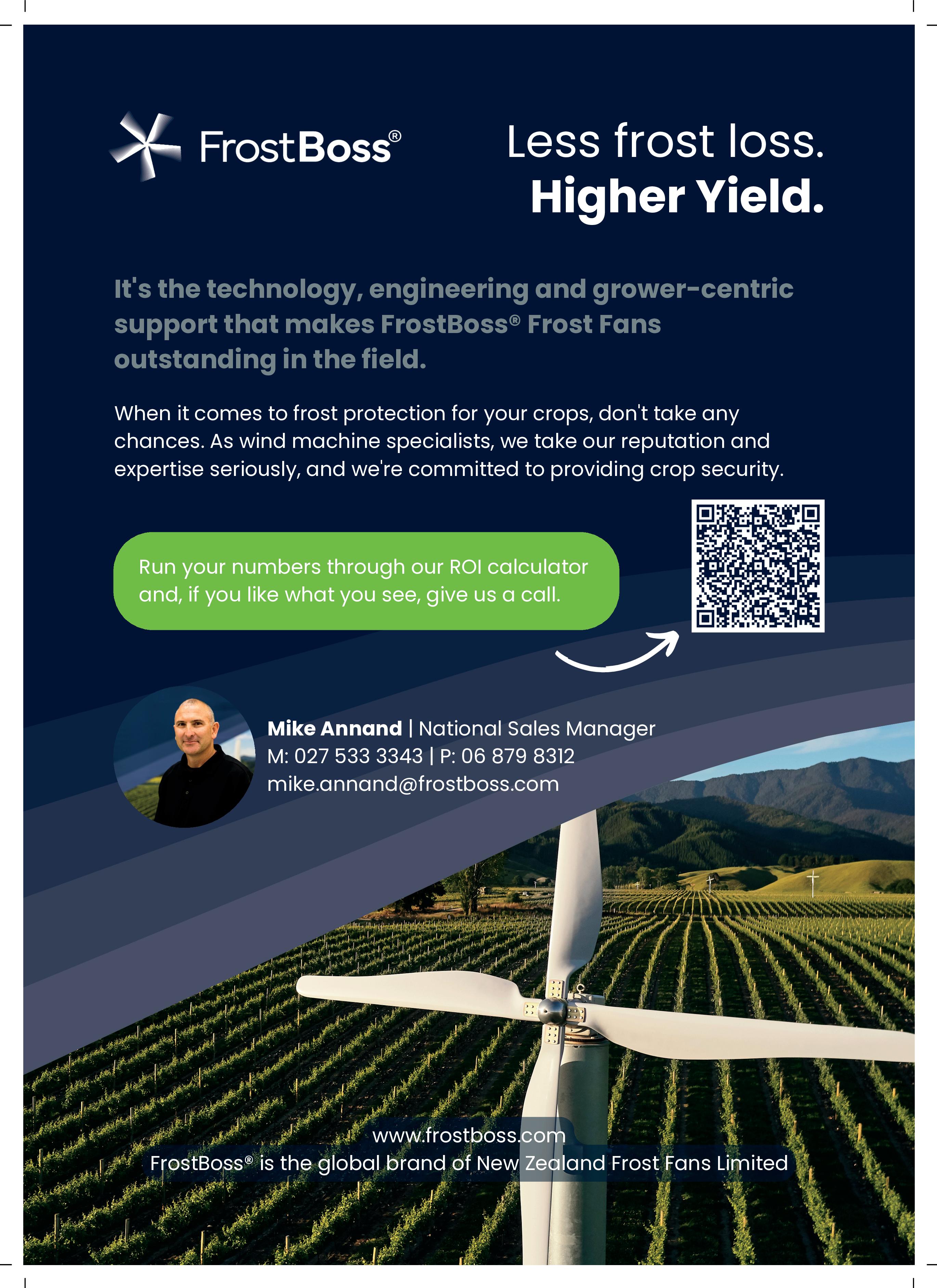

Pinot NZ 2025
Pinot people unite
Women in Wine
Emma Taylor
Bubbling Up Vilaura sparkles



Pinot NZ 2025
Pinot people unite
Women in Wine
Emma Taylor
Bubbling Up Vilaura sparkles
People, places, season, vines, wines and markets




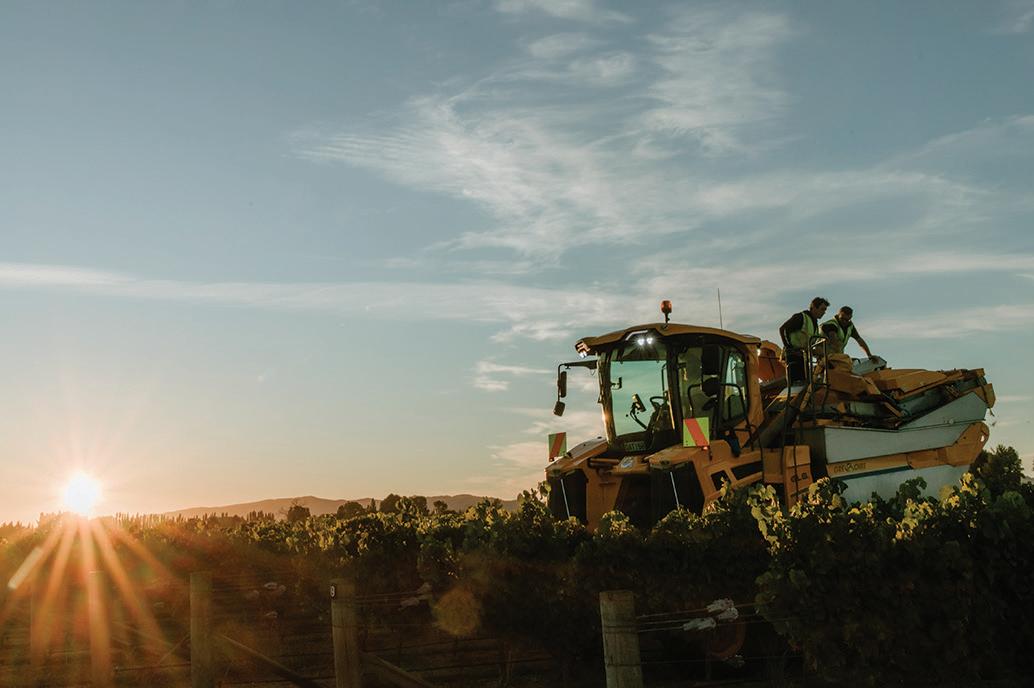


COVER PHOTO


New Zealand wine has a bright future, say grape growers Will and Jayne Grigg, from Marlborough’s Meadowbank Station. “The whole industry needs to work collectively to make sure that is so, though. We can’t take it for granted.”
Jim Tannock. Go to page 25
Editorial Sophie Preece
From the Chair Fabian Yukich
Women in Wine Emma Taylor
The Profile Sparkling success
Growing Legacy Seifried Wines Advocacy Proposed Gene Technology Bill
Pinot Noir NZ 2025
Pinot Noir New Zealand 2025 brought together local and international Pinot lovers to discuss quality and style evolution, and a deepening expression of regional and subregional identities. It was a timely reminder of how far our Pinot Noir has come and the opportunities that lie ahead.
Regenerative Viticulture
Regenerative agriculture advocates Dr Jamie Goode and Mimi Casteel discussed the risks of monocultural farming, particularly in soil degradation, at Pinot Noir New Zealand 2025. Given the accelerating impacts of climate change, Mimi stressed the urgency of collective action: “We don’t have the luxury of this being a ‘one farm’ solution.”
Vintage 2025
Nature has little regard for supply and demand equations, and there were abundant, high-quality crops for many around the country this harvest. While the industry grapples with slowing markets, excess supply and uncertainty around trade barriers, vintage 2025 kicked off with perfect parcels of delicious fruit.
EDITOR Sophie Preece
sophie@sophiepreece.co.nz
CORRESPONDENTS
North Island
Joelle Thomson
Emma Jenkins MW
South Island
Claire Finlayson
Stephanie McIntyre
Joanna Grigg
ADVERTISING
Upper North Island: Stephen Pollard
stephenp@ruralnews.co.nz
Ph: 021 963 166
Central & Lower North Island: Lisa Wise lisaw@ruralnews.co.nz
Ph: 027 369 9218
South Island:
Kaye Sutherland kayes@ruralnews.co.nz
Ph: 021 221 1994
CIRCULATION & SUBSCRIPTIONS
Sarah Adams saraha@nzwine.com 027 700 0740
New Zealand Winegrowers PO Box 90 276, Auckland Mail Centre, New Zealand
PUBLISHING & PRE-PRESS
Rural News Group
PO Box 331100, Takapuna, Auckland 0740
Ph: 09 307 0399
Location: Top Floor, 29 Northcroft Street, Takapuna, Auckland 0622
Publisher: Brian Hight
Managing Editor: Adam Fricker
Production: Rebecca Williams, David Ferguson
Published by Rural News Group Ltd under authority of New Zealand Winegrowers Inc. Unless directly attributed, opinions expressed in the magazine are not necessarily those of Rural News Group and/or its directors or management, New Zealand Winegrowers Inc. or its constituent organisations. Published every second month. One free copy is mailed to every member of New Zealand Winegrowers Inc, New Zealand Society of Viticulture & Oenology and the New Zealand Vine Improvement Group, and to such other persons or organisations as directed by the owners, with provision for additional copies and other recipients to be on a subscription.
ISSN 1174-5223

New Zealand’s wine industry is facing “significant challenges”, writes New Zealand Winegrowers Board Chair Fabian Yukich this month (page 6), reflecting on rising costs and eroding profitability, while sluggish domestic and export sales are holding up the movement of wine. Add high wine inventories, a big harvest, and the threat of tariffs, and it’s something of a perfect storm.
On the other side of the scales, the 2025 season looks like a cracker in many regions (page 20), and New Zealand wine’s reputation remains strong, says Fabian. That’s borne out by the recent New Zealand Winegrowers (NZW) Brand Health Tracking webinar, showing New Zealand’s sustainability credentials, built over 30 years of Sustainable Winegrowing New Zealand, are invaluable currency in modern markets. NZW General Manager Brand Charlotte Read says New Zealand wine was “singled out” at the various presentations she attended at Prowein in March, “particularly for its value growth seen in many export markets around the world in a very tough market, as well as our strong reputation for our sustainability efforts”.
The brand of New Zealand wine was undoubtedly boosted by the wonderful Pinot Noir New Zealand 2025, held in Ōtautahi Christchurch in February, with an array of influential international visitors soaking up the extraordinary manaakitanga of the event, including Monique Fiso’s modern style hangi, steaming succulently in the grounds of the Christchurch Town Hall. Themes from te ao Māori – Tūrangawaewae, Kaikiakitanga, and Ā Mua – were used to guide an extraordinary event, anchored in Aotearoa, drawing glowing responses from international media who also travelled our wine regions (page 14). “I’ve returned to the UK feeling like a portal has been opened to your world-class Pinot Noir on a level that I could barely have dreamt of,” says British wine writer and presenter Olly Smith. “And that open portal has travelled home with me.” That’s a response worth raising a glass to!

Sophie Preece EDITOR

Emma Jenkins MW
New Zealand Pinot is at an exciting crossroads, Emma writes after Pinot Noir New Zealand 2025.

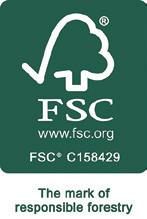

“The place, passionate producers, and everevolving styles captured the attention of international visitors.”
Go to page 14

Heidi Seifried-Houghton
Fifty years after Hermann and Agnes Seifried picked their first grapes in Nelson, their eldest daughter Heidi, who grew up in the vines, reflects on the enduring legacy of her parents’ “wild dream”.
Go to page 36

Joanna Grigg
Joanna is a Marlborough-based freelance journalist specialising in primary industries. In the lead up to the 2025 harvest she explored mechanical shaking for crop thinning.
Go to page 49
With over 20 years’ experience working with the wine industry throughout the New Zealand Pacific region, we understand what it takes to enhance productivity and decrease costs for your winery. We can help you make your vintage a success by:
• Controlling fermentation
• Providing temporary cooling for cellars or other critical functions
• Providing additional power when needed
We are on call 24 hours a day, seven days a week to serve you.


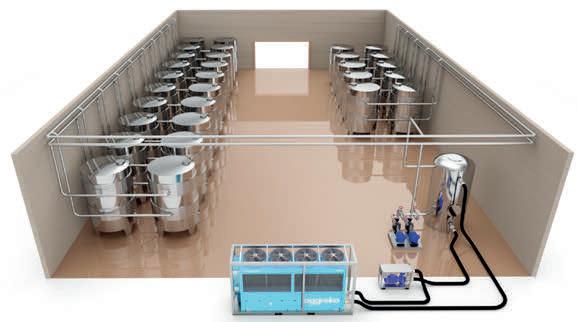


Members will be aware of the significant challenges facing vineyards and wineries (highlighted in our 2024 Annual Report). Rising costs have eroded profitability, while domestic and export sales slowed in 2024 due to tough economic conditions. Geopolitical shifts are adding further uncertainty, with the threat of protectionism in key markets.
Industry stocks are also high, despite the small crop of less than 400,000 tonnes last year. Large vintages in 2022 and 2023 (both exceeding 500,000 tonnes), exacerbated by slower sales in 2024, mean inventories remain higher than anticipated. Together these issues are contributing to an increasingly uncertain and unpredictable outlook.
Vintage 2025
Favourable weather has set the stage for a high-quality 2025 harvest. That is good news for the reputation of New Zealand wine and the long-term health of the sector. Over the past year, industry sales have equated to approximately 430,000 tonnes of grapes. A 2025 vintage below this level may reduce stock levels, while a higher yield could increase them unless sales rise. Importantly, I must emphasise that production levels are a matter for
each individual business to decide, as New Zealand Winegrowers (NZW) does not (and cannot) get involved in how much the industry chooses to produce each year.
New Zealand wine’s reputation remains strong
Despite the challenging times, market data confirms New Zealand wine maintains a strong consumer reputation based on quality, distinctive and sustainable wines. This data supports a positive long-term outlook, as it provides confidence our producers are well-positioned to capitalise on key trends in our major markets.
Current initiatives
NZW currently is investing in a range of initiatives designed to support members and the industry, including:
• The Pinot Noir New Zealand 2025 Conference, which brought key media and influencers to New Zealand. Our guests travelled the length and breadth of Aotearoa, revelling in a fully immersive Kiwi wine experience. The coverage from these visitors has been amazing and is growing by the day. Now we are starting to plan for the International Sauvignon Blanc Celebration 2027.
• We are in close dialogue with the
government, and our international colleagues, on the possibility of tariffs being imposed on exports to the United States. We will continue to provide updates to members as developments unfold.
• We are progressing discussions with the Ministry for Primary Industries to support New Zealand wines in the US, and are also exploring opportunities in new markets in Asia. Our team supported the New Zealand presence at Prowein in Germany, we will be attending Vinexpo Asia in Singapore, and have our China roadshow in May.
• Bragato Research Institute is busy in vineyards, the research winery, and in the labs, bringing to conclusion another year’s research work before reporting to members at this year’s Grape Days.
• We are about to release the Sustainability Report 2025, which celebrates the sustainability progress being made by growers and wineries. This is an important step in maintaining and growing access to key markets. We are anticipating a challenging and busy 2025. Best wishes for a successful vintage.

Fabian Yukich is Chair of New Zealand Winegrowers


1 6 2 7 3 8 4 9 5 10

B-Corp Certification is evidence that The Coterie practices protect, nurture and support its place and people, says Rhyan Wardman, Managing Director of the boutique winemaking facility in Marlborough. “By becoming certified, we have embraced a framework for continuous improvement and joined a global movement of businesses working to create a more sustainable future for all.” Lawson’s Dry Hills announced its B-Corp certification late last year, joining other Marlborough wine producers Tiraki and Deep Down, along with Felton Road in Central Otago.

Having 30% of Central Otago’s vineyard area certified organic is “a true testament to the passion and dedication of growers”, says Carolyn Murray, General Manager of the Central Otago Winegrowers Association. “Central Otago has earned its international reputation for consistently delivering beyond what you’d expect from a region of our size.” In 2009 the association set a target of 20% organic by 2020 and surpassed it by reaching 23%. That momentum has continued, so they partnered with Lincoln University for a comprehensive study on achieving 50% of planted area under organic certification by 2030. The study revealed challenges, including conversion costs and financial support, but highlighted Central Otago’s vibrant peer network, innovative spirit, and growing international market appeal as cornerstones of future success. By adopting practical, phased strategies and focusing on targeted research, the region is well-positioned to solidify its reputation as a global leader in organic, biodynamic and regenerative viticulture, the report says. It also underscored Central Otago’s role as a trailblazer in sustainable practices, with consumer influence identified as a powerful driver for future growth. Rosie Menzies, winemaker at organic producer Carrick, says every wine purchase directly impacts a vineyard somewhere. “We’d love to see consumers and wine professionals embrace land stewardship in their choices and reviews. It’s a fresh perspective on wine that could truly make a difference, reshaping how people value the connection between wine and the land.”
Te piko o te māhuri, tērā te tipu o te rākau; The way in which the young sapling is nurtured determines how the tree will grow. This whakatauki is at the heart of the 2025 Organic & Biodynamic Winegrowing Conference, and is exemplified by the Horticentre scholarship helping 13 young winemakers and viticulturists from around the country attend the conference in Marlborough. Tony Ivicevich, from the Horticentre Charitable Trust, says it is difficult and expensive to get New Zealand’s young and aspiring winegrowers to valuable conferences, “so it’s always a pleasure for the Horticentre Trust to assist them in their development this way”. Being selected as one of the scholarship recipients is a “huge privilege”, says Greystone Wines Assistant Winemaker Georgia Mehlhopt, who was the 2024 Tonnellerie de Mercurey Young Winemaker of the Year. “I’m really looking forward to hearing from the amazing speakers, learning plenty, and being even more inspired to continue driving change for the better.”

A “giant” of New Zealand’s wine industry was farewelled in February, with the passing of Peter Babich, aged 92. “Dad was a man of incredible vision, integrity, and passion for his family and craft,” says Babich Wines Chief Executive David Babich. “But it was his warm personality, tireless dedication, and genuine care for people that leaves the greatest legacy, both in our family and across the wine community.” Peter’s father Josip founded Babich Wines in 1916 and he joined the family winery in 1949, aged just 17. During his 70-year career he played a critical role in transforming the company into one of New Zealand’s leading wine producers, now exported to more than 60 markets around the world. A life-long commitment to Babich Wines and New Zealand’s viticulture and wine industry saw Peter become a Member of the Order of the British Empire (MBE) in 1989. In 1995 he was made a Fellow of the Wine Institute of New Zealand, and in 2015 he was inducted into the New Zealand Wine Hall of Fame. He served as an advocate for sustainable viticulture and was a firm believer in fostering strong relationships within the local and international wine community.
After 11 years tasting and blending New Zealand Sauvignon Blanc from his home in Ireland, talk show superstar Graham Norton got up close and personal for Marlborough’s 2025 vintage, joining Invivo Wines’ founders Tim Lightbourne and Rob Cameron in the Awatere Valley. Old school friends Tim and Rob have worked with Graham and his eponymous label since 2014, and in late March took him out to the vineyard to pick grapes and taste juice samples for their 12th vintage, before hosting Marlborough’s Mayor and local food producers at a winemaker’s lunch. Graham says he’s fussy about his wines, so it’s always been important to be part of the winemaking process. “It’s surreal thinking that our little collaboration together started out all those years ago with our New Zealand Sauvignon Blanc and is now all over the world with 10 wines and spirits. I’m amazed, and proud of it too.”
Rob says Graham has always been “hands-on” when it comes to blending each vintage, “but having him in the vineyard, picking grapes and experiencing the magic of Marlborough firsthand, makes this vintage extra special for all of us.”

Cloudy Bay welcomed 40 guests from global markets to Marlborough in February, for the release of its 40th vintage Sauvignon Blanc. “It’s a celebration of four decades of passion, innovation, and commitment,” says Wine Director Nikolai St George, noting the wine’s huge influence in shaping Cloudy Bay and the Marlborough region’s global reputation. “We’re thrilled to share this exceptional vintage with our guests as we look toward the future.”
Kat Mason, Communications Manager at Cloudy Bay Vineyards, says from “humble beginnings”, when winemakers David Hohnen and Kevin Judd launched Cloudy Bay in 1985, the brand has become a recognised leader in premium winemaking. “Our success is testament to the passion and dedication of everyone who has been a part of our journey.”
The visitors, including David Hohnen, took a deep dive into Cloudy Bay’s culture, with a multi-day educational and immersion experience, culminating in a celebration at the winery site on 28 February. It’s an “incredibly special milestone”, says Estate Director Yang Chen. “And we couldn’t be more thrilled to mark this momentous occasion.”


premium Marlborough wineries have found a home away from home in the region, with a shared cellar door in the heart of wine country. The WineShed has gathered a “cohort of dedicated producers”, says Novum co-owner and winemaker Rachel Jackson-Hoare. “For us it is a muchneeded missing touchpoint for our consumers, because we don’t have our own tasting room.” The WineShed, named for its red corrugated iron façade, was launched by chef Alain Hauswirth in February as an ideal neighbour for his restaurant The WineKitchen, which already champions small and extraordinary producers. “We get a lot of high-end customers who say, ‘where can I get this? Where can I go?”
Now they can walk next door and find 60 wines from family-owned Marlborough wine companies, including Novum, Corofin, The Wrekin, Settlement, Auntsfield, Te Whare Ra, Greywacke, Dog Point, Tiraki, Mahi, Rock Ferry, Two Rivers, Walnut Block, Zephyr, and Ashleigh Barrowman Wine. The WineShed manager Lara Boers says curated wine flights will include several producers, giving visitors insights into the quality and range of the region’s wine offering. Host Huw Williams sees himself as a conduit between the winemakers and the customer, telling the stories of some exceptional wines and the “phenomenal producers” who make them.
To have events added to our calendar contact sophie@sophiepreece.co.nz
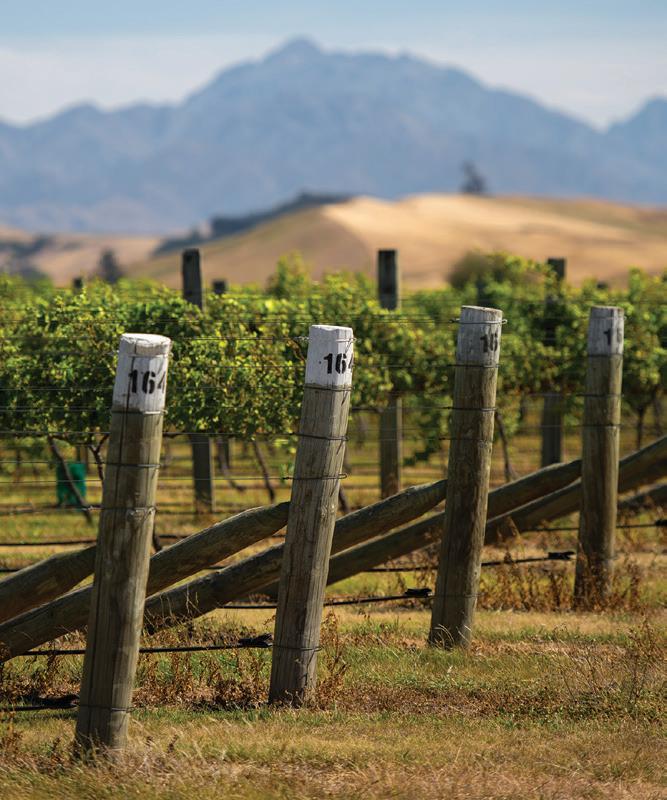
30 April – 26 June nzwine.com/members/sustainability/ biosecurity/swnz
All Sustainable Winegrowing New Zealand vineyard members will need to have a biosecurity plan in place by 30 June 2026. The New Zealand Winegrowers biosecurity team is holding workshops around the country between 30 April and 26 June this year to give vineyard owners tools and knowledge to develop a robust biosecurity plan tailored to their site. To see dates and read more about the requirements, go to page 44

Central Otago: 5 June
Marlborough: 10 June
Hawke’s Bay: 12 June nzwine.com/grape-days
Join Bragato Research Institute (BRI) at Grape Days 2025 for the latest grape and wine research. This year’s programme will delve into gene technology, the Roadmap to Net Zero, Next Generation Viticulture, plant protection, Pinot Noir and more. More information including the programme and tickets will be available at nzwine.com/grape-days.
9 June
mrc.org.nz/nzwc-scientific-researchconference
The New Zealand Wine Centre 2025 Scientific Research Conference, to be held at the Wine Centre in Blenheim this winter, will explore cutting-edge wine and viticulture science from a range of New Zealand research providers. Dr Stewart Field, from Nelson Marlborough Institute of Technology, says the event is a chance to delve into developments from established scientists and emerging PhD and master’s students. It’s also fertile ground for forming science partnerships. As an example, Dr Amanda Dupas de Matos, from the Food Experience and Sensory Testing (Feast) Laboratory, has been awarded more than $100,000 from the Massey-Lincoln Agriculture Industry Fund to explore the impact of thiols in white wines. The project, titled Realising the Potential of Thiols in White Wines: Sensory Consumer Responses and Chemical Characterisation, is a collaborative effort between Massey University, Lincoln University, and Bragato Research. Amanda says the idea was initiated in November 2023 at the New Zealand Wine Centre Scientific Research Conference, where Professor Paul Kilmartin from the University of Auckland connected her with Dr Leandro Dias Araujo from Lincoln, then Ngarita Warden from BRI. “After plenty of discussions, we are excited to see this research come to life.”

Organic & Biodynamic
Winegrowing Conference
16 -18 June
organicwineconference.com
The Organic & Biodynamic Winegrowing Conference brings together industry experts from around New Zealand and across the globe to examine topics including climate change, water ecology, biodiversity, soil health, biodynamics and regenerative viticulture. The 2025 event will
acknowledge the traditions of Matariki and the winter solstice, with themes of under the earth, above the ground, and into the sky - ki raro, ki runga, ki te rangi. Speakers include Joseph Brinkley, Director of Regenerative Organic Farming at Bonterra Organic Estates in the United States; Rajat Parr, renown organic winegrower in the United States; and Katia Nussbaum, who runs a regenerative organic winery in southern Tuscany with her husband Luigi. To read more go to page 13.
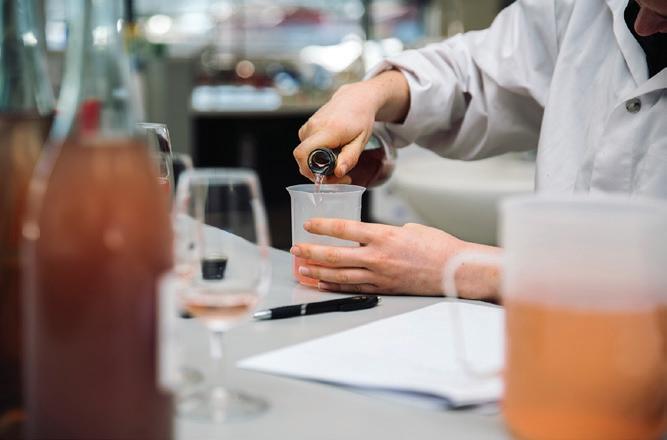
National
26 August
nzwine.com/en/initiativesevents/ youngwinemaker
The Tonnellerie de Mercurey Young Winemaker of the Year Competition champions emerging young winemakers in the New Zealand wine industry. It is open to young people working in all roles, from winemakers and assistant winemakers to cellar hands, cellar managers and lab staff. They are tested across a wide range of skills and knowledge, including blending, laboratory tests, viticultural knowledge, tasting analysis and market knowledge. Regional finals are on:
• 16 July, Marlborough
• 24 July, North Island
• 31 July, Central Otago
The winners of each local event competition will go on to compete in the National Final in Canterbury in August.
National
27 August
nzwine.com/en/initiativesevents/ youngvit
The Young Viticulturist of the Year
Competition celebrates its 20th year with the 2025 competitions, where up and coming talent, aged 30 years and under, will be tested on a mix of practical and theoretical tasks, including pruning,
netting, irrigation, machinery, pests and diseases, budgeting, nutrition, wine knowledge, irrigation, trellising and an interview, as well as the classic BioStart Hortisports race, a quiz round, and a speech at the awards dinner.
The regional events are on:
• 29 May, Marlborough
• 5 June, Hawke’s Bay
• 12 June, Auckland/Wairarapa - North Island Regional
• 26 June, North Canterbury - South Island Regional
• 3 July, Central Otago
Winners from those competitions will go on to the National Final at Greystone in North Canterbury on 27 August, with the winner announced at the New Zealand Wine 2025 Celebration Dinner the next evening.


New Zealand Wine 2025 28 August
nzwine.com/en/initiativesevents
An annual opportunity for the New Zealand wine industry to connect, learn, and celebrate achievements. Save the date for the third Wine Business Forum, to be held in Ōtautahi Christchurch, followed by the New Zealand Wine 2025 Celebration Dinner, where we will raise a glass to the NZW Fellows 2025, and announce the winners of Young Viticulturist and
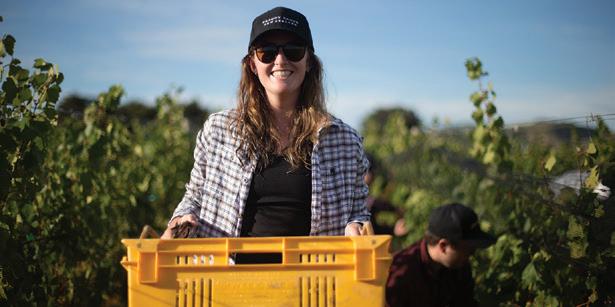
26-28 January 2026
iccws2026.nz
Registrations are open for the 11th International Cool Climate Wine Symposium, to be held in Ōtautahi Christchurch in January 2026. Speakers include Dr Patricia Skinkis, Professor & Viticulture Extension Specialist with the Oregon Wine Research Institute at Oregon State University in the United States, and Dr Kai Voss-Fels, Head of Department of Plant Breeding at Hochschule Geisenheim University in Germany. Presenters also include Anne Escalle, General Manager of Edmond de Rothschild Heritage Wines New Zealand, Nick Lane, Head Winemaker at Defined Wine Ltd in Kent, England, and Roy Urvieta, Winemaker at Catena
Experience the unparalleled craftsmanship that won us the 2024 Pride In Print Supreme Award — MCC Albany's expertise in creating bespoke, high-end labels like the Red Mill Rum has set a new standard in the industry. This dedication to excellence was further recognised when it went on to win the prestigious World Label Award, cementing our reputation for world-class label innovation.
Talk to MCC New Zealand where every product is labeled with care.
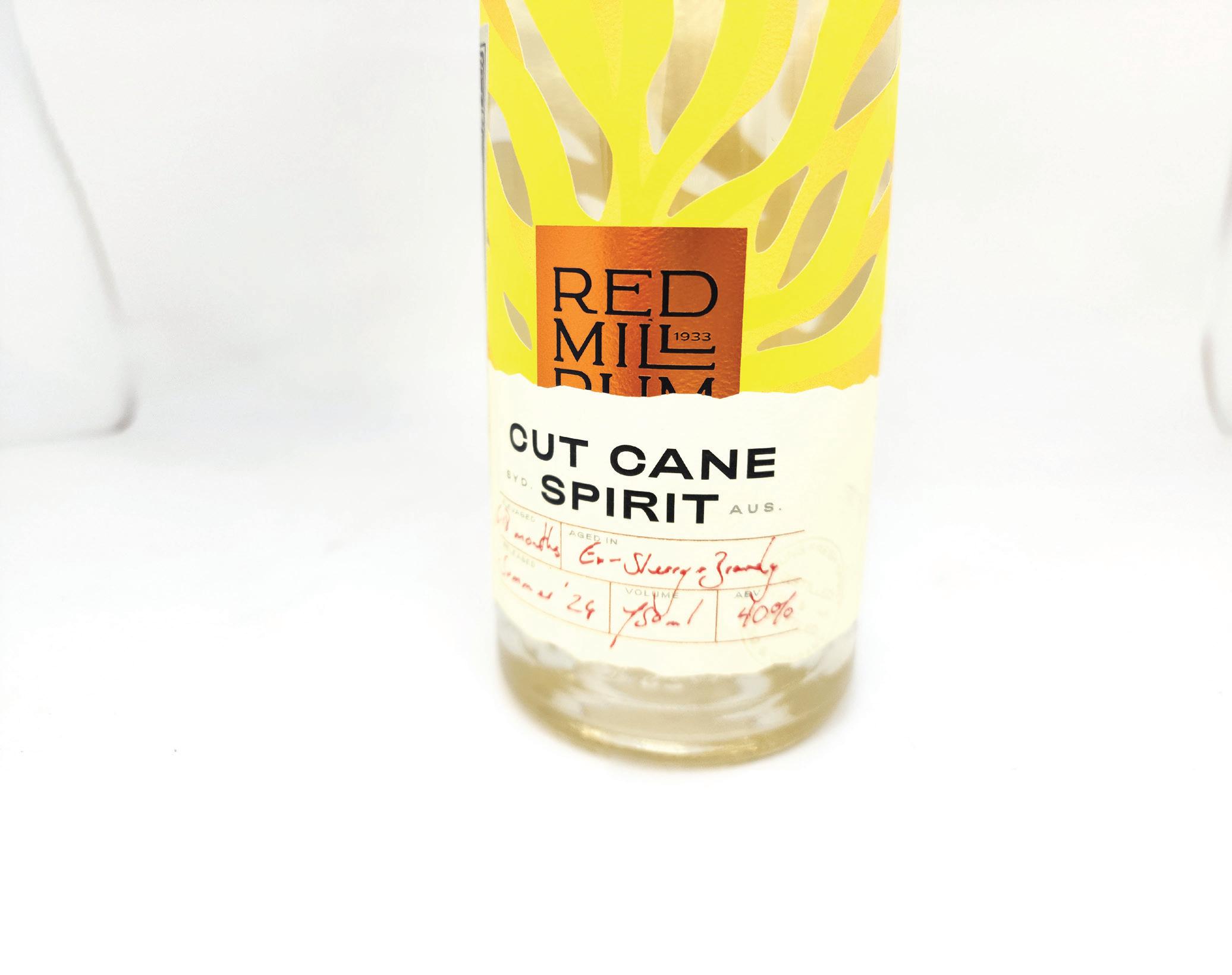

Charlotte

Every day since Pinot Noir New Zealand 2025 we’ve been treated to glowing enthusiastic content on social media channels, online, and in print. Our hosted international guests, who attended the three-day conference and visited nine of our diverse wine regions, have responded exactly as we hoped – amplifying our premium New Zealand wine message by telling a Pinot Noir story, while also sharing the delightful diversity of our varietals and contrasting regions. The Pinot Noir New Zealand conference is a valuable ‘hook’ for our media and trade guests to come at one time, but the true value lies in having our guests augment their New Zealand wine community experience across our regions. Thank you to everyone who played a role in helping these guests feel welcome in Aotearoa New Zealand, while advancing their understanding of what makes our wine Altogether Unique. Hear from some of our valued guests on page 14.
New Zealand Winegrowers (NZW) is already looking forward to the next hook for New Zealand Wine to shine in front of trade and media guests, with the International Sauvignon Blanc Celebration 2027. Watch this space as we reveal plans in coming months.
Charlotte Read is General Manager Brand at NZW
Sommit was one of the highlights for the sommelier cohort of our hosted international guests at Pinot Noir New Zealand 2025. The eighth Sommit, hosted in Gisborne, was designed to celebrate the lesserknown aspects of New Zealand wine, with particular emphasis on the facets that resonate with the sommelier community. A leading group of nine talented sommeliers secured their place on the Sommit 2025 programme via a competitive selection process. Each time we run Sommit, improvements and optimisations are made, and this year, for the first time, a place was made available for the New Zealand Sommelier of the Year recipient. Our nine ‘Sommiteers’, from New Zealand, Australia, China, Japan, the United Kingdom, Canada, and the United States, are now back

NZW returned to ProWein 2025 in March with a strong presence. More than 60 wineries were represented at the fair, offering attendees the chance to discover new wines and enjoy old favourites. The NZW Pavilion featured 17 producers showcasing 25 wine brands from six of the country’s key wine regions, from Waiheke Island to Central Otago. NZW was supported by New Zealand Trade and Enterprise, with experts on hand to explain the benefits of the United Kingdom and European Union Free Trade Agreements and how they could unlock opportunities for growth. In celebration of 30 years of SWNZ, a feature wall highlighted the initiative’s key focus areas. Exhibitors reported a noticeable downturn in key trade visitors who may have already attended the increasingly popular Wine Paris trade fair held the month prior. However, as ever, the New Zealand stand was in one of the busiest at the expo, reflecting strong interest in New Zealand’s wines.
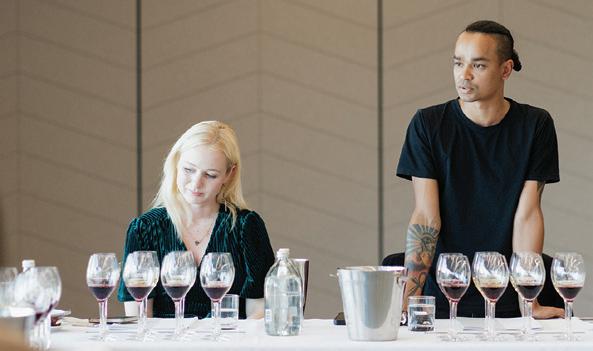
in market and preparing to host educational events for peers in their home cities, to pass on learnings and highlights from their visit to New Zealand. Bungo Matsunaga from Japan was quick to share his ‘trip of a lifetime’ and conducted a masterclass to the Japanese Sommeliers Association in March. Led by local hospitality experts Cameron Douglas MS and Stephen Wong MW, we have welcomed 123 Sommiteers from 18 countries since Sommit began in 2016. nzwine.com/members/brand/ education/sommit-2025
The slide deck and recording is now up on the NZW Members site from our recent webinar sharing the third year of IWSR New Zealand Wine brand health tracking among wine consumers in the US, UK, Australia and New Zealand. As we celebrate 30 years of Sustainable Winegrowing New Zealand (SWNZ), we delved into purchase drivers that involved sustainability considerations and also sought perspectives from our General Manager Sustainability, Dr Edwin Massey, on how developing sustainability credentials can secure your route to market, as many channel gatekeepers are now requiring them.
We are looking forward to hosting our third NZW Wine Business Forum on 28 August, at Te Pae, Ōtautahi Christchurch, as part of the wider New Zealand Wine 2025 event. This is an opportunity to be inspired, learn and connect with fellow industry members, and tap into leading topics and trends in wine business, including how to connect with ‘Gen Z’ and subsequent younger generations, asking ourselves if are we embracing artificial intelligence enough, and navigating evolving lifestyles and taste preferences. The programme will once again treat members to leading local and international voices to challenge and entertain us. As we celebrate 30 years of SWNZ, we will also explore topics on sustainability and its importance to wine business.


Anika Willner is one of the organisers of the Organic & Biodynamic Winegrowing Conference, on in Marlborough from 16-18 June. The winemaker says we can create the future we wish to see. “Small acts, when multiplied by many, can create transformative change.”
Speaker highlights include… Katia Nussbaum. I had the privilege of visiting Katia a few years ago at San Polino, the Montalcino estate she shares with her husband, Luigi. That visit profoundly changed my perspective on viticulture. Her insight into the delicate microbiome that constitutes a vineyard is truly remarkable. I am eager for her to delve deeper into the intricate relationships among soil health, fungi, and bacteria, and how these elements contribute to vine resilience, fostering a genuinely living vineyard. Katia is more than just a viticulturist or winemaker; she is a visionary in sustainability, an exceptional storyteller, and a champion for biodiversity.
Organic winegrowing is… crucial because it equips us with the necessary tools to reverse ecological damage, bring health back to our wine, and empowers us to effectively combat climate change from our own backyard.
My route to organics… began when I became Coal Pit’s winemaker in 2018. The vineyard was in a state of ecological imbalance. My goal was to repair fractured cycles, restore the vineyard’s functional ecosystem, and rekindle a connection to the land that had been lost over time. The first and most important step involved discontinuing the use of conventional systemic sprays. Following that, I focused on enhancing biodiversity within the vineyard. With the land’s potential gradually re-emerging, we saw a significant and direct improvement in the quality of the fruit over time. We became fully certified organic under BioGro in 2023 for both the winery and vineyard.
The future of winegrowing… lies in a commitment to sustainability that extends beyond the vineyard itself. For any vineyard to thrive for generations, it is crucial that every organism within the surrounding ecosystem also thrives.


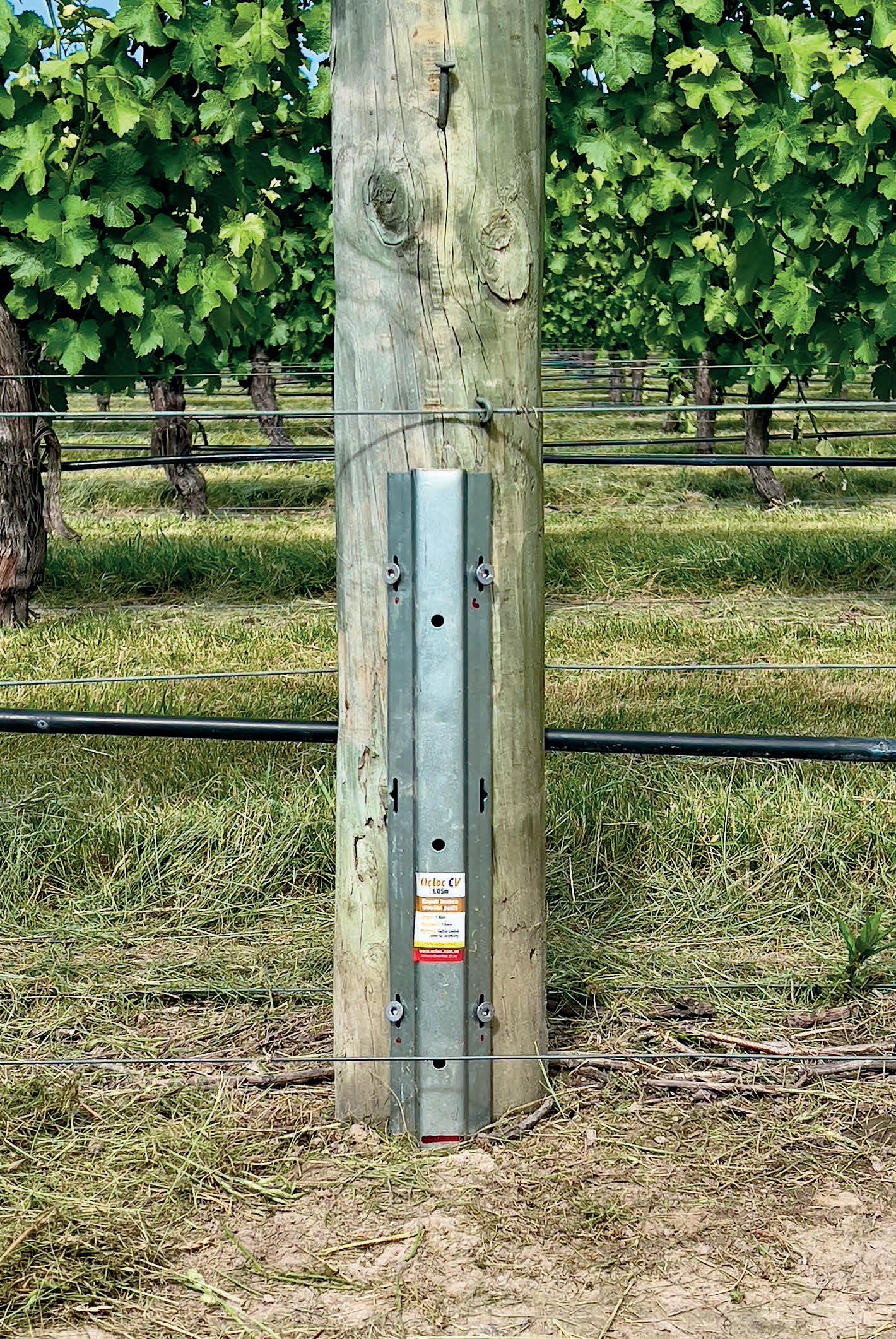

Ocloc V is an inexpensive fix for broken wooden posts
Keeps existing posts in the ground acting as a secure repair
Single pass repair, no wire removal required
Pinot Noir New Zealand 2025 brought together local and international Pinot lovers to celebrate New Zealand’s flagship red variety. The three days of plenary sessions and tastings were a platform for discussions about quality and style evolution, as well as the deepening expression of regional and subregional identities.
EMMA JENKINS MW shares some of the takeaways from international guests, following their immersion into New Zealand Pinot Noir.
Pinot Noir New Zealand 2025 was a timely reminder of how far our Pinot Noir has come and the opportunities that lie ahead. A common sentiment among international guests who attended the event in Ōtautahi Christchurch in February, and also visited New Zealand wine regions, was the shift towards greater finesse, balance, and expressiveness. United Kingdom writer and speaker Dr Jamie Goode was struck by how the wines have developed since his last visit in 2019. “Pinot now seems to be more nuanced,” he observed. “It’s my impression that winemaking is a little looser, in a good way – free of technical obsession that can lead many of the wines into the same sort of flavour space.”
International consultant Madeleine Stenwreth MW also noticed this movement. “When I first started communicating about New Zealand wines more than 10 years ago, I wasn’t really sure I understood what your Pinot Noir was about because it was so eager to impress – dark, extracted, lots of sweet oak. But producers today are so much more confident with their vineyards and don’t feel the need to push so hard to prove themselves. They are showing much more place, much more vineyard.”
United States-based Christina Pickard, Wine Enthusiast’s New Zealand reviewer, agrees. “Going into the conference, I thought I had a good grip on the Pinot scene, but it turns out, like most things in life, I was only scratching the surface,” she laughs. “The multitude of in-depth tastings demonstrated how far your Pinot has come in a relatively short time. Across the board

wines were balanced, made with intent and with a sense of place, helping me to gain a much deeper understanding of subregionality.”
“The idea of being a custodian of the land isn’t just a nice concept in New Zealand, it’s a responsibility woven into the country’s cultural fabric. That kind of awareness changes the way you see wine.” Liinaa Berry
While the refinement in style was widely praised, some challenges remain. Christina noted some producers are still working to “wrangle tannins into submission”, while Canadian educator and writer Jacky Blisson MW commented that the pervasiveness of whole cluster fermentation could sometimes lead to wines with dominant herbal tannins or lacking individuality, though she too appreciated the increasing sophistication. “Like many Pinot-producing regions, there is a clear shift in style to greater restraint and finesse now. Less extraction, less heavy oaking, less jammy fruit – overall better balance and grace.”
Tūrangawaewae
Australian consultant sommelier Liinaa Berry felt that the deepening confidence amongst winemakers stood out as “leaning into regional and site-specific expressions rather than making wines to fit external expectations. There’s more transparency,
more tension, and a real refinement in oak and extraction. It was clear that winemakers are letting go of any pressure to emulate other regions and are instead embracing what their land naturally gives them.”
A topic of discussion at the Regional Road Trip tastings, where producers showcased both current and older vintages, was the ageability of New Zealand Pinot Noir. Singapore-based wine communicator and 67 Pall Mall Asia Head of Wine, Richard Hemming MW, emphasised that while New Zealand Pinot has gained significant respect internationally, there is an opportunity to further solidify its standing through the showcasing of mature vintages. “Capacity to age is a vital credibility factor on the global stage. Showing mature wine is one way to really turn the heads of Pinot lovers because there is already so much competition for good young Pinot.” Richard pointed out that most New Zealand Pinot Noirs available internationally are young, while Burgundy and other leading Pinot regions have established reputations for longevity. Making more aged wines available could help position New Zealand Pinot more favourably in the global market.
He Tangata
Beyond the wines themselves, our people and community were seen as a defining strength. UK wine writer and presenter Olly Smith was particularly taken by the way Māori culture was interwoven with winemaking stories, reinforcing a deep sense of connection to the land. Olly described his experience at the event as transformative, leaving him with a profound appreciation for the people behind the wines. “Absolutely inspiring,” he enthused. “The concept of whenua felt like
EMMA JENKINS MW
Regenerative agriculture is gaining traction worldwide, and New Zealand wine producers are increasingly embracing its principles. At Pinot Noir New Zealand 2025, two leading experts in the field – United Kingdom-based plant biologist and author Dr Jamie Goode, and Hope Well farmer and no-till advocate, Mimi Casteel – delivered compelling presentations on the weaknesses of monocultural farming, particularly in soil degradation.
Regenerative viticulture includes practices like cover cropping, composting, and no or minimal tillage, in order to enhance soil health, sequester carbon, reduce chemical inputs and boost biodiversity and resilience.
Speaking on day two of the conference – themed ‘Caring for Our Place, Kaitiakitanga’ – Jamie noted that ‘sustainability’ can be meaningless for consumers, and that organic practices, while beneficial, can have limitations in some viticultural systems, including heavy use of copper spraying to combat downy mildew in many European vineyards. Regenerative farming offers greater flexibility and practicality, “allowing people to do things the right way for their land”, such as integrating trees or animals into vineyard ecosystems, or using the “very promising” technology of CRISPR, a precise gene-editing tool that can develop disease- and drought-resistant grapevines without introducing foreign DNA.

Jamie emphasised that local solutions are best. Reflecting on his pre-conference visits to North Canterbury and Central Otago, he highlighted promising regenerative initiatives such as permanent cover crops at Pyramid Valley, highfruiting wires at Greystone (enabling yearround grazing), and subsurface mid-row irrigation at Felton Road (to enhance soil moisture). “There’s been a lot of progress with organics and biodynamics that have helped soil health improve,” he remarked. “The next stage in many vineyards is building on this by increasing biodiversity and reducing soil disturbance... there’s a lot of shared learning to be done to identify local solutions.”
The spirit of shared learning was a central theme in Mimi Casteel’s thoughtful and personal talk. Having grown up at her parents’ pioneering Oregon winery, Bethel Heights, Mimi combined her background in forest ecology, botany and systems biology to establish her own 80-acre farm nearby – her “vineyard and living laboratory”.
With neighbours initially telling her she was crazy, she said the soon-thriving vineyard began telling another story, drawing curiosity rather than scepticism. This “across-the-fences” approach is one Mimi argues is key to regenerative viticulture, which should be a network of interconnected systems rather than isolated efforts.
Mimi outlined the importance of soil’s water-holding capacity in energy storage, buffering, and rainfall absorption, and introduced the concepts of holons (entities that function as both independent units and parts of a larger whole) and flow systems, such as root networks and rivers.
Given the accelerating impacts of climate change, Mimi stressed the urgency of collective action: “We don’t have the luxury of this being a ‘one farm’ solution. We don’t have time, but we do have agency.”

Read more about regenerative viticulture, including from Jamie and Mimi, later this year.


an invitation and an empowering binding to the place where we come from, the place we belong to, the place where we can stand. The wines I tasted lit me up with this.”
Madeleine agreed, with a caveat: “It is beautiful and respectful, giving an understanding of New Zealand, but take care you don’t lose the wine message; the focus on the hard work that has been done in the vineyards and wineries.”
Jacky encouraged winemakers to move away from overly technical descriptions when communicating with consumers and the trade. “The soils and climate, the sustainability commitments, the threading in of Māori concepts like turangawaewae are all essential parts of what makes New Zealand wine unique,” she says. “But what truly brings all of the above to life is the people behind the wines.”
“I’ve returned to the UK feeling like a portal has been opened to your world-class Pinot Noir on a level that I could barely have dreamt of… and that open portal has travelled home with me.”
Kaitiakitanga
“Living wine was a great focus,” Olly says. “It’s something to shout about as we face the climate emergency together and try to persuade our collective audiences that wholesome investment in the wine they choose to drink is truly priceless.”
Liinaa found Jamie’s regenerative viticulture presentation (page 15) particularly impactful, with the ideas seen in practice in vineyards she visited afterward. “Seeing firsthand how growers are moving from sustainability toward true regeneration—prioritising soil health, biodiversity, and resilience—made me realise that New Zealand isn’t just adapting to change, but actively shaping the future of winegrowing.” Being a custodian of the land “isn’t just a nice concept in New Zealand”, she says. “It’s a responsibility woven into the country’s cultural fabric. That kind of awareness changes the way you see wine.”
Despite the energy of the conference, Blisson pointed out a slightly disheartening contradiction. “The enthusiasm of the Pinot producers at the conference was

palpable and very exciting to witness. So much talent, potential, and time invested to promote Pinot; yet there remains a question mark over its future plantings and expansion.”
Keynote speaker Eric Asimov, of The New York Times, highlighted the lack of visibility of New Zealand Pinot Noir in key markets like the US. In his presentation, Eric said that while he believed in the potential of New Zealand Pinot Noir, the wines remain hard to find on shelves and wine lists. “Potential and possibility don’t create awareness. New Zealand needs some charismatic importers and distributors to champion these wines.”
New Zealand Pinot Noir has never been more compelling and reflective of place. There is a growing recognition of their age-worthiness, our unique culture and terroir and the importance of sustainability in shaping the future of New Zealand viticulture. However, challenges remain in ensuring these wines are accessible and properly championed in global markets.
New Zealand Pinot Noir is at an exciting crossroads. The place, passionate producers, and ever-evolving styles captured the attention of international visitors, and these same ingredients will captivate wine lovers worldwide – so long as the world gets a chance to do so. Events such as Pinot Noir New Zealand 2025 are an important part of making that happen. “Before the conference, I saw New Zealand Pinot as a category with potential, still finding its unique voice,” Liinaa says. “Afterwards, I see it as something far more significant, not just evolving stylistically, but part of a much larger, more meaningful movement. New Zealand is redefining what wine can and should be in a changing world.”
Olly says he came into it as a fan, “and left with my heart in your hands”. He has long bought, recommended, shared and enjoyed New Zealand Pinot Noir, and has visited “this great-spirited country” several times, he says. “I’ve returned to the UK feeling like a portal has been opened to your world-class Pinot Noir on a level that I could barely have dreamt of... and that open portal has travelled home with me.”

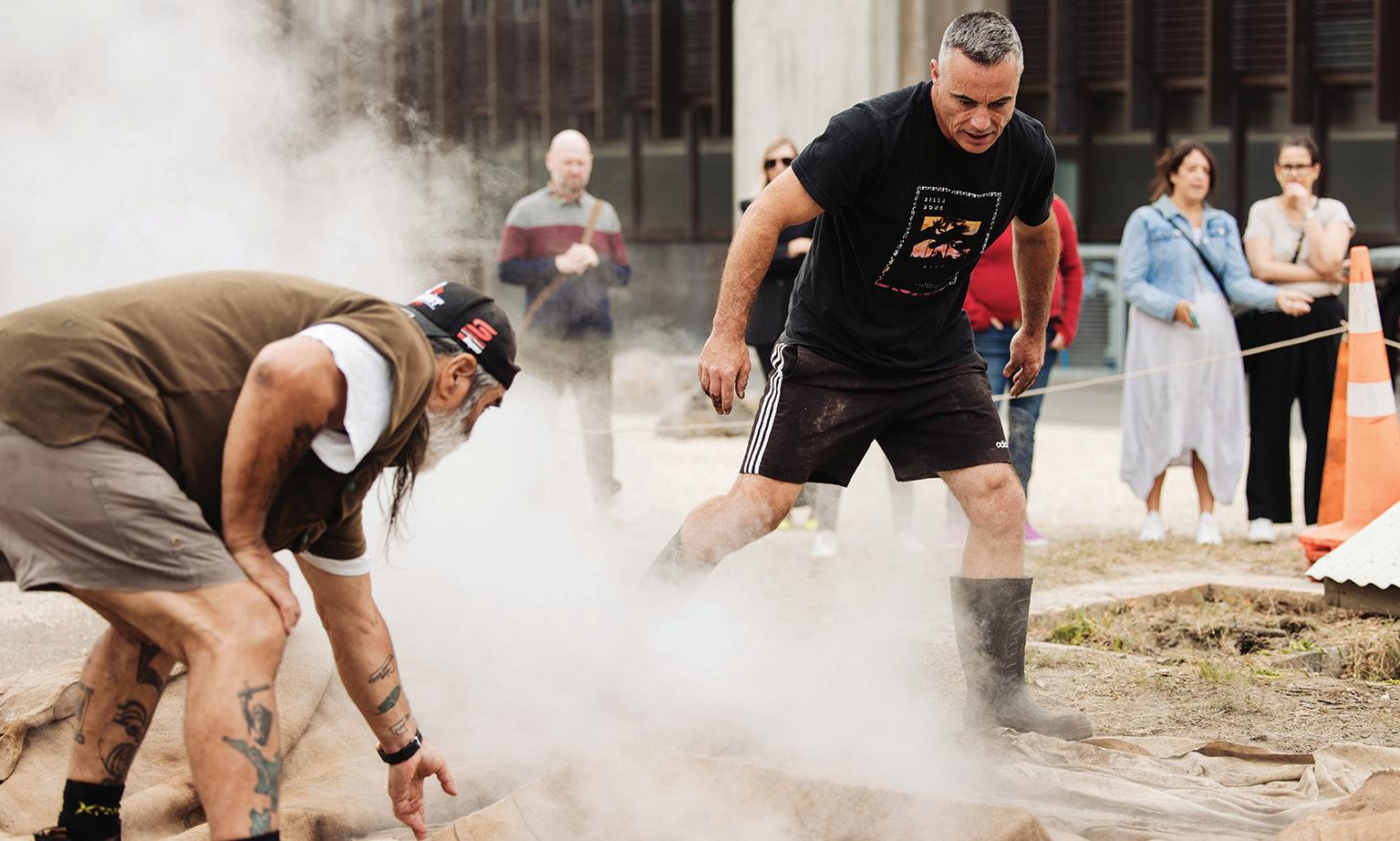
SOPHIE PREECE
When Dan Sims launched Pinot Palooza in 2012, he was well aware of the narrative that young people were eschewing wine and the industry was on the verge of collapse. “Something that sounds a little bit familiar today,” he says 13 years later, speaking at Pinot Noir New Zealand 2025, a day after 400 people, many of them young, paid to attend Pinot Palooza in Christchurch.
Dan, who is now Chair of Wine Victoria but was not speaking in that capacity, recalled being a young sommelier “pumped” to share the wine world with his peers, while seeing a generation of wine drinkers dismissed for not being serious enough, not knowing enough, not liking the right wines, or daring to ask for the likes of biodynamic certification or natural wines. Thankfully things have changed, he
said, while nonetheless sharing advice for those fearful the industry cannot attract a younger customer base. “The fact is young people are into wine. They are just not interested in the people who are telling them that they aren’t.”
Over the past three years more than 35,000 people have attended Pinot Palooza events in Australia, with audiences largely aged under 45, looking for experiences and fun, interested in stories of place and people, and drinking less but spending more, Dan said. “And they want a feeling of inclusivity not exclusivity.”
New Zealand “showed up in force” at the first Pinot Palooza in 2012. “As a young sommelier with a room full of his wine heroes, that was pretty amazing” he said, still “incredibly grateful” that Kiwi producers “took a punt”. Last year (after a four-year Covid hiatus) New Zealand was the top region by wine sales, followed by Tasmania then the Adelaide Hills. “And at the same time we clutch our pearls and say, ‘young people are not into wine; they are not educated... We don’t need to educate. We need to empower.”
That includes a reduced fixation on points and growing awareness of the power of occasions. “Critical assessment of wine is important, but it never speaks to how it integrates into anyone’s life,” Dan said. “For me the right wine for the right occasion is more important than the right pointed wine.”
Sommeliers hold a great deal of sway, with Melbourne alone holding between 70,000 and 80,000 restaurant seats. With a “hyper conservative” calculation of 5% having a sommelier or wine programme that’s interaction with close to 4,000 people per service twice a day, per week, per month, per year, he said. “That’s some seriously underestimated influence and consumer intel... especially when you consider that Australia remains the number one export market for New Zealand Pinot Noir.”
He remains as confident about the future of Pinot Noir as ever, because the audience is there. “We just need to embrace and support them and let the next generation of voices feel welcome. Be hospitable.”

From vine to vintage, we offer a suite of wine tests designed to help get your product to market safely and promptly. And the best bit? We’re based here in Blenheim, right in the heart of wine country. Talk to us today about how we can help with your wine testing needs.
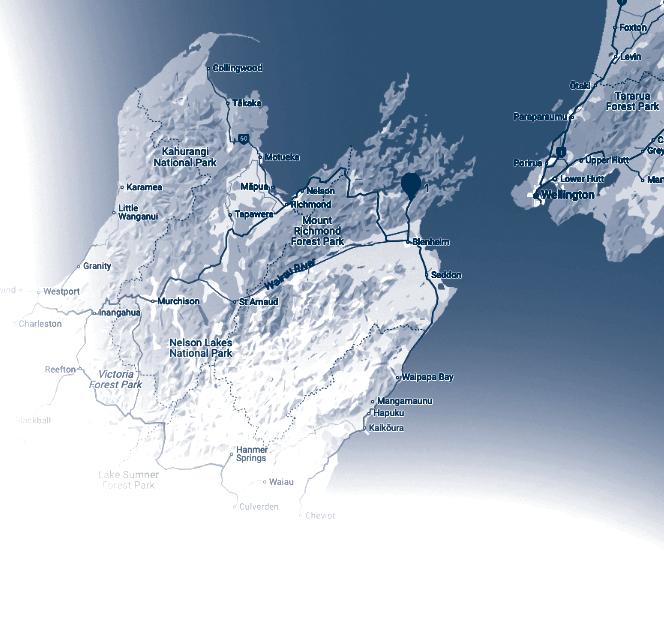
SOPHIE PREECE
The wine industry needs to stop “clinging to the debris of ‘fine wine’” and instead speak in a language future customers can relate to, Nigel Greening told attendees at Pinot Noir New Zealand 2025. “Instead of pontificating about minerality, texture and palate length, what’s wrong with deliciousness? Instead of ‘wait a decade’, what’s wrong with ‘it will be gorgeous tonight’?”
It’s not about “dumbing down” but binning pretension, says the owner of Central Otago fine wine producer Felton Road, urging industry to “abandon exclusivity and embrace inclusivity”, demystifying wine to broaden its appeal.
That includes ditching an obsession with ageing fine wine, he says. “Historically, winemaking often needed a long period for the harshness of the product to resolve, and so we came to revere the taste of old wine... Now, we can enjoy old wines, I have no problem with that, but it shouldn’t be a requirement.”
The notion of fine wine is feeling stale and tainted, as “an overpriced piece of snobbery largely created by ageing white and Asian males”, the self-described ageing white male says. “Add to that weather chaos caused by climate change, enormous social instability, the prospect of continued and worsening conflict and political anarchy. It is easy to see that there is a rough landscape ahead.”
Navigating the waters the industry finds itself “adrift” in will require looking ahead to a better future, rather than back at an alluring past, he says. That includes


building credibility as producers who are socially aware, successful, in demand, environmentally responsible, and good value. “The list of possible desirable hats is a long one, and being able to wear several undoubtedly can help build resilience. I suppose that’s one reason why Felton Road seems to be collecting certifications like they are going out of style. With consumers more and more suspicious of generalised puff, it’s a way to try and say, ‘we really mean it’.”
Felton Road is uncomfortable being seen as part of the tradition of fine wine, “which is tedious, snobby and pretentious”, Nigel says. “It seeks to create exclusivity and I’m through with that. We no longer want to be a surrogate Burgundy; wines that are about insane prices, unreliable quality and increasingly tenuous clinging to outdated ideas of terroir.”
While Felton Road is certified organic, biodynamic, a member of International Wineries For Climate Action, and B-Corp, it doesn’t necessarily fit easily in such groups. “These are hats we can
wear, rather than a broader banner to head out into the market under,” he says, describing the shortfalls of organics and biodynamics when it comes to climate change or social impact, for example. Instead he suggests the banner could align with Pascaline Lepeltier’s notion of Living Wine. “By that she means wines that are artisan made and grown; wines of integrity, individuality and interest... Wine grown in a way that respects life.” That requires a wine producer to value ethics as much as aesthetics, he adds. “This idea encompasses social, ethical, climate, environment, low impact, light touch, sensitivity, to create something that is both aspirational and inspirational. Not exclusive wine, but inclusive wine.”
A great wine is a conversation piece, Nigel says. “Not in its majesty or its scarcity, or its price, but in its unique interest and wonderful flavour. So, that’s my plan to weather this storm: Don’t throw hats away just because they aren’t perfect. Demystify, be inclusive not exclusive, and embrace ‘Living’ as the core of our communication.”


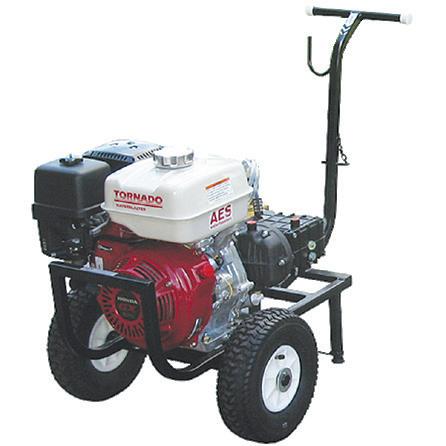

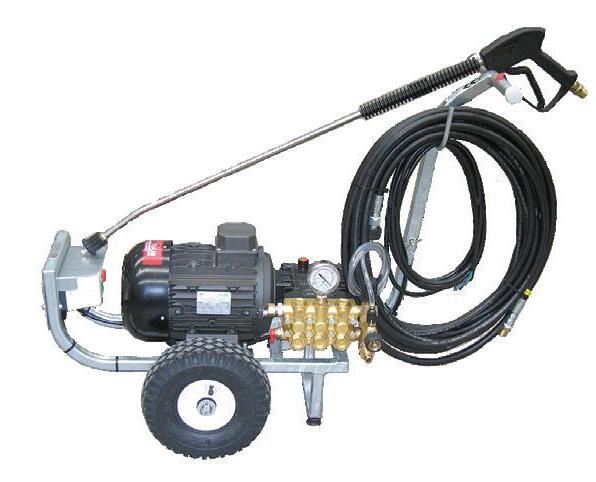


SOPHIE PREECE
Pinot Noir might be dwarfed by Sauvignon Blanc in New Zealand sales data, but in high end hospitality it’s king, says Master of Wine Stephen Wong. Speaking at Pinot Noir New Zealand 2025, Stephen ran through data from mid to premium Wellington restaurants in the eight weeks leading up to Christmas 2024, illustrating why Pinot Noir is the most important category for his clients, topping the pile in terms of total value, followed by sparkling wine, Chardonnay and Syrah, in that order.
Sauvignon and Pinot Gris, while export heavyweights, yield a quarter and fifth (respectively) of Pinot’s value in the restaurant he used as a case study. Wellington’s restaurants are feeling the effects of the economic downturn and growing unemployment, but Pinot has held relatively steady, with a slower sales decline than other varieties. “If people are drinking less, we are buffering that by making sure they drink better,” Stephen told attendees. “We haven’t found the ceiling yet for what diners are happy to pay for really good Pinot… We will reach that ceiling at some point, but we haven’t hit it yet.”
“We
haven’t found the ceiling yet for what diners are happy to pay for really good Pinot.”
Stephen Wong MW
Despite that relatively buoyant outlook from the capital, he said there was a lot of work to do overseas, with little to no recognition of “territorial brands”, a term that captures the synergy of a region and variety, such as Central Otago Pinot Noir or Martinborough Pinot Noir. On a recent project in the United Kingdom, he was “absolutely shocked” by the absence of representation of New Zealand wine on premium wine lists, with Sauvignon Blanc very rare, let alone Pinot Noir. “I think we have been away from the market as an industry, as producers and as ambassadors of New Zealand wine for too long.”

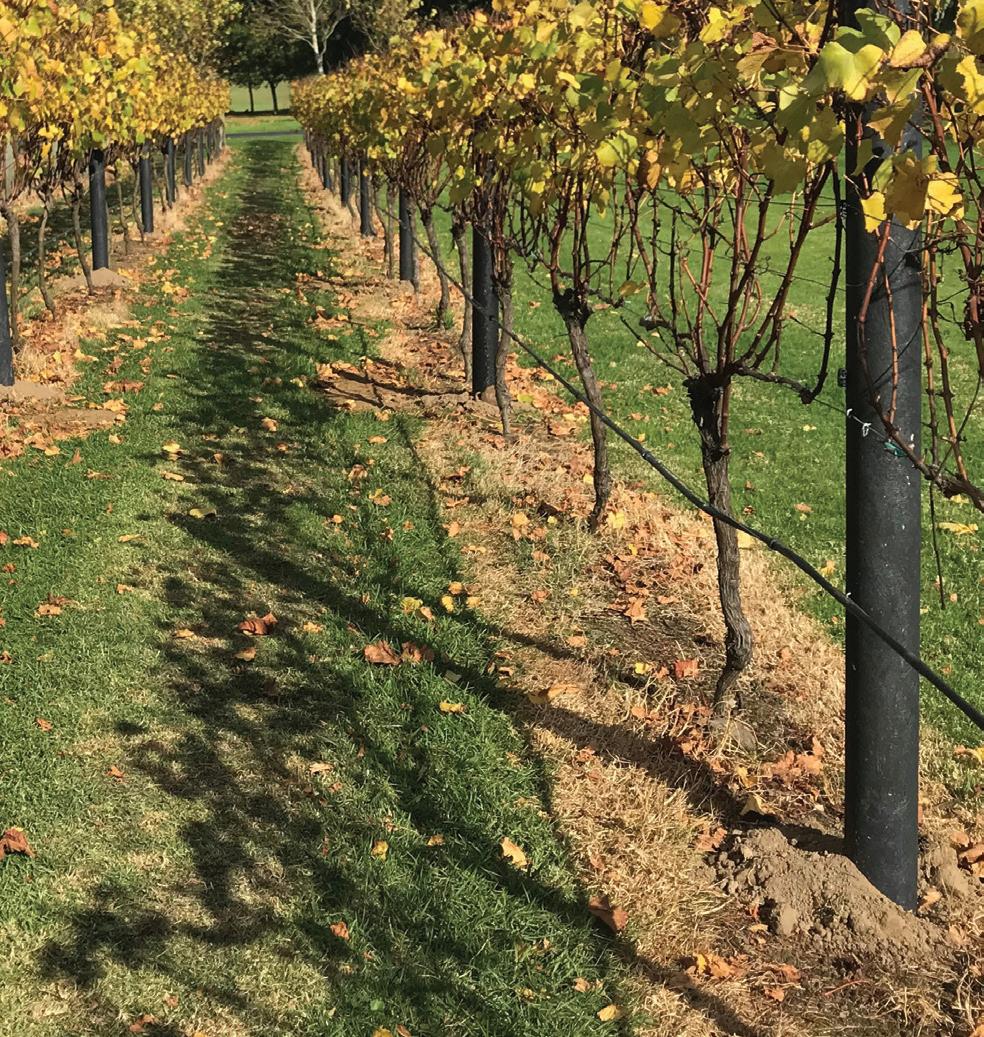
Purchase Rivulis industry leading dripline for your replacement programme and receive a pre-paid voucher* to recycle any brand of dripline at Future Post’s facility in Blenheim.
* Conditions apply. Please ask your local irrigation reseller for further details.
To find your local dealer contact Water Supply Products: Auckland: 09-916 0094 Christchurch: 03-348 1293 wsp@watersupply.co.nz www.watersupply.co.nz

Nature has little regard for supply and demand equations, and there were abundant, high-quality crops for many around the country this harvest. While the industry grapples with slowing markets, excess supply and uncertainty around trade barriers, SOPHIE PREECE hears that vintage 2025 kicked off with perfect parcels of delicious fruit.
Northland growers welcomed hot dry conditions in the lead up to vintage, with the season nearing completion in midMarch. A January rain-dump washed through with little impact, and was followed by optimum growing conditions, says Peter Jones of The Landing, who is also Chair of the Northern Winegrowers Association “We have been able to pick as we have wanted to, rather than being forced into it by weather”. The past few vintages have been struck with inclement conditions, and vines affected by 2023’s Cyclone Gabrielle were still recovering in the 2024 vintage, says Pete, delighted to reflect on this year’s excellent season.
Auckland winegrowers enjoyed the driest season since 1958, leading to a highquality harvest of good yields, says Michael Brajkovich of Kumeu River Wines. 1974 was hotter and drier than 2025, with this season’s temperatures a moderate 25C to 26C, and only one day at 28C, “so very good growing conditions”, he says. The season was “significantly earlier” that normal, with Auckland’s harvest finished by 7 March. And it’s carried “outstanding fruit”, Michael says. Chardonnay is the standout variety, with good sugar levels, and very good flavour. “Acidity is a little bit lower than usual, but still nice and bright.”
Waiheke Island
Barnett Bond has been growing grapes on Waiheke Island for 32 years, “and I cannot remember a more perfect growing season, from the result”, he says in mid-March.
“Basically, we’ve
had California since Christmas, every single day.”
Barnett Bond
“Basically, we’ve had California since Christmas, every single day. Blue skies, no clouds and no wind.” Big winds “blowing nonstop” in the lead up to Christmas gave some growers a scare, impacting development of hilltop vines, says Barnett. But the beautiful weather that followed has

more than made up for that bluster. “I think most Waiheke grape growers would be extremely pleased with the season from a point of view of ease of viticultural management, low disease pressure, and getting grapes perfectly ripe at the end of the season. That of course makes the winemakers extremely happy too.”
Gisborne growers also started harvest early, with Millton Vineyards picking about 10 days ahead of usual, kicking off in the first week of March. Annie Millton says rain between Christmas and New Year put some pressure on things, followed by “flicks” of southerlies throughout January. However, the grapes overall are looking good, thanks to the even conditions that followed. Yields are “great”, with good flowering and good set on all varieties, requiring plenty of fruit thinning on very heavy crops, she says. “And Chenin in particular. We thinned that twice.” A highlight this season has been “beautiful” Chardonnay fruit from a hillside exposed to good sunlight, she says. “It was a beautiful golden colour, with nice pH and nice sugar levels. Just perfect.” Speaking on 17 March, Annie says if the weather is kind (despite forecasts of a potential southerly shift) she expects to finish around the end of March.
Wairarapa
“Brilliant,” says Oraterra Winemaker Wilco Lam of the 2025 vintage. Speaking on a cool and rainy 19 March, the Wairarapa Winegrowers Association Chair says everyone he has spoken to in the region is cranking through harvest quickly, with fruit in excellent condition. The rain is a slight setback, but at 12C it’s unlikely to impact fruit, given its state of health. “It will get through it pretty well,” he says.
“It’s a pretty classic sort of Pinot year really.”
Wilco Lam
A beautiful flowering period gave the region good yields, and cool January conditions, followed by moderate warm days (“nothing crazy warm”), have resulted in “exceptional” Chardonnays and “juicy” bunches of Pinot Noir, tending to floral, pretty wines with uplifted aromatics. “It’s a pretty classic sort of Pinot year really.” With Pinot crops up by about 20%, and other varieties fruitful as well, wineries are looking full across the board, Wilco says. “Not many people have empty space left; it’s a jam-packed year.”
Wines.
Hawke’s Bay Craggy Range started its harvest a week earlier than ever before, with Chardonnay picking crews out from 8 February. Chief Winemaker Ben Tombs says there was an excellent and early flowering, setting good crop levels, followed by a very cool summer, without the high temperatures the region is used to. Canopies and flavour development “charged on” nonetheless, and the moderate temperatures and cool nights resulted in great acidity in Chardonnay, along with moderate alcohol. Speaking on 17 March, Ben says Craggy Range has just started on its Merlot harvest for Bordeaux blends, with Cabernet and Syrah a couple of weeks away. With good yields and high flavour concentration, morale is high within the team, he adds. “I’m really, really excited.”
Brent Linn of Wairiki Wines, who is Executive Officer of Hawke’s Bay Wine, says the region has been “absolutely blessed” in the run up to, and throughout, vintage 2025. The white varieties came in under “kind skies” with the benign weather looking to continue through the red harvest, he says on 18 March. “There is a lot of excitement amongst the Hawke’s Bay wine community of the potential of vintage 2025, from all of our subregions.” Like Ben, he is seeing balanced wines with “lovely acids and full brightness”, thanks to the lack of hot days. “It’s been ideal really for an orderly vintage.”
When it comes to market concerns, the region’s growers and wine companies are adaptable and will “pivot” to deal with challenges, Brent says. “What is really important is that we have full cellars and full tanks to meet the opportunities.”

Nelson
The Nelson harvest kicked off about a week behind “normal”, due to cooler January temperatures, says Chris Seifried of Seifried Estate. Speaking on 19 March, he says harvest of Chardonnay, Pinot Gris and Pinot Noir is well under way, while recent cool nights have further slowed ripening on Sauvignon Blanc. “But we are happy with how the crop is looking and will commence picking first Sauvignon Blanc blocks in the coming days.” The weather was “fantastic” during the first week of harvest, and a couple of small rain events on 18 and 19 March
New Zealand’s wine industry is facing an increasingly uncertain and unpredictable outlook, says New Zealand Winegrowers (NZW) Board Chair Fabian Yukich. Rising costs are eroding profitability, while domestic and export sales slowed in 2024 due to tough economic conditions he writes in this edition (page 6), noting that geopolitical shifts are adding further uncertainty, “with the threat of protectionism in key markets”.
Meanwhile, industry stocks remain high, despite the small crop of less than 400,000 tonnes last year. Large vintages in 2022 and 2023 (both above 500,000 tonnes), exacerbated by slower sales in 2024, mean
inventories remain higher than anticipated, Fabian says. “Together these issues are contributing to an increasingly uncertain and unpredictable outlook.”
However, a recent report by Impact Databank shows that New Zealand wines recorded growth in the United States in 2024, marking their 16th consecutive year of expansion. Among the top ten countries supplying wine to the US, New Zealand was the only nation to post a volume increase last year.
Ranit Librach, NZW’s US Market Manager, says New Zealand wine’s sustained growth in the market underscores its strong consumer demand and distinctive
were blown through with strong winds “helping to dry out the canopy quickly”, Chris says, noting that the weather forecast looks good leading into April. “Quality is above expectations with lovely flavours, nice acidity and clean fruit.” Yields are slightly above average “but certainly not huge”, he adds. “We’re very happy with the harvest progress and quality that we’re seeing in vintage 2025.”
This is the Seifried family’s 50th vintage, thanks to Hermann and Agnes Seifried pioneering wine production in the Nelson region in 1973, with their first vintage in 1976. Read more on page 36.
flavours. “With a continued focus on innovation, sustainability, and meeting evolving consumer preferences, New Zealand is poised to further strengthen its reputation as a leader in the global wine industry.”
NZW Chief Executive Philip Gregan says the industry is weathering tough times, but if you ask New Zealand wineries if they’re confident about the medium to long term future of New Zealand wine, “their answer will be an unequivocal ‘yes’”. If you ask them if times are challenging at the moment, “the answer, probably from most of them, will also be an unequivocal ‘yes’,” he adds. Those two things aren’t contradictory.”

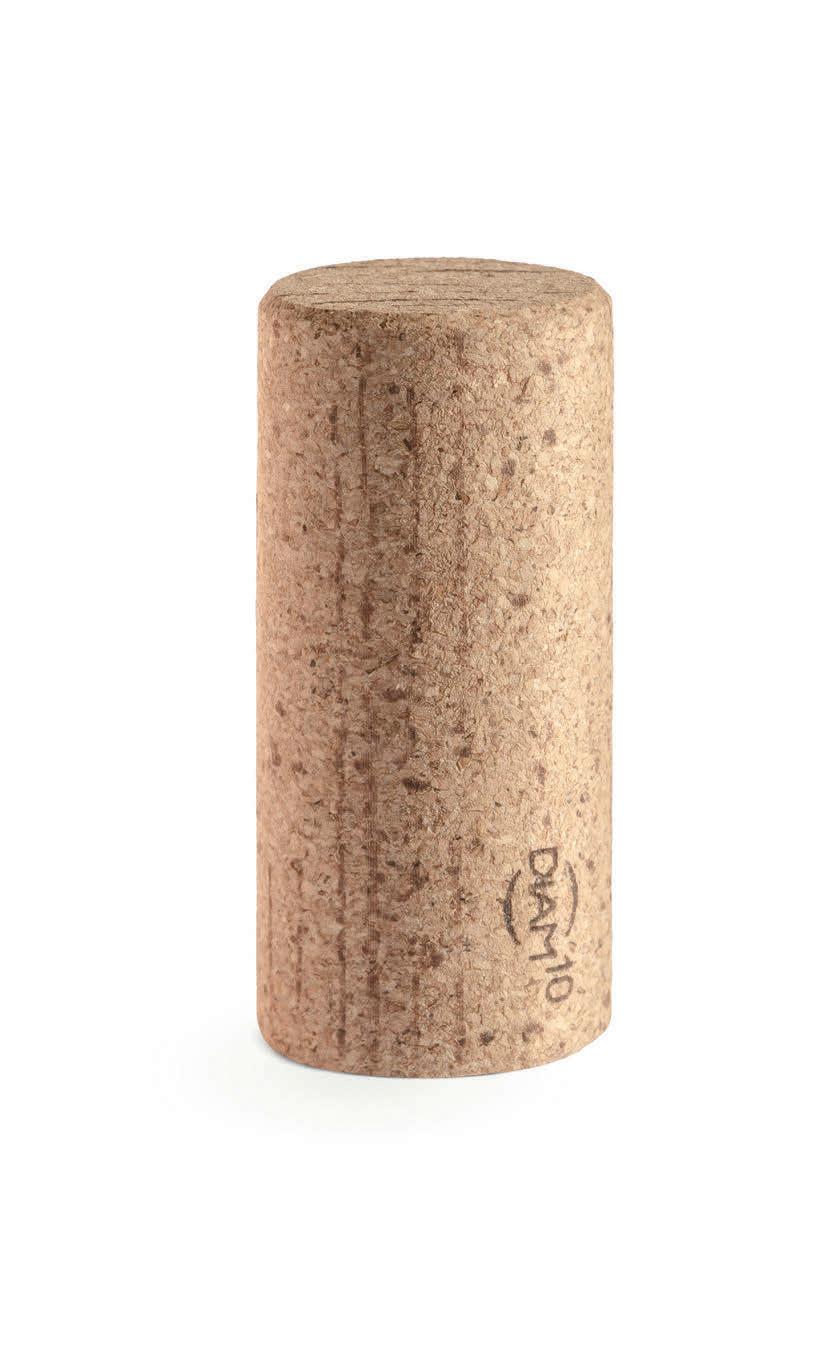

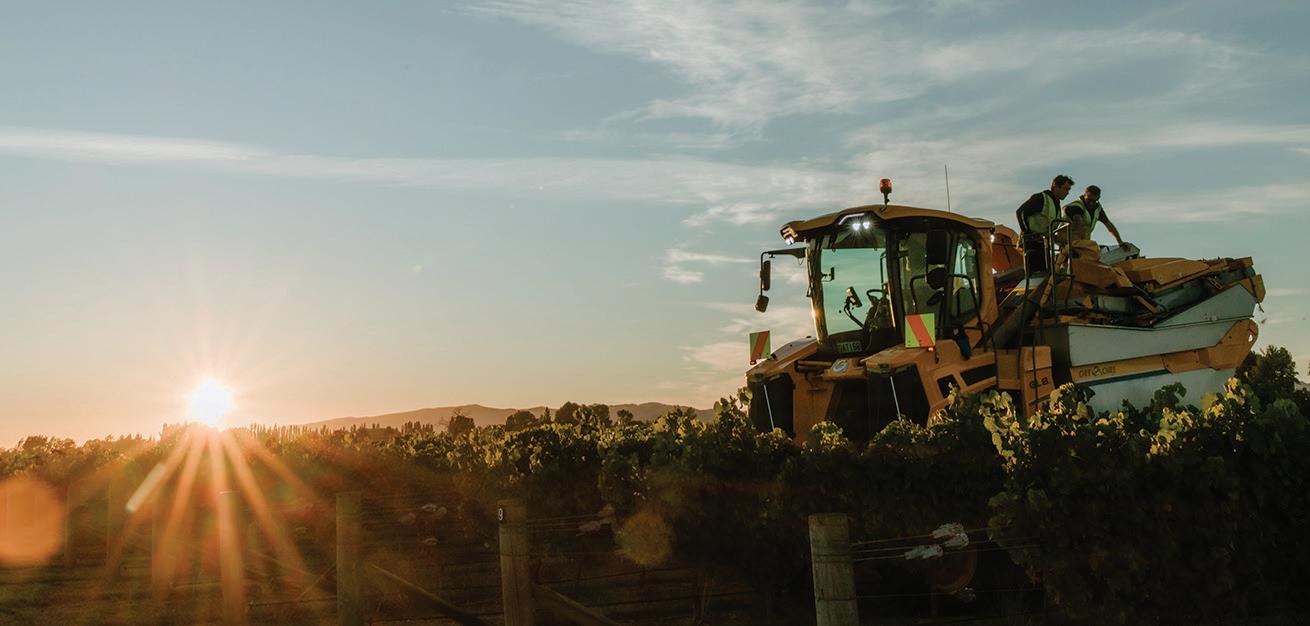
Marlborough has seen bumper flowering, potentially record-breaking yields, and a benign ripening season in the lead up to harvest 2025. With a decline in global wine demand and surplus wine in tanks and bottle, the industry has been busy managing inventory, yields and logistics.
Marlborough’s harvest started early and gently for Jules Taylor, with Pinot Gris, most of the Pinot Noir and all the hand pick Chardonnay in by 19 March, along with young blocks of first-crop Sauvignon Blanc. The winemaker then had to cool her heels before the Sauvignon onslaught. “The ‘go’ button has been pushed, but it’s been a very sedate and leisurely lead up.”
“The ‘go’ button has been pushed, but it’s been a very sedate and leisurely lead up.”
Jules Taylor
The region had excellent flowering and big yields this season, and despite judicious fruit thinning, Sauvignon blocks are taking time to ripen in cooler conditions, Jules says, expecting her Sauvignon harvest to ramp up the week of 24 March. “Last year everything was done and dusted in March because it was a lower crop and much warmer. We are just getting back to a more normal growing season this year.”
The cooler summer season allowed for good flavour development at relatively
low sugars in the Pinot Gris, which was “lovely”, says the winemaker and founder of Jules Taylor Wines. She expects Sauvignon to follow suit, thanks to autumnal nights keeping acids fresh, while the longer hang time delivers flavour concentration.
Thirty-one years after her first vintage in the industry, and 25 years after she started her eponymous label, Jules still relishes the energy and excitement of the Sauvignon harvest. “It’s the one chance we get,” she says. “We work in an industry where there are so many different parts – the growers, then the harvest and the winery. It’s a big thing for our industry and I just frigging love it.”
Managing the intake each year requires an abundance of crystal ball gazing “and it’s super hard to get it right”, Jules says. “You don’t know what’s going to happen in the market… If anything we are just trying to manage growers’ expectations, our own expectations, the markets’ expectations, and hope that what we do is going to turn out ok, with the help of Mother Nature sprinkled in.”
So far so good for the brand, which has not felt too much of a slowdown. “It’s hard out there but we have worked really closely with our distributors to maintain our price point, spend time in the market, and visit the people who are buying our wine and sharing it with their customers,” she says. “We really try to stay connected.” After a Covid-19 hiatus, they got back into travel in 2023, which has been vital to maintaining and building sales. “It’s expensive, with the New Zealand dollar
so weak against the United States… But I think it’s really important to stay in the face of those people who are selling your wines.” Making the wine is the easy bit, she says. “Getting someone to pour your wine rather than someone else’s, that’s hard, because there are so many wines to choose from.”
“The key is to get out there and get people to taste the wine. You just have to fight for it a bit more.”
Nick Entwistle
Nick Entwistle, Chief Winemaker at Rose Family Estate, says the biggest challenge in this impressive harvest could be finding space in wineries. By 20 March the family-owned company had been harvesting for a few weeks, with rosé, Chardonnay and Pinot Noir in, as well as some early blocks of Sauvignon Blanc. Nick has been happy with crop levels, but expects to see heavier loads as the harvest progresses down the valley.
A dry season meant fruit was in great condition in the lead up to rainfall on March 18 and 19, and disease risk was low leading into the Sauvignon push. Flavours are “really good” and brix of 21 to 21.5 are “bang on” for demand, “especially from the United Kingdom, where they want it lower in alcohol”, he says.
The industry at large has taken a “pragmatic approach” to the heavier yields
SOPHIE PREECE
Marlborough grape growers Will and Jayne Grigg are “cautiously optimistic” about the future of the region’s wine industry. “Everyone needs to play their part,” says Will, who grew up on Meadowbank Station and began to develop a vineyard on its river flats in 2001. “If we can delight our consumers with wines that give them positive memories each time they try them, it bodes well for the industry.”
The Griggs grow for five wineries, large and small, producing Sauvignon Blanc, Chardonnay, Pinot Noir and Pinot Gris, along with a little Gewürztraminer. Having 78% in Sauvignon Blanc and the rest in other varietals is a good balance, says Jayne, a winemaker who admits she’s “cherry picked” her favourites. “It makes it more interesting”. That broader portfolio is an advantage in the current market, Will says. “We found that after ‘08 as well; the varietals helped us through that period.”
An early budburst last year revealed bunch numbers 10% higher than average, leading him to shoot thin in November to drop crop potential and keep canopies open. That’s a cheaper time to control yield, he says, while acknowledging the risk of dropping crop
before flowering. “You hope you have it right.”
Beautiful weather from late November to mid-December meant most varieties had an excellent flowering. Bunch weight estimates in the new year indicated an abundant crop for Sauvignon Blanc and Pinot Gris, so they thinned using mechanical shaking (page 49) in the Sauvignon as well as bunch thinning in some blocks. In their heaviest blocks they did both, shaking and then removing bunches.
Speaking in early March, on the cusp of their first Pinot Gris pick, Will is “really comfortable” with crop levels. Yield management has made for an expensive season, he says, “but the work is paying off now, ripening is coming along nicely and the fruit is in amazing condition.”
Will notes that times are tough for many wineries and growers, with the volatility in demand after Covid, coupled with the vagaries of supply from seasonal conditions, making it difficult to balance supply and demand. Growers have faced a “huge escalation in costs” since 2017/18, but they have really “ramped up” in the last couple of years. The reduction in grape prices has exacerbated that pressure, so growers are “definitely feeling the squeeze”, he says.
Marlborough must be nearing “peak production”, Will adds, noting that while

more developments are coming on stream, a number of old vineyard blocks are being pulled out. The likelihood or timing of replanting will depend on demand, and “whether they have a market for their fruit or not”. For those who do redevelop, there’s opportunity to future-proof for increased efficiencies and longevity, with the likes of subsurface irrigation, better pruning techniques and technological advances, says Will, who was part of a driverless tractor trial a few years ago.



The future of Marlborough’s wine industry hinges on quality, he says. “Quality needs to be the focus in everything we do, from the vineyard to the winery.” New Zealand wine has a really bright future, “but the whole industry needs to work collectively to make sure that is so. We can’t take it for granted.”
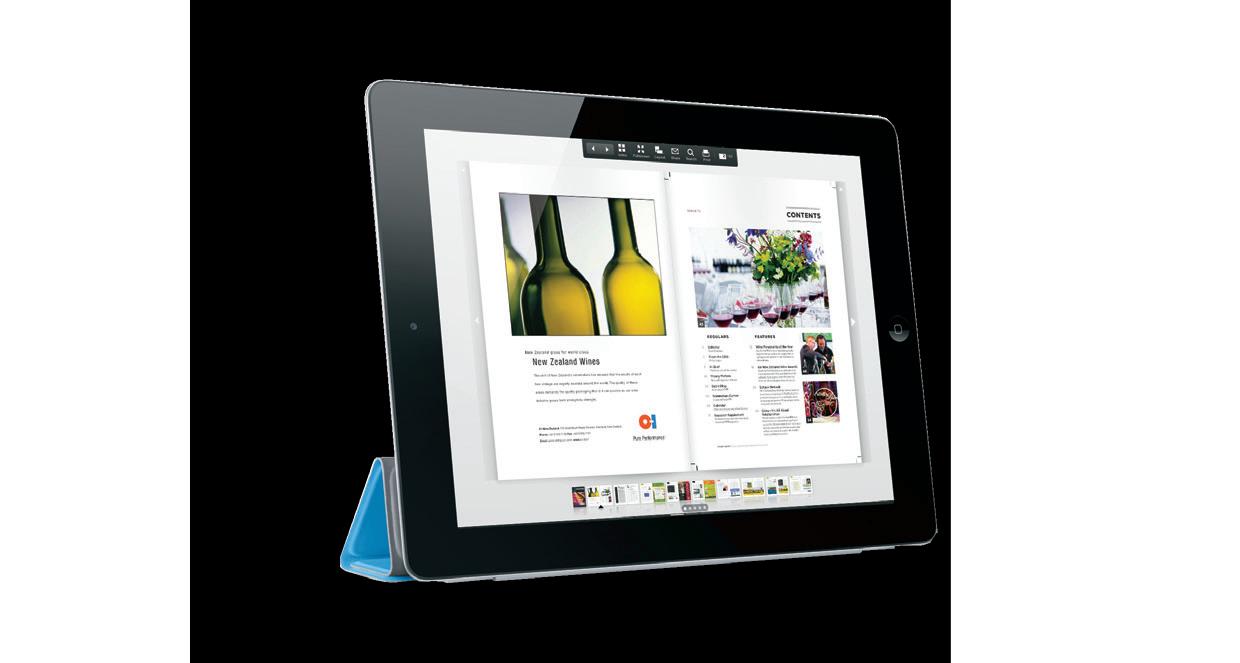

in a troublesome market, with many cutting canes and dropping fruit. But big berries and heavy bunches, thanks to a great flowering and growing season, will put the squeeze on some when it comes to winery space.
Rose Family Estate is seeing strong demand in some key markets, and has sold most of its 2024 vintage. But a surge in people looking to clear out wineries in the lead up to harvest has reduced the availability of trucks and containers to get wine sent out, he says. That’s seen Rose Family Estate sending some wine on the train this season, which they haven’t done for a long time. “We’re cautiously positive,” he says. “Everything in the winery looks really good. But can we get some of that inventory out of the winery before we need the space?”
“Every second day I have been contacted by people saying ‘do you need any more Pinot? Do you need any Chardonnay? Do you need any Sauvignon?”
Sophie Parker-Thomson
Going forward the wine industry needs be “out there shaking hands and building relationships”, Nick adds. “The key is to get people to taste the wine. You just have to fight for it a bit more.”
The season’s fruit looks “really promising,” says Sophie Parker-Thomson, a few days before Blank Canvas Wines started its harvest. “If this weather continues, we are in for a good one.”
Sophie, who is Chair of Appellation Marlborough Wine (AMW) says many of the group’s members, operating at a higher end of the market, are less impacted by the market decline, if not fully insulated. “Everyone still has to be very careful to make sure you are making what you can sell, especially with time-sensitive varieties like Sauvignon Blanc.” However, a $30 bottle of Sauvignon is in a different segment from the “commodity-type business model”, including the bulk wine market, she says. “That’s where the real pain is happening.”
Blank Canvas is diverting more fruit than usual to their higher end wines to respond to the market, including their Abstract barrel fermented Sauvignon, while also maintaining the Holdaway Sauvignon Blanc as a “gateway” to their more expensive wines. Speaking on 14 March, Sophie notes the “abundance” of crop in Marlborough vineyards, having talked to growers with yields 20% above their estimates, as well as those with no contracts at all, left in the lurch as supply outstrips demand. “Every second day I have been contacted by people saying ‘do you need any more Pinot? Do you need any Chardonnay? Do you need any Sauvignon?”
Growing pains
Grape Sense owner and viticultural consultant Mike Insley says 2022 and 2023 were good years from a grower perspective, but last year the grape price dropped from $2,400 to $2,100, yields were down, and costs continued to ramp up. This year some growers are facing tighter yield caps as well as a lower price, he says, estimating a likely district average of $1,800 per tonne of Marlborough Sauvignon Blanc. For others,
The growth of New Zealand bulk wine exports
Data from February 2025 shows volumes of bulk wine exports exceeded packaged wine. Information from the Ministry for Primary Industries shows exports of packaged wines in the 12 months to February 2025 were 134.6 million litres, down 6% on the previous year, comprising 48.9% of total export volume. Meanwhile, non-packaged wine shipments for the 12 months to February 2025 were 141m litres, up 15% on the previous year and making up 51.1% of export volume.
New Zealand Winegrowers Chief
Executive Philip Gregan points out that bulk wine figures do not recognise the difference between unbranded bulk wine and unpackaged wine produced in New Zealand and bottled under the company’s branding in market. “At the end of the day it’s a business decision that people have made.”
This year approximately half of Indevin’s branded wine portfolio will be shipped in large format to be bottled in the United Kingdom, including Villa Maria, Vidal, Thornbury and Leftfield.
the absence of a grape contract could see grapes unharvested this year, or sold for a “lowball” price. “It’s tough out there. And after the economic impact of last year, a lot of people are hurting.”
Growers without a contract have paid for their expenses in advance, so it’s a huge financial burden to see the income left on the vine or dropped to the vineyard floor. “Some of them may only just have bought the vineyard and may not have understood the importance of having a contract.”
In some cases, wineries have terminated or not renewed their grower contracts, he says.
“People are working hard to right the ship.”
Marcus Pickens
Wine Marlborough General Manager Marcus Pickens says there is a lot of concern in the industry, from some larger companies facing pressure in retail or the bulk wine market, to some boutique producers feeling the strain of lighter on premise demand, “but people are working hard to right the ship”. That will take time, he adds, noting that new vineyard developments are still coming into production while other blocks are being taken out. “You cannot supply more than you can sell. The worst case would just to be marching merrily on, pretending it’s all going somewhere, as domestic and international consumption is not rising. We have to be acute in listening to the market.” That’s something New Zealand’s wine industry has always been “really good” at, Marcus says. “Listening to the market and supplying what it wants.”
Gareth Insley, Chief Operations and Supply Chain Officer, says the UK remains Indevin’s largest market, with Villa Maria in the top spot for New Zealand wine by both volume and value. “Bottling in-market is a strategic move driven by both sustainability and service excellence,” he says. “This approach reduces the carbon footprint of each shipment by 27% compared to shipping finished goods, while also allowing us to be more agile and responsive to UK customers.”
The timing is perfect for the opening of the Marlborough Inland Port, with a surge in bottled wine leading up to the 2025 harvest, says QuayConnect General Manager Jaron McLeod. “We are going to be sitting on quite high inventory for both our packaging and export wine customers, I think, in the next few months, leading into the vintage 2025 bottling season.”
The Riverlands facility, gifted the name Honomai by Rangitāne, is a partnership between Port Nelson, logistics firm QuayConnect, and trucking company Central Express. It includes a 5,000 square metre warehouse and storage space for 350 empty and full 20-foot containers.
Jaron says that with about 80% of New Zealand’s wine grown and produced in Marlborough, the facility is a game-changer for the region’s exporters, importers and logistics operators, and supports the QuayConnect model of moving packaging across to Marlborough and full trucks of wine back to Nelson.
Peter Crowe, Chief Executive Officer at WineWorks, says Honomai has given the industry more resilience. “We want to
continue adding value to this New Zealand product here in New Zealand, rather than going offshore. And so anything that we can do from an infrastructure perspective that helps with that will be a good thing.”
Speaking after the late February launch of the facility, Jaron says QuayConnect is seeing a boost to inbound packaging and a “long tail” to the bottling season, as wineries create tank space for harvest. While not everyone will have export bookings “locked and loaded”, there appear to be green shoots in the United States and United Kingdom markets in particular, “so they have enough confidence to put stuff in a bottle... Normally we see everything empty out for a few months before filling up, but I think we will be needing all the space we can get our hands on.”
Peter is also seeing signs of recovering export levels, and a return to normal shipping patterns and sales. “We’re not seeing the orders drop away like we did this time last year, which is promising,” he says in early March. “But we are seeing inventory start to build in our warehouses.” Stock levels of the previous year’s vintage normally go down to near empty before harvest, “but we are
still seeing quite a bit of 2023 sitting in store, which is not a good position for us to be in”. Individual companies may have their 2023 inventory in hand, but added up across all WineWorks’ clients, there’s a backlog, he says.
As well as managing bottled wine, the new port will facilitate “more seamless flows” of bulk wine, Jaron says, referring to the storage of flexibags in 20-foot containers. Port Nelson’s bulk wine facilities have been busy over summer, with container trucks lined up at the gate most days. “We’re seeing unprecedented amounts of bulk wine exported at the moment.” Jaron says 2024 was a very challenging year in terms of logistics, with a slump in sales affecting wine movement in September and October, when QuayConnect is normally at its peak. Things “cracked into life” from November to February, “so that’s made those months particularly busy for us”. They now hope to work with wineries to bottle earlier in the year to smooth out the logistical load, he says. ‘That’s good for you and it’s good for us. It means that imports and exports and the movement of goods in the region just happen a lot more seamlessly.”


For more than 40 years, Hydralada has led the way in supplying vineyard and winery equipment. Working closely with the world-renowned brand Pellenc, Hydralada offers a range of machinery to increase productivity and optimise quality.



The weather has been a rollercoaster for North Canterbury growers this season, with a beautiful spring and excellent flowering, followed by the coldest January on record. By the start of harvest the region was back up at the long-term average in term of temperatures, says Greystone Winemaker Dom Maxwell on 20 March, “which these days feels cooler – we are just so used to having warmer seasons”.
They’ve also been beset by more rain than he’d like, with moisture through January and another 40mm on 18 and 19 March, “which is not what were after at this stage”. The rain came with southerly temperatures around 15C (two days after a 30C high) as well as plenty of wind, mitigating disease pressure in the damp.
Despite temperamental weather, the region has good yields of “really good” fruit, Dom says, particularly pleased with “amazing” parcels from rain-resilient hill blocks. “We had good flowering and for a lot of the smaller produces here, who have been battling small crops, it’s a welcome return to a good harvest.”
The rest of March would be focussed on the harvest of Pinot Noir and Chardonnay,
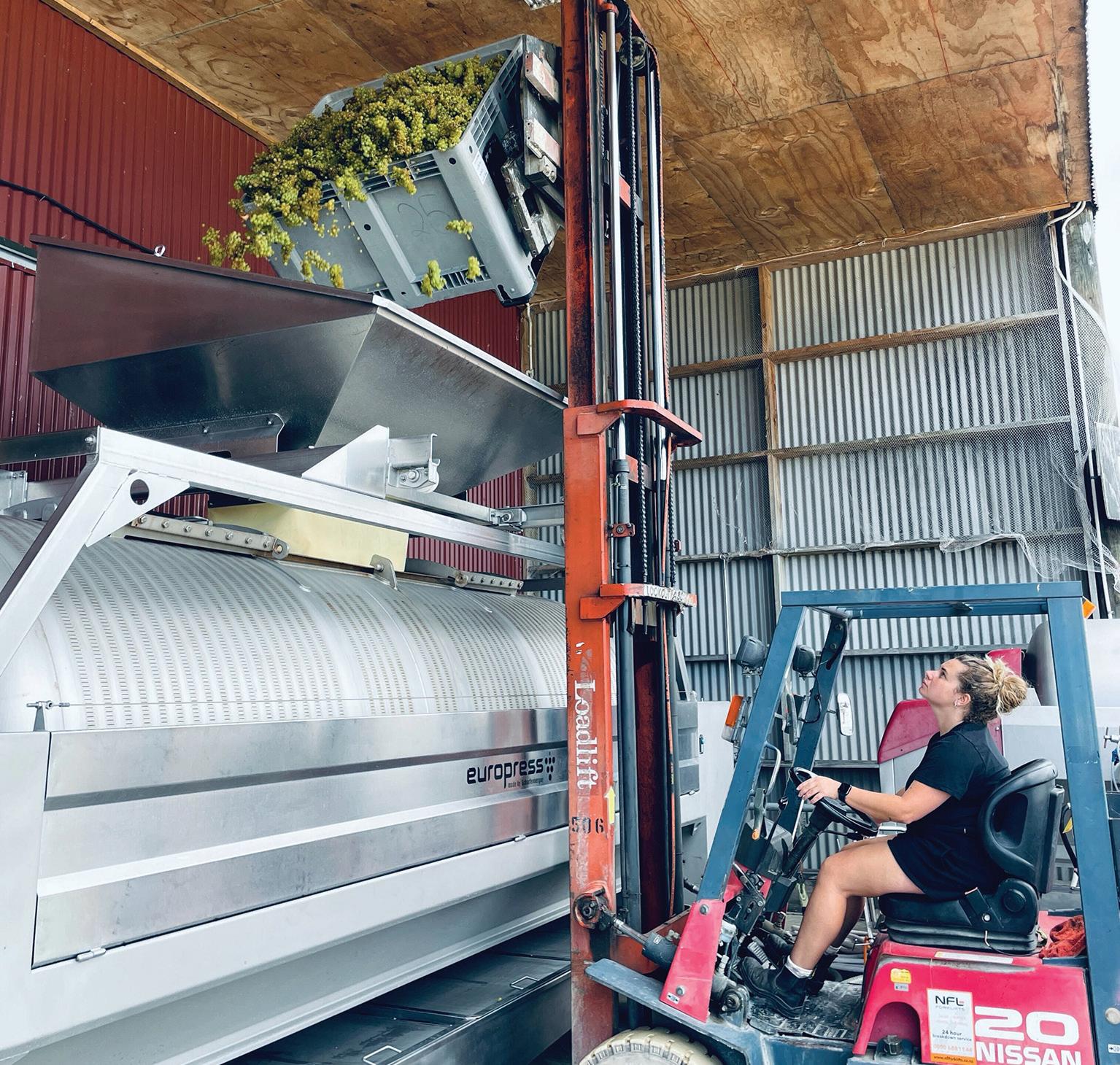



“and we’re hoping for some sustained dry weather for the later varieties”, Dom says. When it comes to morale, North Canterbury is a region well-seasoned in resilience, often dealing with an oscillation of supply, he says. “We’ve always had this balance of do we have enough? Or do we have too much?” This year it looks just right. “To be honest we’re happy. We need the fruit.”
is normally a summer rainfall area. “We had 15mm of rain in Bannockburn a couple of days ago which is the first substantive rainfall since before Christmas.” That has put the region in a “very severe, very shortterm drought”.
Harvest began around mid-March for sparkling and rosé, which is a week earlier than typical, says James. Beyond the two parts is a “surprising” and welcome anomaly,
A recent trip to Auckland buoyed his optimism in the demand for fine wines in high end on premise, which adds to his glass half full perspective. “If you are a famer, which is what we are, by nature you must be an optimist. Otherwise, this game gets on top of you.”
And he is “more than cautiously optimist” Central will end up with a good result this year. Putting his marketing hat
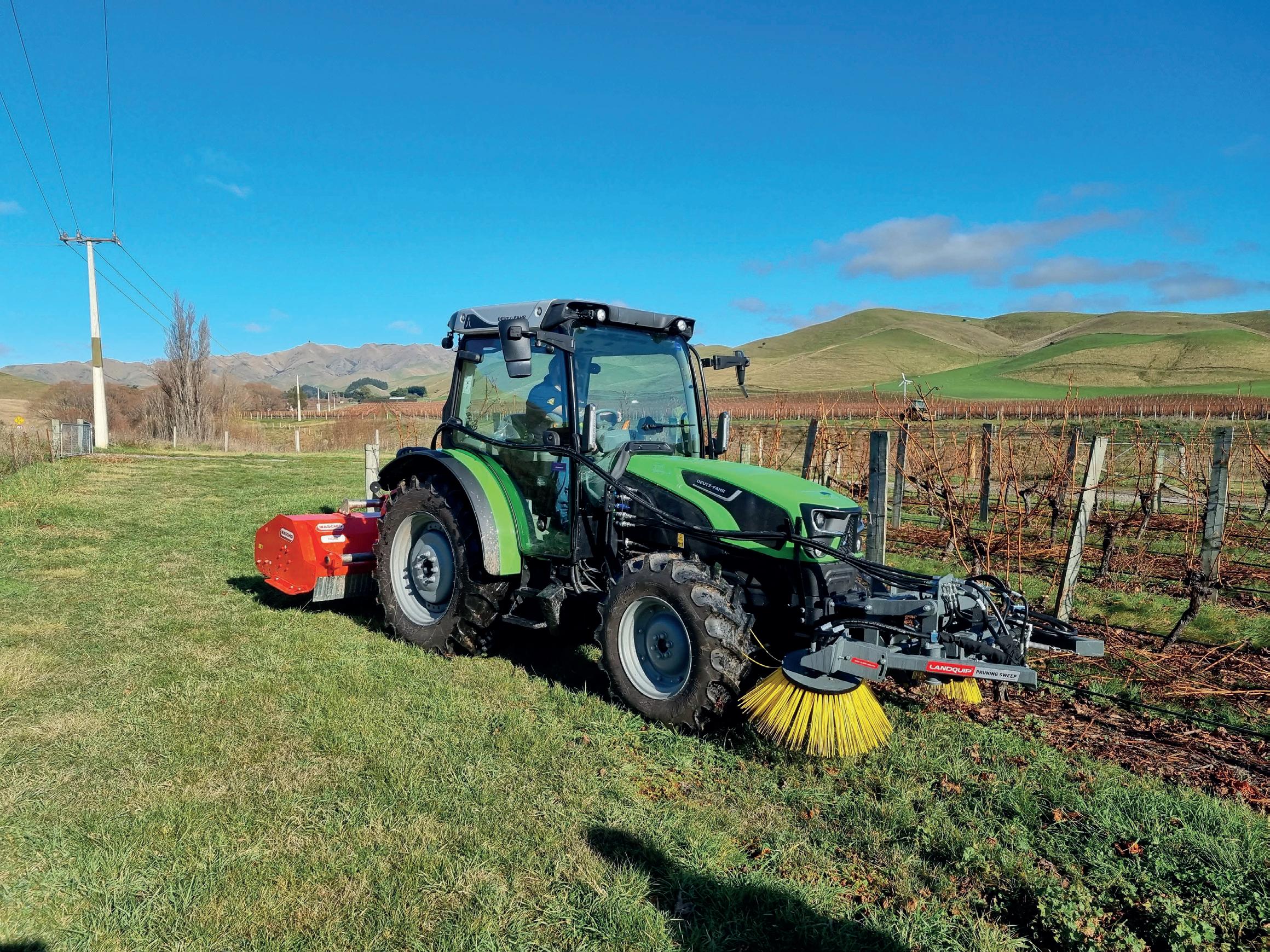

Pruning sweepers for any tractor
- 800mm side, 350mm vertical travel. - Pivot for oscillation on uneven terrain.
- Replaceable bristles.
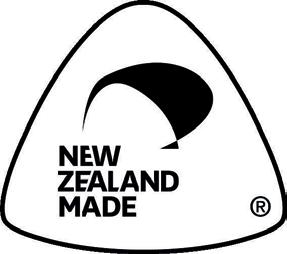

Vineyard mowers designed for any conditions! - Galvanized heavy-duty deck. - World renowned drivetrain. - Extreme TOUGH rollers.

JOELLE THOMSON
A love of research and study drew Emma Taylor into the wine industry, but it’s the people who have kept her there. “The friendliness of the industry was a huge drawcard,” says the consultant viticulturist, Deputy Chair of New Zealand Winegrowers (NZW), Director of Bragato Research Institute and 2024 Fellow of Hawke’s Bay Winegrowers, 25 years after she started at Villa Maria as a cadet.
Emma’s stellar career was seeded, in part, with a Sunday evening of TV. “When I finished my bachelor’s degree, and knowing that I quite liked wine, I watched an episode of Country Calendar on organic viticulture,” she says. “I suggested to my university professor that I wanted to understand the difference between organic vineyard soils and non-organic vineyard soils.” He suggested a more specific topic, leading to her Master of Science in Physical Geography at the University of Otago, researching copper accumulation in vineyard soils. That saw her travel around the country collecting soil samples for her thesis, “meeting vineyard owners, who were open and friendly at every vineyard I visited”.
The research gave her an in-depth understanding of how copper swiftly becomes locked up in soil, and cemented her desire to work with wine. But on graduation, Emma missed out on a job as a research viticulturist with Villa Maria and instead accepted a role as a climate consultant in Otago. She then set off for a holiday in Australia “to celebrate finishing five years of university”.
When she arrived back in New Zealand two weeks later, Emma was offered a sixmonth role as a technical viticulturist for Villa Maria, based in Hawke’s Bay, followed by a 12-month cadetship, which included visits to other wine regions to observe vineyard differences around the country. “I also spent six weeks racking barrels at the Auckland winery, and time in the nursery learning how vines are grafted. I spent a few weeks in sales, which gave me a great understanding of where everything fits.”
The company’s founder, Sir George
Fistonich, is known for his ability to pick talented viticulturists, winemakers and wine marketers, and Emma counts herself fortunate to be among them. “I was so impressed with George and his team when I first met them.”
After 12 months broadening her knowledge, Emma became Villa Maria’s Research Viticulturist, spending the next two years learning through a period of massive industry growth and limited resourcing. “In one season I think I counted the bunches of every single vineyard,” she says, grateful for the deep exposure to myriad growing practices, learning a huge amount in the process.
“Everyone brings a different perspective and together you can find solutions.”
Emma Taylor
In the winter of 2003, she and her husband Chris moved to London, but by spring Sir George had convinced her to return (eventually) to become National Viticulturist for the company. “I was excited and honoured to be considered for the role as it was a great opportunity, but the pull to continue our travels was strong,” she says. “In the end Sir George agreed to hold the role open for me for 12 months… so long as I came back to New Zealand for 10 weeks for the 2004 harvest. I have always been very appreciative for that opportunity.”
She and Chris returned to Hawke’s Bay in September 2024, and Emma was amazed by the rapid pace of change in the industry. “Even though I was only away a relatively brief period of time, the evolution in how things were done in both vineyard and winery was staggering.”
The new role involved significant national and international travel, with about six weeks a year spent out of the country, travelling to wine markets around the world, gaining insights into the global wine industry.
In 2007, while on maternity leave with her first child, Emma won Hawke’s Bay Young Viticulturist of the Year, and then the national final, before going on to add Young Horticulturist of the Year to her awards tally. She recalls being unsure whether she could take on the first regional competition, given she had a four-month-old baby, but
the Hawke’s Bay organising team “arranged the timings around my breast-feeding schedule”.
Emma didn’t want to work fulltime while raising her children, but she did want to stay in touch with industry momentum and knowledge, knowing well how quickly things had progressed while she was abroad. So, she volunteered on several fronts, including as National Coordinator of the Young Viticulturist of the Year, a member of the Research Committee of NZW, and on the Focus Vineyard committee of Hawke’s Bay Winegrowers Association. “I love working with different people to find solutions,” she says. “That’s what I love about governance… Everyone brings a different perspective and together you can find solutions.”
Meanwhile, she continued to work part time with Villa Maria, first as Viticulture Project Manager, then General Manager of the company’s grapevine nursery –Vineyard Plants – wanting a role that didn’t require a lot of travel or relentless vintage hours, as she and Chris expanded their family to three daughters.
Emma became Chair of the New Zealand Viticulture Industry Nursery Association, which was working at that time to develop vine health standards for trunk disease prevention in the Grafted Grapevine Standard. Again, she was surrounded by people eager to grow knowledge and find “pragmatic solutions” for enhanced vineyard health.
She also worked on the NZW research committee, at a time when big research programmes were being undertaken, including the virus elimination project and the Vineyard Longevity trunk disease project.
In 2020, two decades after she became a cadet, Emma ended her long tenure with Villa Maria, established Emma Taylor Viti, and joined the NZW Board, “right in the middle of Covid”. With the pandemic lockdowns, most of the initial meetings were on zoom rather than in-person, says Emma, who was voted back on in late 2024 and is now Deputy Chair.
Meanwhile, she is Viticulture Business Manager for Craigmore Sustainables, which has developed major vineyard holdings in Gisborne and Hawke’s Bay, and last year started work on a 418-hectare property on Marlborough’s Northbank, which will
have nearly 200ha of grapes when fully developed.
It’s right in her wheelhouse –working with three different wine companies and three different vineyard teams, in three different provinces, says Emma, after a day spent with Babich Viticulturist David Bullivant at the Cat Creek development in Marlborough.
“You can surround yourself with great people in this industry, and I love that side of things. The more I can work with people or different organisations the better, because then you learn more.”
The New Zealand wine industry’s appetite for cooperation and shared knowledge is why it is full of “fast adopters”, Emma says.
“Everyone works together with advancements; everyone is keen to adopt new practices.”
Asked if she ever needs to have a break from the industry, she smiles. “Why would anyone need to get away from wine?”
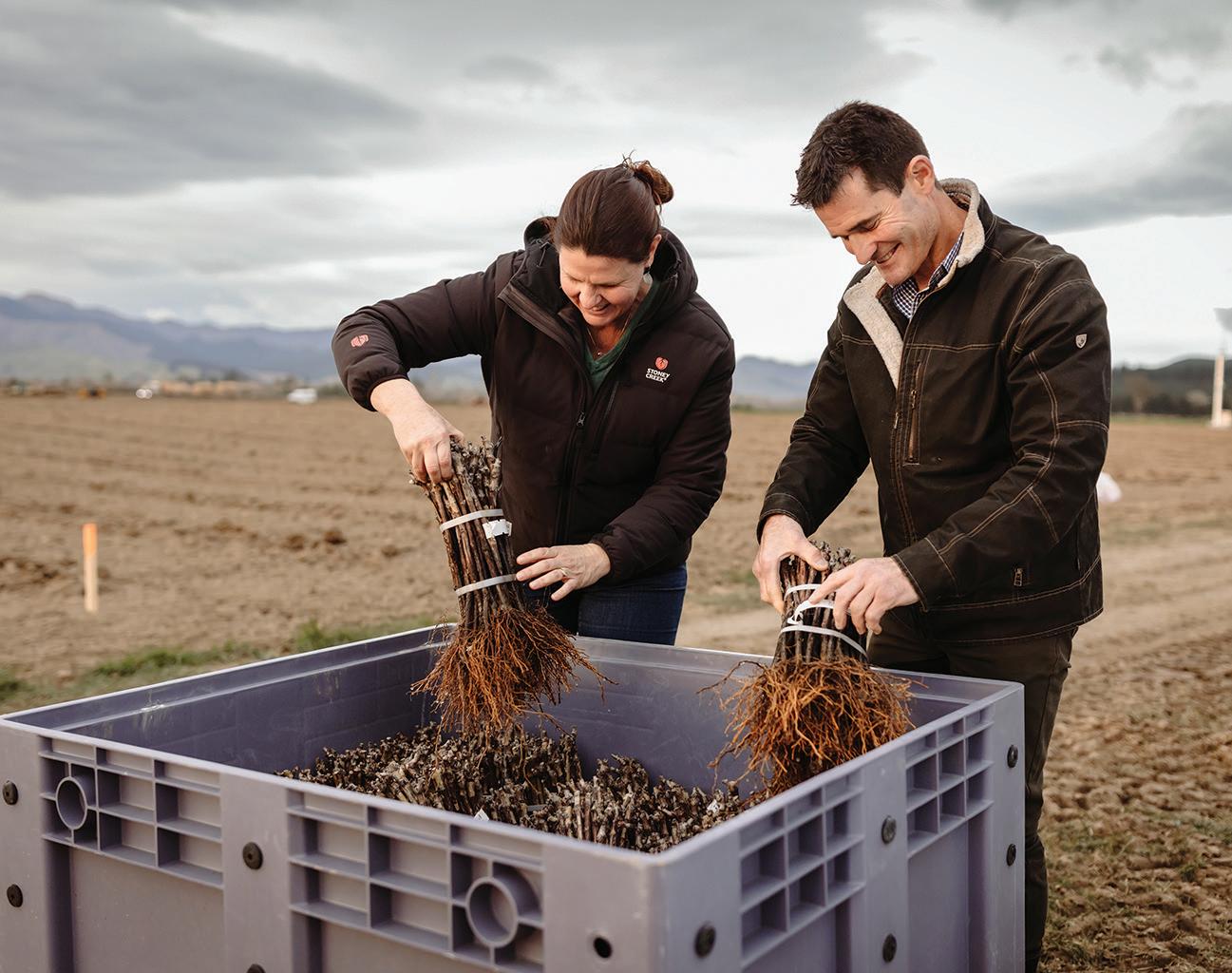
Specialising in all aspects of vineyard and winery valuation, including specialist plant and machinery. Experienced in all South Island wine growing regions.
Tel: 03 578 9776
Email: valuations@alexhayward.co.nz
Level 1/20 Market St, Blenheim, Marlborough


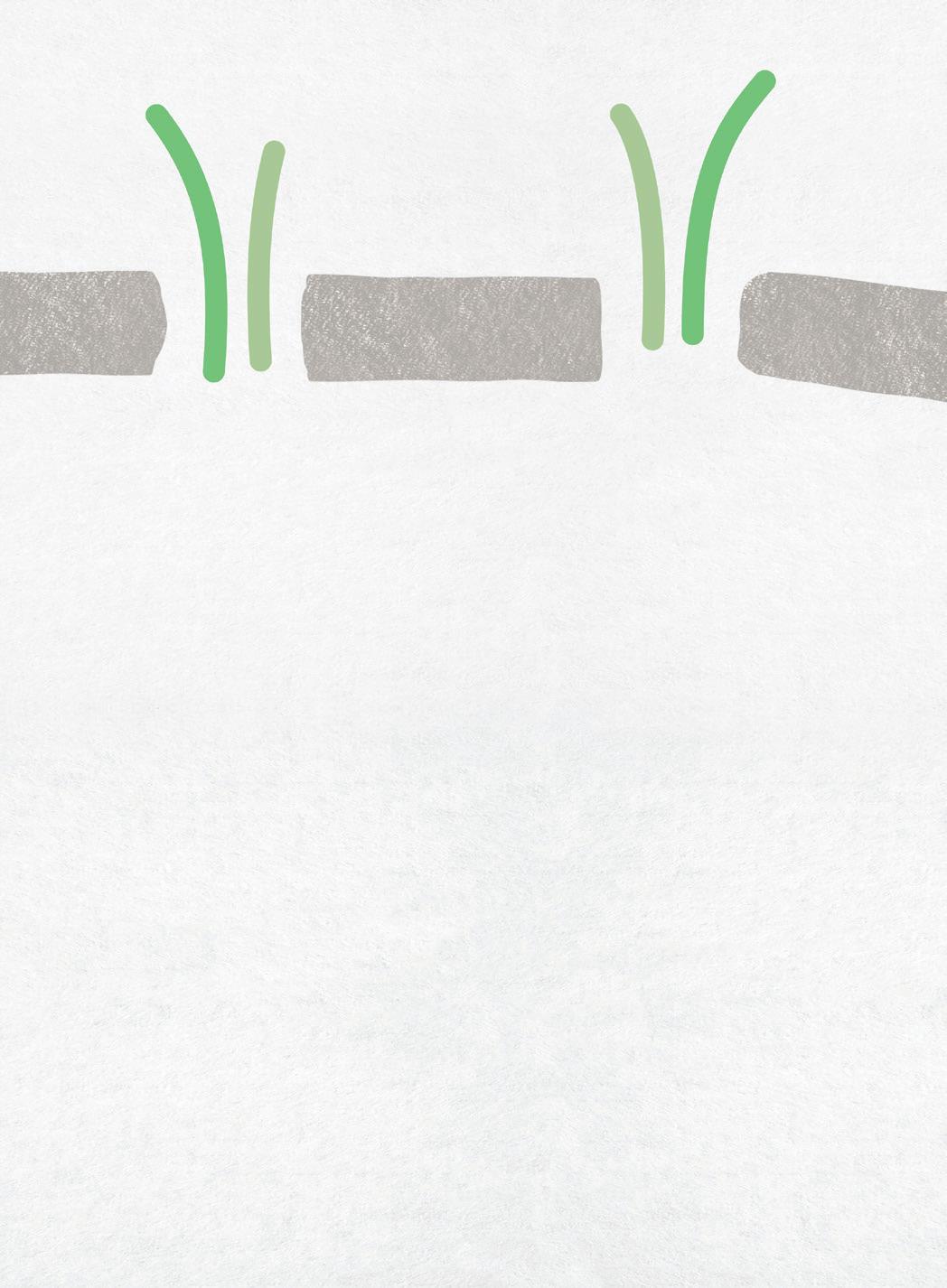
Our all-natural fine particle fertiliser delivers gentle yet powerful nutrients accurately and without waste. The secret? Unadulterated, high-quality ingredients blended into pellets. They’re easy to spread and with less waste you don’t need as much, so it’s better for your soil and our earth. Call us on 0508 678 464 or chat with your local rep. A natural way to

Thirty-five years after Gordon Russell caught the Chenin Blanc bug, he’s well and truly passed it on to his daughter Holly Girven Russell, along with her cofounders at a tiny Hawke’s Bay wine label. The Three Fates 2024 Chenin Blanc is a father-daughter collaboration, in what Holly explains as an attempt to respect the knowledge accumulated through a life in wine and carry it through with a younger generation. “In essence, a celebration of the stuff you can’t learn in wine school.”
Gordon was introduced to Chenin Blanc when he joined Esk Valley in 1989, and went on to become a champion for the variety. “I had no idea that Chenin Blanc would become such an integral part of my winemaking life and that I would still be working with it all these years later.” He says the 2024 vintage, “being one of the greatest of all Hawke’s Bay vintages”, was a great opportunity to work with Holly and her Three Fates co-founders Hester Nesbitt and Casey Motley. “All the
components fell into place to make a wine of the highest quality.”
Three Fates began amid the Covid-19 pandemic, and the 2024 Chenin represents the culmination of four years of learning, growth and experimentation together, Holly says. “The 2024 Three Fates x Gordon Russell Chenin Blanc is a testament to what happens when you blend tradition with fresh, new ideas –and when you make wine with people who share your vision.”



SOPHIE PREECE
Beautiful fizz makes for a classic romantic gesture. Which is perhaps why Jascha Oldham-Selak sent a note across his analytical chemistry class in 2017, offering Sanne Witteveen fruit for a méthode traditionnelle. “Instead of giving her a bunch of flowers I gave her about a thousand bunches of grapes.”
Eight years on, the duo have a “phenomenal” client base around the country, Hawke’s Bay’s only tirage and disgorging service (with another facility to launch in Central Otago this year), a feted wine brand, and a mission to make New Zealand sparkling a quality match for Champagne. “New Zealand méthode traditionnelle is destined to be a wine style of significance,” Jascha says.
A focus on fizz
Jascha was in the last year of his wine degree at EIT in Hawke’s Bay, already laser-focussed on bottle fermented bubbles, when he met Sanne, who was completing her final two years, after a year of distance
learning. He made his grand grape gesture a few weeks later, despite clocking the risk of creating competition in the sparkling category. “But I thought ‘I need to share my contacts and passion and experience with someone else.’” Sanne used the fruit to make a 2017 Methode Rosé, which won student wine of the year at the Hawke’s Bay Wine Awards in 2018, following Jascha’s win two years earlier with a 2015 Blanc de Blanc. “We’re both on the trophy, which special for us both to look back on,” Jascha says.
He has spent more than 10 years “110%” focused on building knowledge, growing contacts, and strategising for top tier, Champagne-competitive New Zealand méthode traditionnelle. That’s thanks to one of his first EIT lectures in 2014, when viticulturist Dr Richard Smart asked the students why New Zealand wasn’t taking the style more seriously. There were only 30 in the class, all “green as anything”, and Jascha felt like he was the only one who heard. “From that moment onwards that’s all I thought about.”
In his final year of study he processed a commercial harvest, with a tonne of fruit (minus Sanne’s gifted bunches), a tiny press, and his first client. “Not everyone knows how to make méthode traditionnelle, so all I had to do was focus on it for a few years entirely and then I could continue my winemaking career as a consultant... our clientele kept on growing from that point on.”
He went on to produce many more small-
scale batches of méthode traditionnelle wines for other producers, as well as their own label, Vilaura. That began in 2019, was launched in late 2023, and won two of the three gold medals in the sparkling class at last year’s National Wine Awards Aotearoa, where the 2020 Marlborough Blanc de Blanc won Champion Wine of the sparkling wine class and the trophy for Best Wine of Show. It was, said Chair of Judges Jane Cooper, “an outstanding example of classically made méthode traditionnelle; a clear and deserved winner.”
Vilaura is “skin in the game” for Jascha and Sanne, “leading by example” with fruit judiciously handpicked then whole bunch pressed with minimal extraction, so that only the highest quality portion of the juice is used, with the “finest acidity and minerality that we are aiming for”. The wine is bottle fermented and aged for a minimum of three years on yeast lees, says Jascha, who would like all New Zealand méthode to be aged a minimum of two years, to develop autolytic character, before being hand riddled and disgorged.
It’s a “slow game” that requires planning, patience and an understanding accountant, but once the first vintage is on shelves, producers can “ride the wave”, he adds. “Vilaura is doing well because we use time as an ingredient. That is giving us a significant advantage in the market.”
Methode Services
Vilaura is a flagbearer for what New
Zealand méthode can be, but it’s only a small part of what Sanne and Jascha do, with the lion’s share of their time spent on consultation and winemaking facilities through their company Methode Services. That includes Hawke’s Bay’s only tirage and disgorging facility, established in 2023, and the new base they’re developing in Central Otago, to support current and new productions that would normally need to travel to Marlborough for secondary ferment and packaging.
In February Jascha and Sanne took their new tirage machine down to bottle for a handful of companies, and have found “phenomenal” support and encouragement from the industry, including major players like Gibbston Valley Winery, Maude and Amisfield, “to name a few”.
They’re not alone in urging more Central producers to add sparkle to their portfolio, with Wine Network Consulting, from Australia, running a sparkling wine workshop in the lead up to to the 2025 harvest. It’s a topical subject, “especially for a Pinot Noir growing region”, says Central Otago Winegrowers Association General Manager Carolyn Murray. Attendees were keen to learn more about the different methods of production and their pros and
cons, as well as vineyard considerations, she says. “It definitely provided some food for thought.”
Sparkling wine requires grapes with higher acid and lower brix than still wines, meaning it’s the first cab off the rank at harvest. “If you’re a bubbles producer, life is a lot easier,” says Jascha, describing the risk mitigation (in the face of a looming tropical cyclone and fragile fruit, for example) of harvesting at 19 brix, early in the season, for a high-quality base wine.
Jascha is forecasting 300,000 bottles a year through the Central Otago service, to be based in Cromwell, but is “fully prepared” to upscale, with advantages in being a multiregional operator, able to adapt quickly. “We are preparing to be the national provider of méthode traditionnelle contract services.”
One unexpected development in Hawke’s Bay and Central Otago is the big demand for help in producing pétillant naturel, which is currently a third of the Methode Services business. Jascha says New Zealand examples have traditionally been “a bit experimental and hazy”, but producers like Rippon and Amisfield are giving them to Methode Services to disgorge, “for a cleaner, fresher, more marketable product”.
It’s a style that can tap into what he says is “huge growth” in the sparkling market, thanks in part to consumers choosing carbonated beverages, whether that’s an RTD, a spritzer or a méthode traditionnelle. In terms of Vilaura, “it is literally selling itself”, he says. “Trade are coming to us.”
The cost of Champagne is another factor in the buoyancy of the sparkling market, Jascha says. In 2022 he and Sanne travelled to Italy for four months then Épernay, France, for three. They worked with Grand Cru Champagne producers, with Sanne as an assistant winemaker and Jascha in the vineyard, finding the balance of brix, acids and flavour of the grapes and the influence of the chalky sub-soils.
They are devoted to the traditions of Champagne, but say the region’s product is now “fairly overpriced” in New Zealand for the relative quality, and there is growing concern about the impact of climate change.
That’s a great reason for New Zealand to measure up in terms of quality, Jascha says. “A huge part of what we do is advocating premiumisation; encouraging our clients to produce wines with the aim to compete with some of the best méthode traditionnelle examples of the world.”


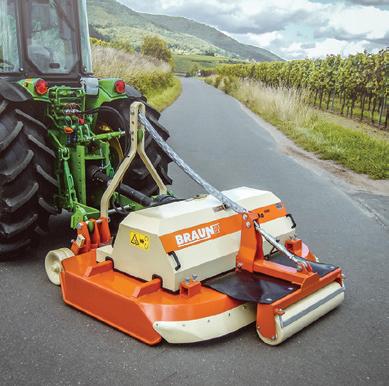

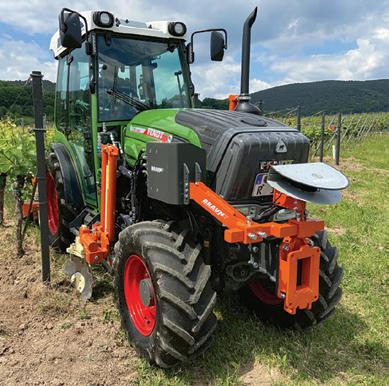








Fifty years after Hermann and Agnes Seifried picked their first grapes in Nelson, their eldest daughter, HEIDI SEIFRIED-HOUGHTON, reflects on the enduring legacy of this “wild dream”.
As I sit down to write this piece in late January, my younger brother Chris is calling on my 11-year-old daughter for a helping hand. She is knocking around the winery at the end of her school holidays and he is dealing with a bottling line breakdown and needs a person with small hands to squeeze around the carton packer to unscrew bolts and take photos.
My childhood memories, and those of Chris and our sister Anna, are full of moments like this – waiting, helping or playing on the periphery while our parents Hermann and Agnes Seifried worked tirelessly to pioneer wine production in the Nelson region. In 1973 they hand grafted, planted and tended the region’s first commercial grapevines, and in 1976, 50 vintages ago this year, they harvested their first grapes.
Over the past five decades, our vineyards and winery have continued to expand, and
today we own and run 10 blocks over 320 hectares, with an extensive varietal offering. Chris, Anna and I, having grown up in these vines, all work in the business our parents built from scratch, by hand, and against all expert advice.
A romantic dream
Our family wine story began on New Year’s Day, 1971, when Hermann arrived in New Zealand to become winemaker for the New Zealand Apple and Pear Board (NZAPB) in Nelson. In those days family producers in the North Island passed knowledge from generation to generation, with no formal wine education, so it’s quite possible Hermann was the first university-trained winemaker in the country.
He worked alongside Dr David Heatherbell (of DSIR in those days, and later Lincoln University), and was involved in several projects, including the development of Vivante, which is still ‘fondly’ recalled by many.
A few months after arriving, Hermann fell for a young secondary school teacher working as a home scientist at Nayland College. He met Agnes Wilkins, who hailed from a Southland sheep farm, at a summer work party on Mt Robert Ski Field in the Nelson Lakes, and they married in December that year.
Hermann has always regarded New Zealand as a place of opportunity. As one of six sons growing up in southern Austria,
he understood that land supply is finite. When their father died at a relatively young age, Hermann’s oldest brother took over the operation, and Hermann accepted a scholarship to attend Staatliche Lehr- und Versuchsanstalt für Wein- und Obstbau Weinsberg. He was supported by the huge South African wine company KWV, and was bonded to work with them in Paarl for three years after graduating.
“There was simply no appetite to loan money to the crazy newlyweds who wanted
to establish a wine business.”
Heidi Seifried-Houghton
During his time in South Africa, Hermann became interested in other southern hemisphere wine producing countries, and says watching the Springboks take on the All Blacks cemented his interest in New Zealand. So when a visiting NZAPB group, investigating orchards and the making of apple wine, and they offered him a job to expand their beverage offering, he was in.
Once in the Nelson region, Hermann quickly realised the potential for winegrape production alongside the hops, tobacco and apples that grew so successfully here. But the ‘experts’ of the time considered it
too cool and too far south to be viable, and government and rural bankers turned down their approaches for finance – there was simply no appetite to loan money to the crazy newlyweds who wanted to establish a wine business. They eventually found cautious support from the Anglican church, with a loan at close to 20% interest.
“Seagulls circled and a cigarette hung from Jim’s mouth as he helped my mother load ‘empties’ into the back of the Hunter station wagon, working around my sleeping brother in his carrycot on the back seat.”
Heidi Seifried-Houghton
Agnes and Hermann purchased our original block in Upper Moutere, but kept their day jobs while removing the existing apple orchard in 1973. Grafting vines was not typical in New Zealand back then, but

Hermann’s training had taught him that phylloxera would ultimately catch up with every wine region, so they spent late nights grafting vines (in seven different varieties) by hand. These days we grow and produce 13 varietals, giving us a valuable point of difference.
In 1996 they had their inaugural vintage, followed by successes at the National Wine Show, which boosted demand and sales just as they opened the Seifried Estate cellar door on Labour weekend that year.
The accolades gave my parents

confidence in their wild dream and they continued a gradual vineyard expansion, highly motivated to repay the loan as soon as possible.
In 1977 Hermann gave up his job and brought his full focus to vines and wines. My parents called on friends, neighbours and relatives to help with everything from concreting and laying blocks for the winery, to hand picking grapes.
A new generation
As babies, Chris, Anna and I would sleep in



our carrycots under the vines. As we grew up, we helped where we could, hand picking grapes, bird scaring on quad bikes, or with ratchets underneath strings of shimmering foil, once the seals on our glass milk bottles. Hermann was later involved in developing and trialling bird netting, before it was widely adopted by the industry. Back then, harvest ran from the very end of March to the first week of May. These days we pick our final grapes in the first week of April, which is an incredible shift in one generation.
In the winery we helped waterblast floors, watched tanks racking, and stood by pumps ready to press ‘stop’. Hermann had taught himself to weld, and spent late nights and early mornings repurposing old milk vats into upright wine tanks. We still have dozens of tanks he made, complete with a gutter rim where the early cooling system of the day would run cold water over the top of tanks and collect it for re-use. As kids we would help there too, dialing the gas bottles as Hermann moved along a stainless seam calling, “gas on; gas off”.
“We have been selfsufficient from the get-go, with no contract bottling lines or pruning crews back in the day.”
Heidi Seifried-Houghton
They set us up with a small stainless-steel bin, which was ideal for cooling off with a ‘swim’ on hot days. We would go on to make huts in cardboard boxes stacked up out the back of the cellar door, or have an afternoon kip, top-and-tailing on the couch outside the smoko room.
In the early years, Agnes would collect empty bottles from Jim at the Nelson tip at the end of her daily town run, delivering wine to local restaurants and hotels.
Seagulls circled and a cigarette hung from Jim’s mouth as he helped my mother load ‘empties’ into the back of the Hunter station wagon, working around my sleeping brother in his carrycot on the back seat. On rainy days, when vineyard work was off, our small team would work on the bottle washer in the winery to prepare the used bottles for the next bottling day.
Agnes also did a weekly exchange of a dozen bottles of wine with regular
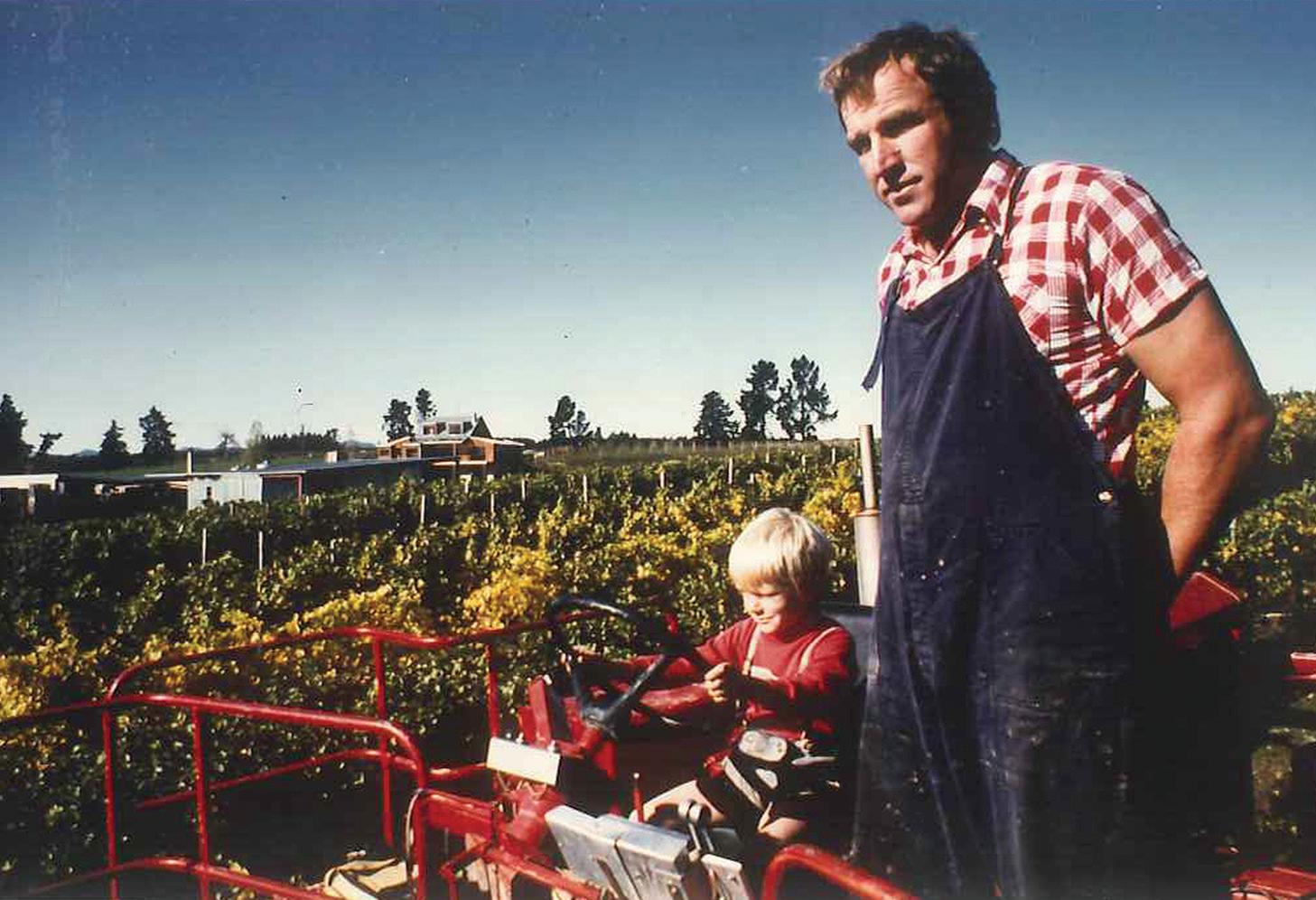
customers at our cellar door, as they returned their ‘empties’ for 10c refunds. These were the days before modern self-adhesive labels, and we kids rolled individual paper labels through the little ‘glue machine’.
Other rainy-day tasks included assembling dividers ready for the next bottling run. It was a puzzle for new players, but we kids could quickly assemble the dozen bottle kit sets. We’d put capsules on corked bottles, hand stack bottles onto the machine, and help with packing. Perhaps my parents scheduled bottling during school holidays to capture willing helpers.
Our family business had a very loyal customer base, including people holidaying at Kaiteriteri and Golden Bay, who would visit each summer to reconnect with my mother at the cellar door. The Seifried kids would be around to assist with glass washing and restocking quickly depleted shelves.
Until we obtained a computer in the mid-1980s, Agnes maintained a database in multiple address books. She handaddressed 4,500 envelopes three times a year at its peak (my siblings and I helped apply postage stamps) and sent out a newsletter and order form to encourage sales. The mail orders were dispatched daily with the Newman’s bus driver, who collected a pallet load on his way from Takaka to Nelson.
One of the things I genuinely appreciate, then and now, is the camaraderie in our industry, whether working alongside
local Nelson producers or the wider New Zealand wine community. In the very early days, I recall Nelson-Marlborough industry wine tastings and picnics on Sundays, including one day in Pelorus in the 1980s, with producers from both sides of the hill meeting for a midway gathering. Some of those people are still in the industry today. Those strong connections were key when New Zealand wine was really gaining momentum overseas, particularly in the critical United Kingdom market, where they worked to build Brand New Zealand together.
We kids adapted to having extras in the car, as our family played tour guide to what seemed like an endless stream of internationals coming our way. I can vividly remember the day we took an Austrian hitchhiker named Rudi Bauer from the 1998 Cool Climate Conference in Auckland to his vintage job in Hawke’s Bay. Ultimately, he too put down roots, founding Quartz Reef in Central Otago.
Lifelong friendships also remain with many of our international distributors, customers and vintage crew. Agnes and Hermann take an annual trip with one of our earliest German vintage employees from the early 1980s, selecting a different wine region around the world to visit. My siblings and I have also kept contact with many of these people, and have employed second generation family vintage interns, which is a lovely full circle.
Half a century on
We have been self-sufficient from the get-go, with no contract bottling lines or
pruning crews back in the day. And we still manage every step in-house, from propagation, vineyard operations and staffing, through to bottling and distribution. That makes for a busy place with lots of diversity in day-to-day activities, but does mean we have close oversight of what goes into the bottle.
Chris, Anna and I all contribute in different ways, with Anna focused on sales and marketing, and overseeing our wonderful team of Pacific Islanders, part of the wider Seifried family since 2008. Chris takes charge of production and packaging, and the big picture generally. He also works closely with many of our overseas distribution partners in the United Kingdom and Europe. This leaves me as a bit of an allrounder. As well as working part time as a dentist, I lead the winery team with Chris, oversee the lab, quality control and compliance, and keep tabs on the vineyards as well.
Hermann still has massive love for growing grapes and coordinating the vineyard team, and makes sure we have the very best fruit the season has to offer come harvest time. While Agnes is rarely found

at the office these days, she is on call when questions arise, offering a gentle listening ear, and is a wealth of knowledge, thanks to 50 years growing our business.

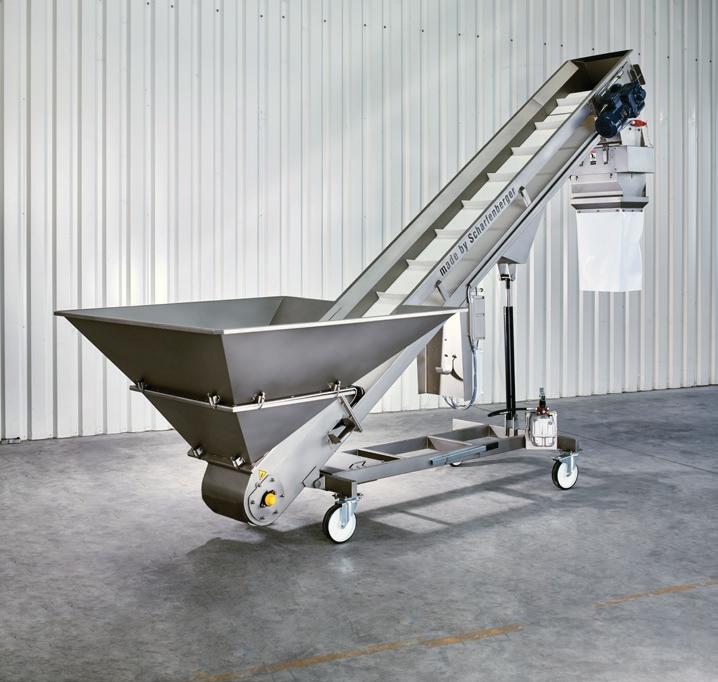
For over 50 years, Scharfenberger has been setting the standard in grape processing. Quality of build, simplicity of use and cleaning with ongoing reliability has made the Scharfenberger range of equipment for grape processing the brand winemakers turn to. Contact Grapeworks to discuss your requirements.
We have been fortunate to be a part of such a diverse and vibrant industry, characterised by its cohesive and supportive nature – just like a family really.

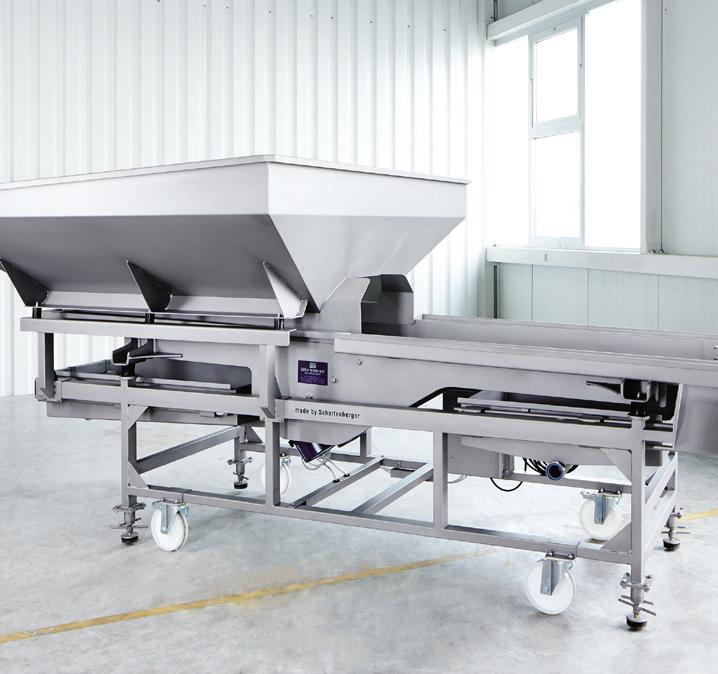
Demonstrating our commitment to the future through climate change mitigation
Dr Edwin Massey
The Roadmap to Net Zero 2050: an important commitment to our sustainable future
In February I enjoyed the opportunity to present a keynote address at Climate Action Week Marlborough on the reasons why climate change is the most significant long-term challenge facing our industry and what the short-term opportunities are for members to take action to reduce their carbon emissions.
There are three key financial incentives in taking action to reduce carbon emissions, and these incentives apply to all businesses, no matter the size.
Firstly, the steps we take to reduce our carbon emissions will be important for continued market access into key markets. Increasingly, governments and retailers in our major markets are asking harder questions regarding the steps we are taking as an industry to mitigate climate change. As the trading environment becomes more difficult, sustainability, including our commitment to a Net Zero future, will become a passport to trade.
“Climate change is an important sustainability issue for younger drinkers and these trends are likely to strengthen over time.”
Dr Edwin Massey
Secondly, the demographics of consumers in our markets continue to evolve. The latest International Wine and Spirits Research on the category health of New Zealand wine highlighted that in a range of key markets, the New Zealand Wine brand is strongly associated with sustainable production. This association is becoming more important for younger consumers when making purchasing decisions. Climate change is an important sustainability issue for younger drinkers and these trends are likely to strengthen over time. Furthermore, as the cost of fossil fuels continues to rise, operating the same way we do now will get more and
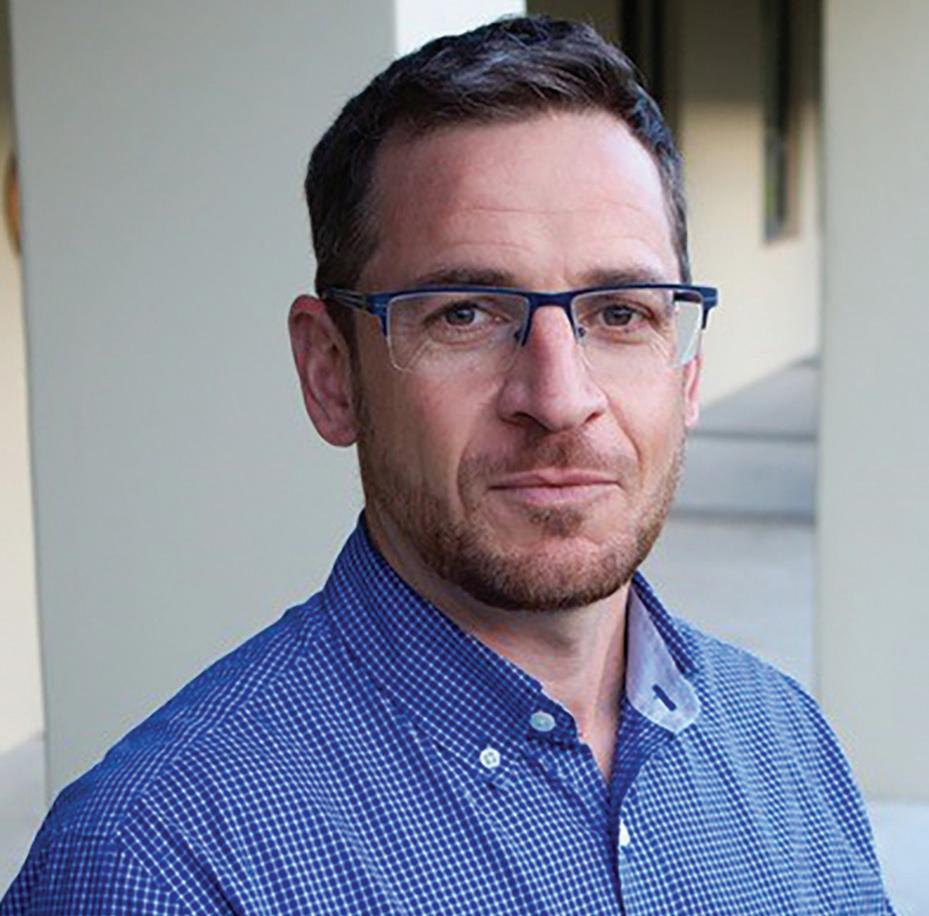

more expensive. Actions to maximise our energy efficiency are crucial to reduce costs in this area. It has been great to see the work EECA (the Energy Efficiency and Conservation Authority) has done with members of the industry to support them taking action in this area. New Zealand Winegrowers (NZW) and EECA have worked together to produce a wine sector decarbonisation pathway that contains information on how to get started. eeca.govt.nz/co-funding-and-support/ products/wine-decarbonisation-pathway.
Accelerating progress to a net zero future
Many members understand the opportunities available to reduce their carbon emissions and are already acting to future proof their businesses. For instance, latest data from Sustainable Winegrowing New Zealand (SWNZ) show that:
• 68% of wineries are implementing specific initiatives to minimise their carbon footprint – a 10% increase since 2022.
• 63% of wineries are using lightweight glass bottles as one of their packaging methods – an 8% increase since 2022.
• 15% of wineries have installed solar energy sources – 3% up on 2022.
• 56% of vineyards are implementing specific initiatives to minimise their carbon footprint – a 15% increase
since 2022.
• 30% of vineyards are upgrading their equipment to reduce energy consumption – an 11% increase since 2022.
A growing portion of our membership is taking the next step in driving change by becoming formally certified through verified carbon-auditing bodies – 127 vineyards and 30 wineries reported measuring and managing greenhouse gas emissions for their vineyard through a verified certification programme. Of these, 30 vineyards and 12 wineries reported doing this through a certified carbon zero programme. This is a significant increase from 2022, when only 75 vineyards and 15 wineries had these formal certifications. The soon to be released NZW Sustainability Report 2025 will provide further updates on progress towards our sustainability goals.
The Roadmap to Net Zero 2050 estimated our total industry emissions at 305,000 tonnes in 2022. While there remains a long way to travel to get to our goal, statistics show we are accelerating our industry’s pace of change to a net zero future. These statistics highlight that year by year, bit by bit, the positive actions members of our industry take are making a difference, leaving our industry, our world and our wine better for it.

Dr Edwin Massey is NZW General Manager Sustainability
SOPHIE PREECE
The vineyards at Pyramid Farm in Marlborough’s Avon Valley have never been run of the mill, with plantings that follow the natural contours of the land, 250 metres above sea level.
So it’s hardly surprising that viticulturist Richard Hunter parked the mower this summer and drove 360 young sheep into five hectares of vineyard instead, in the second year of a trial to reduce carbon emissions and herbicide, while maintaining green cover through the growing season. “It’s not a silver bullet. But it’s one option we have that’s not mechanical.”
The sheep intensively grazed two lots of 2.5ha blocks in mid-January, with three days in one and two in the next, before being let loose into the whole 44ha of vines for two weeks. Next year they plan to run 500 sheep through the full 44ha, with intensive grazing of the 2.5ha blocks through January and early February.


Richard says the flock’s preferred feed was the flowerheads and stalks of weeds, with the grass nibbled down after that. While they nipped at some vine leaf there was no damage to the fruit, he says.
The integration of sheep is just one of the myriad initiatives devised by Richard and Pyramid Farm’s owners, Chris and Julia Dawkins, who developed these vineyards with big plans for a smaller impact. The
farm, which won Supreme Award at the 2019 Cawthron Marlborough Environment Awards, has a mix of vineyard, pasture, regenerated native bush and riparian plantings, as well as mixed species forestry. The first vines were planted in late 2016, rolling down hills and over terraces above the Avon river. The blocks have subsurface irrigation, to reduce water use and weeds, and were subdivided into “intensive grazing zones” using an Eco Trellis Post they designed alongside New Zealand Tube Mills, enabling the ovine-vine management.
The farm’s vineyard is certified through Sustainable Winegrowing New Zealand and was one of the features of Climate Action Week Marlborough in late February. It is a case study in looking outside the box, for the sustainability of the land and environment, as well as the industry. “We can’t carry on doing the same things, because people’s attitudes are changing,” Richard says. “If we don’t change with them, then we lose our market to somebody who does. It’s as simple as that.”

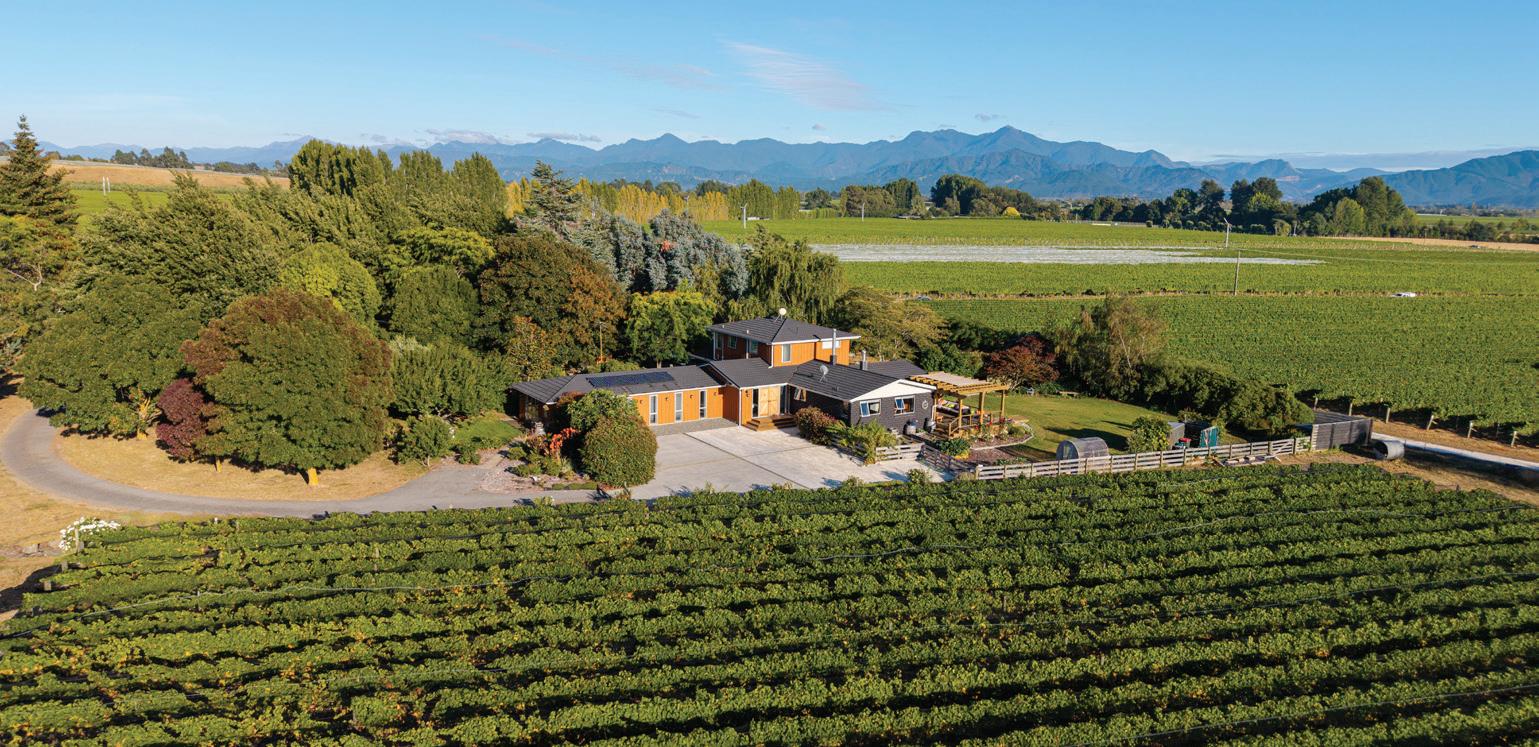
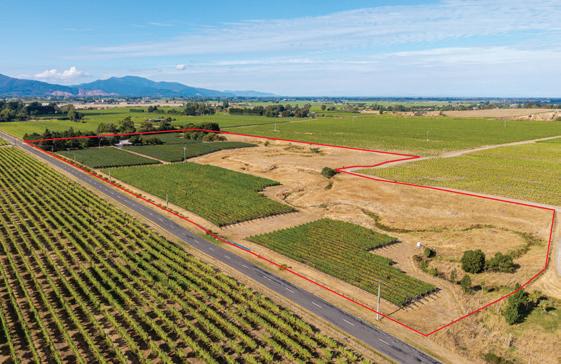

JAMES MORRISON
I am writing this story with the 2025 harvest in full swing. The often-cool periods of weather that have plagued much of New Zealand this summer have broken and now a mild early autumn has arrived, along with the traditional northwesterlies.
Wairarapa and North Canterbury had their coldest recorded January, with data for those locations stretching back over 50 years. Elsewhere, Hawke’s Bay and Gisborne recorded temperatures very close to record lows for January. A return to near
“Wairarapa and North Canterbury had their coldest recorded January.”
James Morrison
normal temperatures was the outcome for February, and now some consistently warm weather has dominated the middle of March. La Niña arrived mid-summer and should now weaken through autumn and early winter. There is the likelihood of humid northeasterly conditions returning in early to mid-April as the Madden-Julian Oscillation phase reaches the western Pacific Ocean and increases the chances of low-pressure development north of New Zealand. The Southern Oscillation Index remains close to neutral so periods


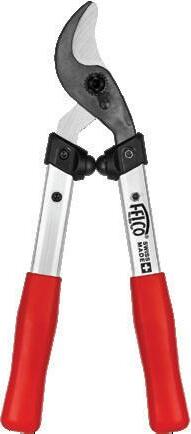

of westerly winds are also expected for the remainder of autumn, which may lead to cooler southwest changes followed by cool mornings and frosts, especially from late April onwards.
Diurnal range & the mean temperature:
The amount of available heat from the sun decreases through autumn and at an increasing rate through April and early May. This is a time when large variations between daytime and night-time temperature can occur. On occasions the temperature can vary by more than 20C from the coldest part of the early morning before dawn through until mid-afternoon. Under stable anticyclonic conditions, or as a light northwesterly airstream develops,
this can become even more pronounced. With longer nights there is more time available for the air to cool, and under clear, settled conditions the air will cool steadily and quickly through the night. The most likely scenario for these large ranges in temperature is under an anticyclone; with stable and usually clear skies there is strong radiational cooling at night. As we get later into autumn, fog can form in low lying areas and light frosts occur as well.
The mean temperature for a day is calculated by taking the average of the maximum and minimum temperature for a particular location so a typical settled day in autumn might look like a minimum of 8C and a high of 23C which would equate to a mean of 15.5C. When the air is particularly dry or a mild northwest



flow develops, these variations often become quite exaggerated. A morning temperature on the east coast could be close to freezing at dawn but rise to over 25C during the afternoon with the onset of a northwesterly airstream.
Increased northeasterly flows have a twofold effect for east coast regions. First, the onshore flow brings moisture. The increase in humidity slows the rate of cooling under settled conditions and also increases the likelihood of cloud forming. This reduces the diurnal range. A typical temperature profile might range from 13C at dawn to 18C by 3pm, which would still have a mean temperature of 15.5C.
Outlook for April and May:
Gisborne/Hawke’s Bay
A more humid and cloudier period of weather is expected for the first half of April, but conditions should become sunnier and milder during the daytime from late April onwards, as the northeast flow weakens and a westerly airstream redevelops. Rainfall totals are likely to run near average, but there is a risk of higher-than-normal rainfall at times through early April.
Wairarapa
West to northwest winds will be stronger at times as fronts approach New Zealand from the west and this may increase for a time from mid-April and through early May. Mean temperatures are likely to remain a little above average, but night-time temperatures may remain close to average across the region, with cool nights following any southwest change. Rainfall totals are likely to be close to or a little below average through until the onset of winter.
Nelson
Temperatures are likely to continue to run above average for the remainder of autumn. Rainfall totals may run near average but could increase with active fronts moving in from the west. Northwest winds are likely to ease through early April then return for a time later in the month. There is a risk of frost at times from late April as cooler and drier southwest changes cross the upper South Island.
Marlborough/North Canterbury
Temperatures remain above average and wind speeds are likely to remain stronger than average from mid-April with the flow tending west to northwest. Humidity is likely to be lower under the westerly flow through late April and into May, this may lead to an increased range between night-time and daytime temperatures and some early frost across the regions. Rainfall totals are expected to run a little below average, but an increased northeast flow through early April has the potential to bring a humid easterly airstream to the east coast of the upper South Island.
Central
Temperatures are likely to remain above average for the remainder of autumn. Northwest winds continue, which contributes to milder day time maximums. Cool southwest changes are also expected and this should increase the number of frost mornings from late April onwards. Rainfall is expected to be near or a little below average. There will be the chance of heavier rain if the northwest flow becomes particularly vigorous and mixes with cold sub-Antarctic air as winter approaches.
James Morrison runs Weatherstation Frost Forecasting: weatherstation.net.nz

IT
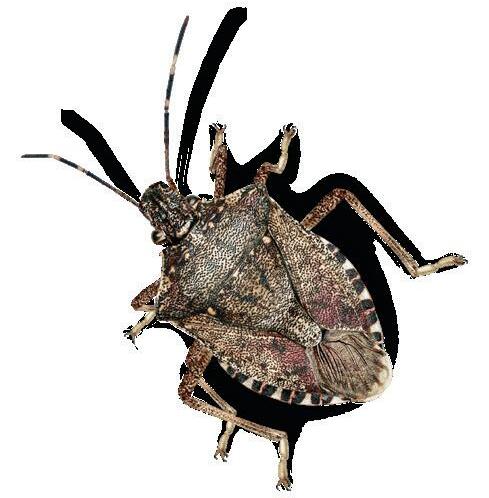



The brown marmorated stink bug is a pest that infests homes, ruins gardens, stinks when crushed, and is almost impossible to get rid of. It could also destroy our fruit and vegetable industries. It’s not in New Zealand yet, and we want to keep it that way. So if you see one, don’t kill it. Catch it, take a photo, and call us on 0800 80 99 66.
For more information (including how to identify the bug) visit biosecurity.govt.nz/stinkbug




Strengthening biosecurity in New Zealand Vineyards: A new requirement for SWNZ members In recognition of the increasing risks posed by offshore biosecurity threats, the New Zealand Winegrowers Board has taken a proactive step. At the August 2023 meeting, the board agreed to require all Sustainable Winegrowing New Zealand (SWNZ) vineyard members to have a biosecurity plan in place by 30 June 2026. This initiative underscores the critical importance of biosecurity in protecting the nation’s wine industry from devastating pests and diseases. Biosecurity is not just the responsibility of regulators or border control agencies but also a shared responsibility across the entire wine industry. Recognising this, New Zealand Winegrowers (NZW) strongly encourages all its members, not just those in SWNZ, to establish biosecurity plans to help protect the industry.
The growing biosecurity threat
Globally, biological invasions are occurring more frequently, and the financial damage they cause is now comparable to that of natural disasters. New Zealand has already faced significant incursions, including Psa in kiwifruit, Mycoplasma bovis in cattle, varroa mite in bees, fall armyworm in crops, and Queensland fruit fly in horticulture. These invasions have been costly for both the government and industry, while individual growers and farmers have borne the brunt of the impact.
New Zealand’s unique natural environment and biodiversity are also at
risk. Incursions such as kauri dieback and myrtle rust highlight the vulnerability of native species to introduced pests and diseases. The wine industry is not immune to these threats. With Marlborough accounting for a large percentage of viticulture plantings and Sauvignon Blanc dominating production, the industry is particularly susceptible to biosecurity risks. Given that New Zealand wine exports exceeded $2.1 billion in 2024, maintaining strong biosecurity measures is essential to protect both economic and environmental sustainability.
Two major biosecurity threats to the New Zealand wine industry are the brown marmorated stink bug (BMSB) and Xylella fastidiosa. BMSB, a highly invasive pest, is intercepted at New Zealand’s borders every year despite stringent offshore treatments and public awareness campaigns. Xylella fastidiosa, the bacterium responsible for Pierce’s disease in grapevines, has had devastating effects on vineyards overseas and could severely impact New Zealand’s wine industry if introduced.
Given these risks, it is essential that all NZW members understand biosecurity and their role in protecting vineyards. Implementing a biosecurity plan allows vineyard owners and managers to take proactive steps to reduce the likelihood and impact of an incursion.
What will be audited?
To maintain or gain SWNZ certification from the 2025/2026 season, SWNZ vineyard members must meet seven
biosecurity requirements. Some of these are already required for certification, while others are new additions. The following list outlines these requirements:
• Biosecurity vineyard register: Ensure all details are fully and accurately completed by 30 June each year (existing SWNZ requirement).
• Biosecurity awareness material: Display biosecurity guidelines, vineyard pest and disease identification guides, and 0800 hotline posters (new requirement).
• Pest and disease monitoring: Conduct frequent inspections of vines and vegetation for vineyard pest and disease recording results (existing SWNZ requirement).
• Staff and contractor training: Ensure staff, contractors, and crop scouts are familiar with the industry’s Most Unwanted pests, biosecurity guidelines, and the Biosecurity New Zealand 0800 hotline (new requirement).
• Pest and disease management plans: Develop and maintain vineyard spray plans (existing SWNZ requirement under the Plant Protection focus area).
• Source of planting material: Obtain new grapevine planting material from existing New Zealand stock or through the legal importation system (legal requirement).
• New planting material: Ensure all new vines and cuttings meet certification standards or have been tested negative for grapevine leafroll-associated virus3and are true to type (new requirement).
NZW is providing a range of resources, including templates, pest and disease



guides, and other materials, to help vineyard owners develop and implement their biosecurity plans. In addition, planning workshops, online meetings, and vineyard visits will be available to assist members in meeting these new requirements.
Workshops will be structured to provide both an overview of the requirements and hands-on guidance in developing a vineyard-specific biosecurity plan. The sessions will run for two hours: the first hour will cover biosecurity resources and obligations, while the second hour will allow participants to complete a draft biosecurity plan using the provided templates.
Biosecurity planning workshops have been scheduled across the country as per the below dates to ensure all SWNZ vineyard members have the support they need. The NZW biosecurity team is currently working with regional associations to secure venues, and members will receive email correspondence with further details.
• 30 April: Central Otago
• 2 May: Waitaki Valley
• 6 May: Marlborough
• 13 May: Marlborough
• 20 May: North Canterbury
• 22 May: Nelson
• 4 June: Northland
• 6 June: Auckland/Waikato
• 17 June: Wairarapa
• 24 June: Gisborne
• 26 June: Hawke’s Bay
These workshops will give vineyard owners the tools and knowledge to develop a robust biosecurity plan tailored to their site.
For more information on biosecurity planning, the SWNZ audit processes, and resources, NZW members can access the latest guidance online and attend one of the scheduled workshops.
The NZW Board’s decision to incorporate biosecurity planning into SWNZ certification reflects the growing recognition of the importance of proactive biosecurity measures. The new requirements will strengthen the industry’s resilience against incursions and support the long-term sustainability of New Zealand’s vineyards. By working
For more than 40 years, Hydralada has led the way in supplying vineyard and winery equipment. Working closely with the world-renowned brand Pellenc, Hydralada offers a range of machinery to increase productivity and optimise quality.

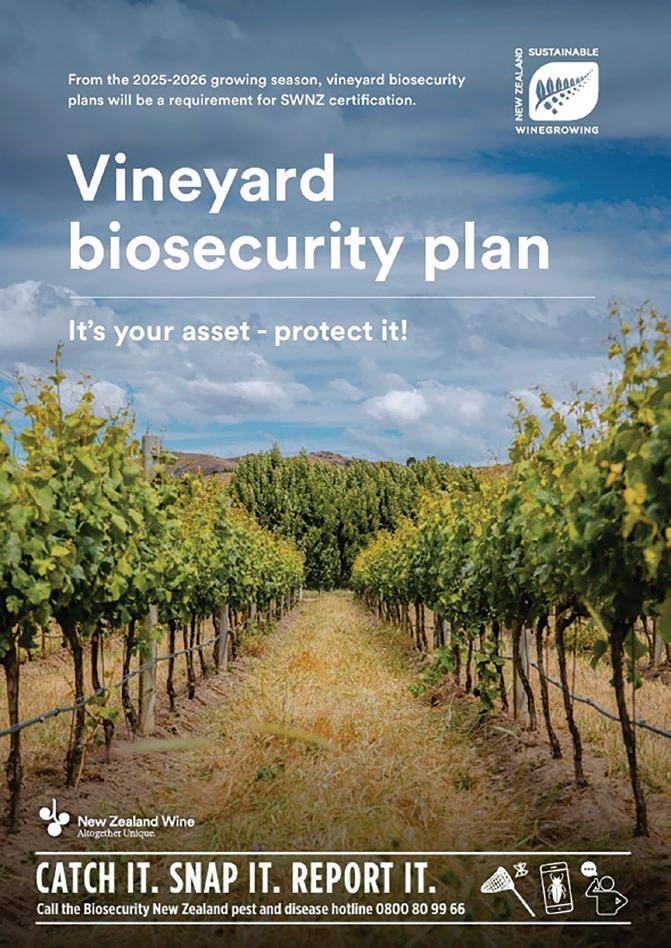
together, the New Zealand wine industry can stay ahead of biosecurity threats and continue producing world-class wines. For more information, contact the NZW biosecurity team by emailing biosecurity@nzwine.com


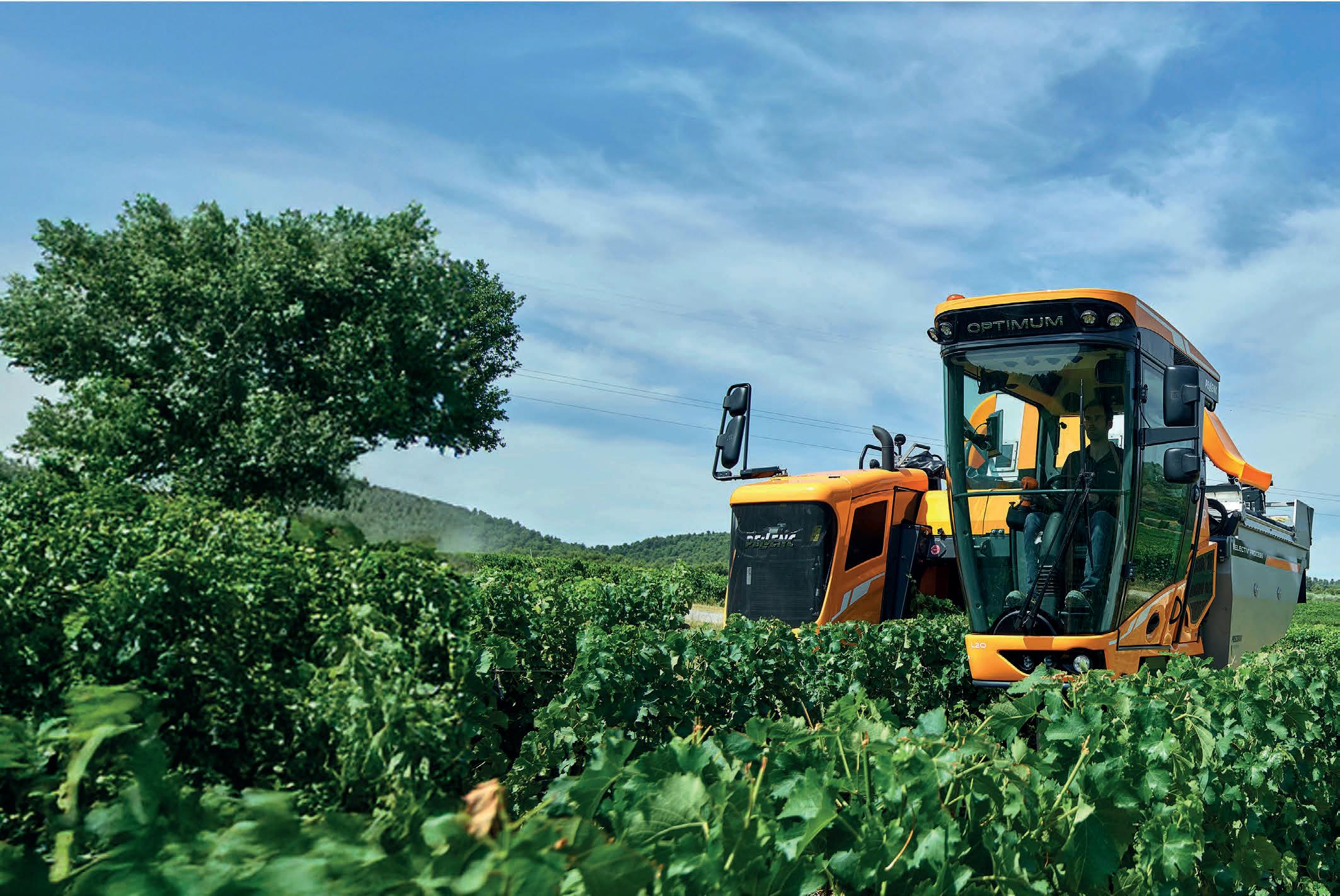

your behalf
Taking NZ wine to the world: Bringing the world to NZ wine
Advocacy on matters of vital importance to the industry
Philip Gregan
Proposed Gene Technology Bill: What it means for winegrowers and what NZW is doing about it Genetic modification has long been a topic of hot debate. Historically, techniques to manipulate or modify genetic material within an organism were viewed with suspicion. However, as new genetic technologies emerge and are commercialised, this scepticism has lessened. Techniques have become safer, more precise and those applying them possess a stronger understanding of the potential benefits/risks. There is now a growing acceptance that not all genetic technologies present the same types of risks, and the potential benefits for human and environmental health could be significant.
In late 2024, the Government introduced a new Gene Technology Bill to Parliament seeking to modernise how gene technologies are regulated within New Zealand. The objective was to facilitate the development and commercialisation of these technologies by establishing a new regulator to assess applications for use and set standards on these within a new risk tiered system. The Bill mirrors the Australian Gene Technology Act that has been in place since 2000 and reflects a greater alignment with how other international jurisdictions assess genetic technologies. Importantly, the Bill itself does not approve any new technologies, it merely creates a system that could enable

such approvals.
This represents a shift from the status quo of the Hazardous Substances and New Organisms Act 1996, which takes a restrictive blanket approach to genetic technologies with tight restrictions on limited approvals. Critics say this has unduly restricted the ability for New Zealand to innovate and apply new low risk technologies in both health and agriculture settings where there may be significant benefits. However, there are always risks in new technologies, and both sides of the coin need consideration.
So, what does this mean for winegrowers? A more nuanced regulatory framework could have significant benefits for research and innovation in the industry, particularly in mitigating the significant current and future impacts of climate and environmental pressures on viticulture.
A 2019 Royal Society Te Apārangi expert report on gene-editing for the primary industries identified CRISPR-cas9 as an example of a low-risk gene-editing technology gaining international traction. This technique edits existing DNA to produce naturally occurring traits that are indistinguishable from conventional selectively breeding. If applied to vines, the precision of this technique could allow promotion of desirable resilience traits such as drought and disease resistance, producing more resilient vines, with the effect of lessening reliance on water use, and herbicides/pesticides in the vineyard.
A new regulatory environment is not without risk. New Zealand’s wine industry reputation is heralded for exporting high value, sustainably produced wines that attract a premium in our over 100 international markets. Great care is required that these changes do not get ahead of both market and consumer expectations.
“A delicate balance is required to protect what we have, whilst moving from a restrictive status quo approach that presents its own significant risks.”
Philip Gregan
This begins by safeguarding the existing trade and market arrangements to ensure any changes in technology and how we produce our products do not undermine these. New Zealand Winegrowers (NZW) recognises that organic producers have concerns on how changes may impact the management of supply chain traceability and certification when seeking to remain ‘GE free’.
NZW has, with the input of Bragato Research Institute, submitted on these key points during public consultation,













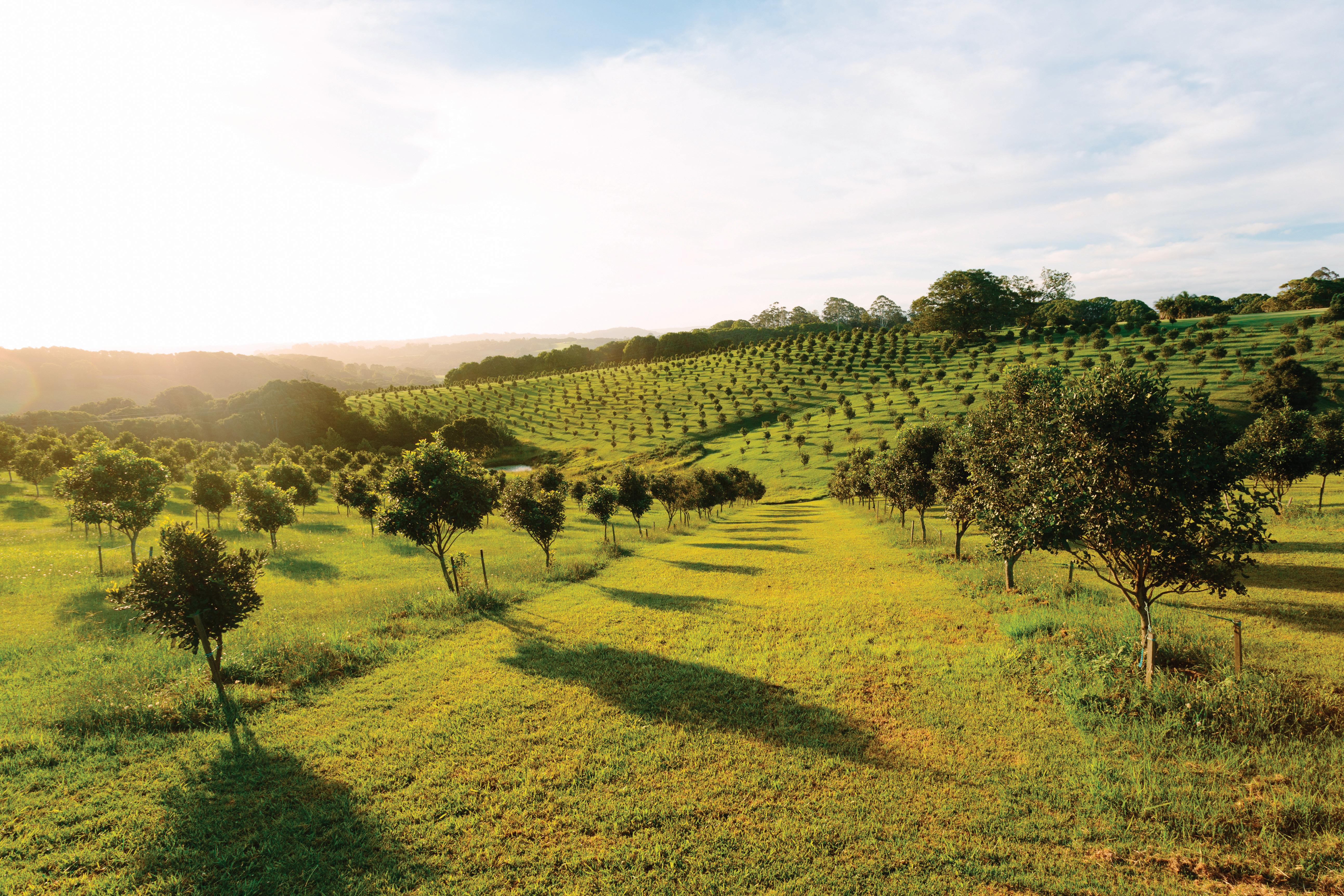
New Zealand-based company Robotics Plus, a specialist in agricultural automation, has announced an agreement for it to be acquired by Yamaha Motor to form Yamaha Agriculture. The new company will be focused on delivering autonomous equipment and AI-powered digital solutions that help growers in the specialty crop market become more sustainable, profitable and resilient.
Robotics Plus currently develops automation solutions for agriculture, calling on expertise in robotics, automation, sensing, and data analytics, leading to a proven record of delivering innovative technologies to global markets. Its latest development, Prospr, is a robust, autonomous, multi-purpose hybrid vehicle designed to perform a range of orchard and vineyard tasks. Built to tackle labour shortages and enhance efficiency, precision, sustainability, and safety, the vehicle is capable of multiple activities, including spraying and weed control, with complementary attachments, such as mowing, currently in development.
Yamaha Motor has supported Robotics Plus since 2017, with strategic investment
Having already hit the headlines for recycling broken 2.4 metre vineyard posts into 1.8 and 1.6 metre, half and quarter posts for agriculture, Repost recently hit the milestone of one million posts recycled, diverting the CCA treated posts from landfill. Now their product offering has expanded with the addition of intermediate battens, a product in demand by many New Zealand farmers.
A newly built machine features a multi-bladed rip saw layout, which when fed with half-round posts, converts

to drive development of agricultural automation technologies and to expand its presence in the ag-tech sector. Following the acquisition, the company will continue to operate its core business from its headquarters in Tauranga, retaining high value skilled jobs and IP development in New Zealand, delivered by a team of 130 employees, while benefiting from the support of Yamaha Agriculture globally. Yamaha Agriculture will combine Robotics Plus’ robotic solution Prospr with advanced data analytics to support producers of wine grapes, apples, and other specialty crops across North America, Australia, and New Zealand
The company Co-founder and Chief Executive Officer Steve Saunders says Robotics Plus was founded on a vision to solve the agricultural industry’s biggest challenges around labour, productivity

the offering into multiple, 50 x 50mm battens in one pass. Intended for use as
and sustainability. “Over the years, we have formed a strong partnership with Yamaha to empower large-scale growers, so innovations like Prospr, at the heart of Yamaha Agriculture’s global strategy, will enable a data-driven approach to precision agriculture.”
Nolan Paul, Group CEO, Yamaha Agriculture, Inc. says Yamaha Agriculture recognises that the challenges facing specialty crop growers require solutions that will take time to develop. “The capabilities of Robotics Plus in robotics and automation will be an important building block in addressing these challenges, along with AIpowered data analytics. We are committed to an approach that prioritizes creating real value for growers while maintaining the standards of quality and reliability for which Yamaha Motors is known.”
yamaha-agriculture.com
drop battens; feedback from farmers and contractors is the battens are dry, straight and hold the staples tightly. The system is able to process timber in shorter lengths of 1.5m and under, which were still heading to landfill.
Company founder, Greg Coppell says, although the rip saw is still in its early days, there is clear demand as farmers can now buy multiple products from one source. Ongoing development means the machine can also be configured to make other useful products such as palings and marker pegs.
Visit repost.co.nz to use Repost’s price comparison calculator.
JOANNA GRIGG
Heavy crops, coupled with winery yield caps, made 2025 the ideal season to use mechanical shaking to reduce fruit loadings. Viticultural consultant Mark Allen says some operators needed a refresher, since the last really heavy crop was 2014. In particular, people sought information on accurately adjusting the harvester settings. If the maths isn’t done properly, the fruit drop can be underdone, with growers spending money for a minimal effect, he says. “People then blame the system when it is their procedure.”
Some contractors were ill-prepared for the job this season, with no scales or white trays to drop fruit on, or no chutes on the harvester to direct fruit onto the trays. Meanwhile, some growers were reluctant to use mechanical thinning as they had not been using it regularly enough, even for trash removal to reduce botrytis, Mark says.
He project-managed an initial threeyear Plant & Food research project on mechanical thinning, including measurements of botrytis control as a successful cultural method, indicating a 50 to 55% reduction in Sauvignon Blanc and far more with Pinot Gris. Part of the response is a thickening of the berry skins. Even though the skins on the top cane tend to be thicker, there is no difference in juice brix, Mark says,
referring to research by Dr Mike Trought (see link at end of story).
He says cutting a cane to reduce fruit yield adds to botrytis risk and harvesting difficulty. Cutting bunches off is another option but, unless it’s done before fruit-set, the remaining bunches can compensate to add weight. Bunch thinning by hand is typically more than twice as expensive as mechanical shaking, “and neither method reduces botrytis”.
“It’s a very cost-effective way to get yield reduction and disease resistance.”
James Jones
James Jones has been using mechanical thinning across Starborough Farming Company’s Awatere and Wairau blocks since the initial research results, and this year used it on 170 hectares, using their own harvester. “It’s a very cost-effective way to get yield reduction and disease resistance,” he says. Some extra heavy blocks had a 20% reduction shake, plus de-clumping of bunches, and s hoot thinning in spring. “We had big tonnages but I’m really happy on crop loading now.”
James says it is hard to judge any extra decrease from berry size reduction, beyond the percentage of berries that fall off into the tray. “The mantra was
the reduction effect on the remaining bunches will be double what’s on the ground, but maybe it’s more.” He places six trays under three vines and runs the harvester through, repeating this four or five times to get an average drop proportion. He uses November floret counts plus the average bunch weight at the point of shaking to calculate current vine fruit weight. He assumes half of the reduction is from berries dropping off and half by berries caught in the canopy and reduced berry size, although this is the big variable and can change with vine age, yield and trellis. James repeats the morning sample with an afternoon sample, and waits until bunches are at least 50 grams, so they swing. He likes to back up his calculations with close observations of fruit loadings on the block and having a feel for what is still heavy.
Monitoring the effect of shaking strategies at harvest would be useful, but there’s seldom time in the heat of harvest, James says, noting that revisiting old research could improve accuracy with the different scenarios of shaking.
Mark recommends leaving a control row. “A quick BRAT score pre harvest confirms the effectiveness and enables wineries and growers to reach an agreement of the ‘total infection’ and acceptance level.”

Check out the fact sheet, Mechanical Thinning: Why, What, When and How, at nzwine.com/members/research/ vineyard-resources.




A regular feature to inform and update the wine industry on research projects being undertaken for their benefit. Newly approved projects when available are briefly summarised. Ongoing projects have longer articles that describe progress and what has been achieved so far. When completed, each project report will be shared in full detail in the Research Library on nzwine.com.
Bragato Research Institute leads quality research and innovation that enables the New Zealand wine industry to thrive. It conducts research in-house and collaborates with research organisations throughout New Zealand. The main research provider for each project is listed below. Updates are provided on the highlighted projects in this supplement.
Vineyard innovation
Next Generation Viticulture Programme
Bragato Research Institute
Evaluation of the short-term impact of remedial surgery on grapevine trunk disease and vineyard sustainability
Linnaeus, SARDI, Sutton McCarthy
Potential applications of nanotechnology for winegrowing in New Zealand
University of Auckland
Varietal diversification: Cool climate aromatic white wine produced by Marlborough
Bragato Research Institute, EIT, NMIT
Central Otago Pinot Noir clonal trial
Bragato Research Institute, Otago Polytechnic, Riversun Nurseries
Elemental sulphur persistence on grapes and mitigation strategies
Lincoln University
Increasing financial sustainability of Chardonnay in Hawke’s Bay through long spur pruning to increase yield
Eastern Institute of Technology
Long spur pruning as an alternative for Marlborough Sauvignon Blanc
Bragato Research Institute
Chardonnay clonal micro vinification – Hawke’s Bay and Martinborough Bragato Research Institute, Eastern Institute of Technology, University of Auckland
Genetics for winegrowing
Sauvignon Blanc Grapevine Improvement Programme
Bragato Research Institute, Plant & Food Research, Lincoln University
National Vine Collection virus eradication
Bragato Research Institute
Rapid detection of fungicideresistance in grapevine powdery mildew in New Zealand
Bragato Research Institute
Graft-derived drought tolerance: identifying and functionally characterising graft-transmitted elements
Bragato Research Institute
Winemaking innovation
Exploring reductive aromas in Pinot Noir
University of Auckland
Precipitation of calcium tartrate and other compounds in wine
University of Canterbury
Lab on a Chip: Developing diagnostic devices for the wine industry University of Canterbury
Prevention of quercetin instability in bottled wine
Indevin
Sustainable winegrowing
UV light in vineyards to reduce fungicide dependence
Bragato Research Institute, A Lighter Touch
Microbial community and vine responses to increasing temperatures in the New Zealand context University of Auckland
Evaluating water use efficiency and drought tolerance of various rootstocks grafted to Sauvignon Blanc
Bragato Research Institute


Dr Darrell Lizamore, Bragato Research Institute
Investing in emerging innovation can provide a unique opportunity to leapfrog current processes and harness new innovations. Consider how satellite internet has enabled remote regions of New Zealand to bypass the costly process of fibre installation and achieve modern connectivity almost overnight. That’s the vision behind the wine industry’s Sauvignon Blanc 2.0 Programme –an ambitious initiative designed to establish a cutting-edge grapevine improvement platform that will produce the next generation of resilient vines at an accelerated pace.
The programme runs until early-2030 and completed its third year in 2024. This article provides an update on progress to date, the strategic advantages for winegrowers, and how early outputs will help secure New Zealand’s competitive edge in the global wine market.
Last year the programme achieved a significant milestone – successfully producing more than 6,000 new Sauvignon Blanc clones. These vines begin as cells collected from fieldgrown vines and are then grown into new plantlets under conditions that apply just enough stress to trigger spontaneous genetic changes. Each new vine is assigned a unique ID and QR code so they can be tracked through their development from controlled indoor environments, to a nursery mist-tent, to a shade house, in an online database. This ensures that every plant’s growth and performance is optimised.
With the first batch of plants outgrowing their pots, one of the key challenges of the past six months has been to establish a bespoke

research vineyard for early plant selection screening. The young vines leave the nursery as immature, ungrafted seedlings, and therefore require nurturing to adapt to outdoor conditions. Wind protection, frost management, and irrigation capacity must all be carefully considered.
The site also needs to be managed under quarantine conditions, so environmental DNA testing was developed to test for the presence of pests and diseases before the first poles were installed. Based on an ex-pasture field in Lincoln, the vineyard infrastructure is now in place, with a vineyard manager on site and equipment contributed by programme grantors. An accelerated effort before Christmas saw all 6,000 clones planted ahead of schedule, giving them the best chance to take advantage of the summer months (Figure 1). With survival rates exceeding 97% this rapid establishment has been an exciting milestone for the programme, and sets the stage for the next phase of selection based on key agronomic
traits and genetic variation. Efforts to upscale DNA extraction and sequencing have been developed using current commercial clones (Figure 2). Deploying these methods across the collection over the coming year will enable the research team to map the genetic variation across the new clones, to guide early selection of vines with stable changes. DNA sequencing generates terabytes of data, and sophisticated bioinformatic workflows needed to be built for identifying subtle genetic differences (DNA changes; Figure 3) and epigenetic modifications (changes in which genes are expressed). These are the changes that could be key to traits such as disease tolerance, drought resistance, and changes in aroma biochemistry (Figure 4).
Because growers prioritise the ability for new vines to tolerate higher disease pressure to reduce spray costs and support sustainable viticulture, the programme has developed a series of assays to screen for critical traits. One of the most exciting developments in this area is
the recent delivery of the Blackbird robot. This AI-driven robotic camera is engineered to perform rapid, highthroughput screening for powdery mildew resistance – a trait crucial for reducing chemical inputs and improving vine health. Equipped with advanced imaging technology and analytics that can scan hundreds of leaf samples in a day, the Blackbird robot represents a leap forward in quickly and objectively assessing plant health. Early trials are already underway, with plans to integrate this system fully into the routine evaluation of vines in the selection vineyard.
Being able to take advantage of the best technical innovation while the Sauvignon Blanc 2.0 Programme is still young depends on a network of international relationships. These collaborations bring global expertise directly to New Zealand’s doorstep and ensure that our industry is at the forefront of viticultural research. Technical progress has been guided by the input of high-profile international experts. Following a Bragato Research Institute (BRI) visit to Spain’s Institute of Grapevine and Wine Sciences last year, Spanish researchers renowned for developing and commercialising new Malbec clones have been helping the Sauvignon Blanc 2.0 research team to fine-tune selection methodologies and explore novel breeding techniques. Recently, Valentin Blattner, a Swiss grape breeder responsible for disease-resistant varieties commercially grown in Europe, showed the research team his selection vineyards in Spain (Figure 5). That was followed up a few months later with a visit during which he discussed disease resistance vines in Marlborough. A visit to AWRI in Adelaide further strengthened collaborative networks, particularly around metabolic and disease resistance screening.
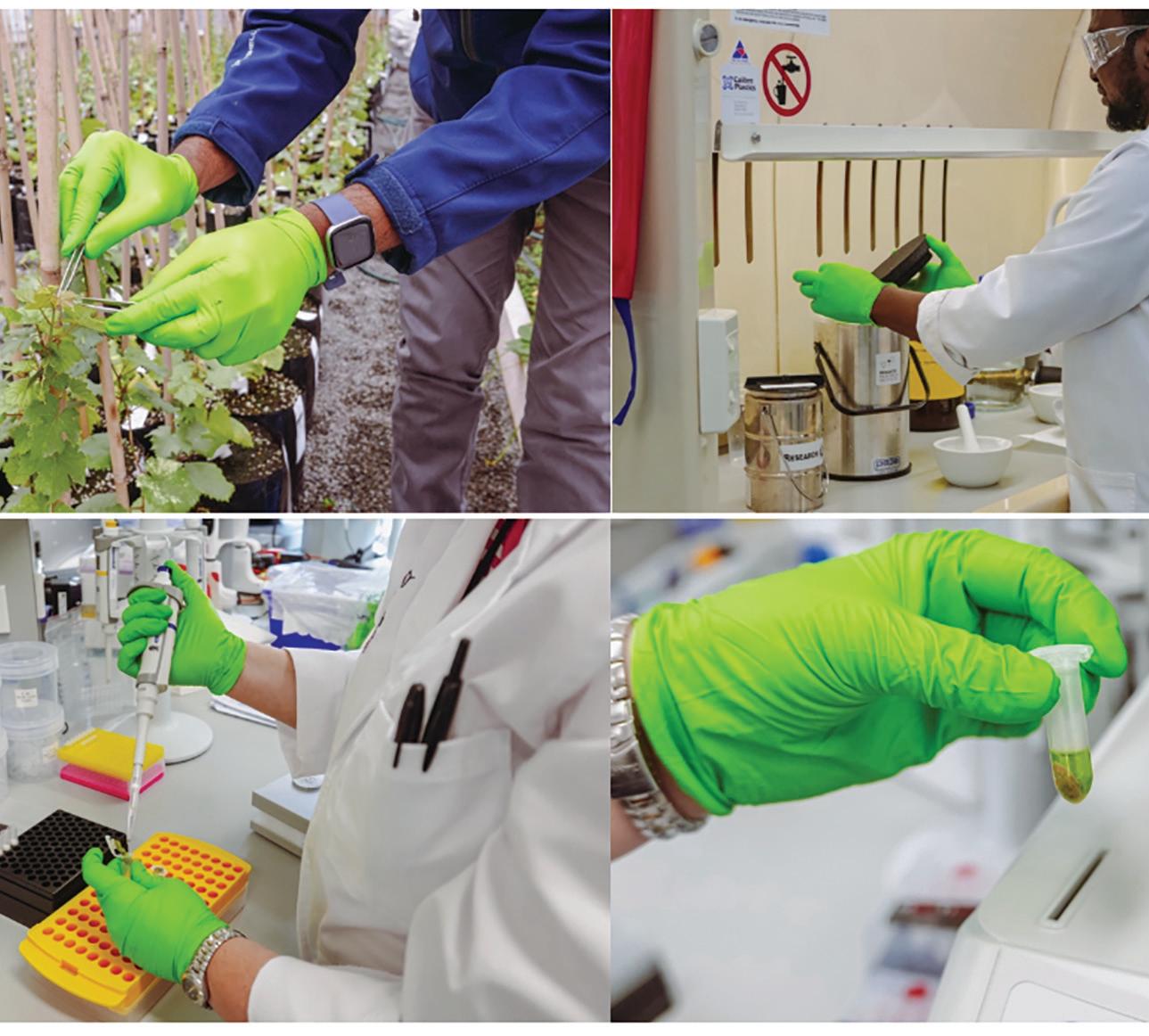
International input will continue in the coming year, with anticipated visits to BRI’s Lincoln University-based Grapevine Improvement Laboratory from Peter Cousins, head breeder at E&J Gallo Winery, and Professor Kai Voss-Fels from Geisenheim University. These engagements promise to deepen collaborative efforts and introduce recent international progress on genomic analysis and trait-based selection.
In parallel with these research advances, the programme is working to reduce any barriers to local industry engagement. The OddVine project focuses on the collection of clonal diversity from commercial vineyards and now benefits from seamless integration into Vure – widely used vineyard management software – so that growers can actively contribute to the programme’s findings.
Today it is challenging for wine-
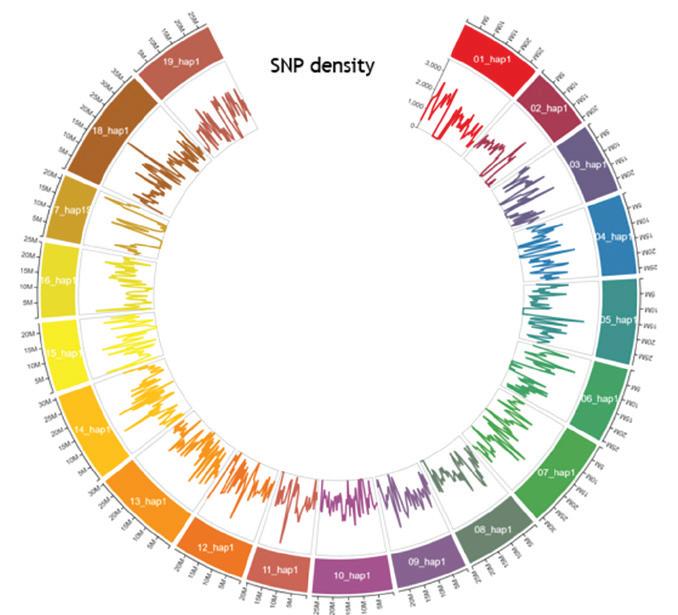
Figure 3: Variation between the two haplotypes (DNA inherited from different parents) in the Sauvignon Blanc genome. The above image shows the high degree of variability across each of the 19 chromosome pairs that make up the grapevine genome – including an estimated 5.65 million single nucleotide variants.
growers to fully understand the overlap between rapidly changing genetics technology and an evolving regulatory environment. The introduction of the Gene Technology Bill in New Zealand has sparked renewed discussions on how best to support innovation while preserving the sustainability,
premium reputation, and provenance that define New Zealand’s agricultural exports. BRI is leading efforts to clarify the implications of the new legislation for industry.
In the meantime, import permits have been obtained for disease-resistant hybrid seeds, and clarity on GMO legislation confirms that current workplans won’t be captured by GMO regulations. These regulatory updates support the immediate objectives of the programme while paving the way for a sustainable and innovative future for the New Zealand wine industry.
With the successful establishment of the selection vineyard and the integration of state-of-theart technologies like nanopore sequencing and the Blackbird robot, the programme now has the foundation in place for the next phase of evaluation and clonal selection. Over the coming months, the focus will be on expanding high-throughput genetic screening and refining trait-based assays, including the integration of automated assessments for mildew resistance.
Further enhancements in plant selection are expected to come from electronic vineyard data collection with the plant database, and exploring the use of AIdriven software for data analysis. Submissions of interesting plants in commercial vineyards can now be made via Vure, making it easier for growers to contribute to the growing plant collection. In the coming year there are also plans to continue strengthening international collaborations, ensuring that global best practices, expert knowledge and cutting-edge techniques continually guide the selection process.
Growers and industry stakeholders are encouraged to take full advantage


of new tools and engagement opportunities. With vines now in the ground, the Sauvignon Blanc 2.0 Programme is starting to work more directly with our industry partners, who contribute in-kind support – such as vineyard equipment and technical advice – and who will eventually provide grafting and trial sites.
Industry members can play a part by tagging interesting vines at oddVine.co.nz, keeping an eye on the quarterly update newsletter, and staying connected via BRI’s research reports. For more information or to join the conversation, please visit our website or contact the BRI team directly.
Many thanks to the following
grantors who have made exceptional contributions to the project: Delegat which contributed a tractor and mower; Indevin, Cloudy Bay, Delegat, Lion, Loveblock, Pernod Ricard Winemakers, Marisco, and ViNA whose staff have served on advisory committees.

The seven-year Sauvignon Blanc 2.0 Programme is a collaboration between Bragato Research Institute and its partners, Plant & Food Research and Lincoln University. It is designed to apply modern knowledge to establish more diversity in New Zealand Sauvignon Blanc vines and thereby make our industry more resilient.

Melanie Kah, Jon Dominic Habito and Nick Lewis, The University of Auckland
Nanotechnology is a broad area of science focussed on engineering matter at a very small scale. Nanoparticles have a size between 1 to 100 nanometres – a billion times smaller than a metre, and about 1,000 times smaller than the width of a hair.
The application of nanotechnology in agriculture is currently receiving substantial attention worldwide. The idea gaining the most traction is to exploit the novel properties of materials developed at the nanoscale
to design new and improved agrochemical treatments and ways of applying them.
Bragato Research Institute (BRI) funded a three-year research project, ‘Potential applications of nanotechnology for winegrowing in New Zealand’, aimed at analysing how nanotechnology can specifically benefit the wine industry, to help make viticulture more efficient and environmentally sustainable at the same time. The project concluded
in January 2025 and this article summarises its main findings.
The project began with a series of interviews with winegrowers and wine marketers to establish the level of interest in nanotechnology in the New Zealand wine industry and the market acceptability of nanotechnology.
Interviews with winegrowers also allowed us to identify priorities and possibilities for the technology in New Zealand – what challenges could it best help to address and where would we be best to put our efforts? The idea was to ensure that the research was industry-driven.
“The next steps will require formulating nanotech into a viable product.”
We then turned to the literature to discover what was known about the possible uses suggested to us by winegrowers and how we might refine and focus the research. The literature is still young, but rapidly growing. The review confirmed the potential of nanotechnology to address some of the most stubborn challenges currently faced by New Zealand winegrowers, and that we should focus our applied research on nanosulfur against powdery mildew.
The research explored the efficacy and environmental impacts of nanosulfur as an approach to tackling powdery mildew under both laboratory and field conditions. Jon Habito, a PhD student at The University of Auckland, conducted experiments comparing a range of sulfur nanoparticles (with different nanoparticle sizes and coatings) with sulfur formulations currently used in winegrowing.
The laboratory experiments demonstrated that nanosulfur can improve rainfastness on grapevine foliage and grape bunches. Rainfastness describes how much a pesticide sticks to the plant. The higher rainfastness of nanosulfur compared to commercial sulfur suggests that nanosulfur may protect
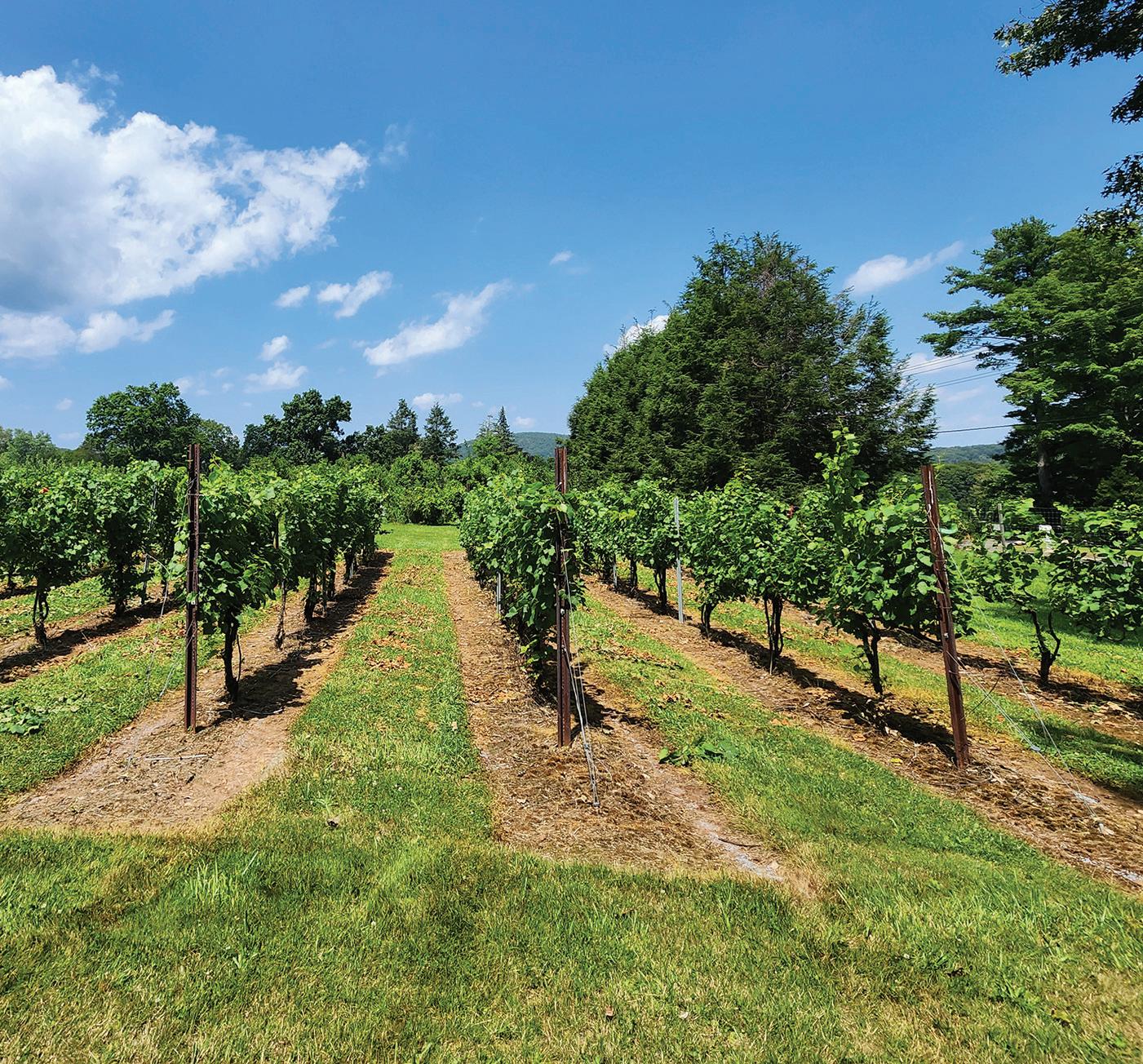
Field trial experimental plot
the wines for longer and/or at lower application rates. Nanosulfur was also shown to have low toxicity towards soil non-target organisms (earthworms), which suggests a low environmental impact, similar to conventional sulfur formulations.
The most exciting results undoubtedly come from the field trials that were conducted in an experimental vineyard of 56 mature grapevines (Vitis vinifera cv. Chardonnay, approximately 60 years old) in Connecticut, USA.
Jon worked alongside renowned nanotechnologists at the Connecticut Agricultural Experiment Station in the 2023 growing season.
The trials monitored the efficacy of nanosulfur against powdery mildew, while also investigating the risk of causing physiological stress or phytotoxicity in grapevines, the impact on fruit yield and enological properties of harvested grapes, and
the effect on nutrient content on the grapevines.
The 56-day field experiments demonstrated that nanosulfur can achieve similar results to conventional sulfur treatments, but at a ten-fold lower application rate. This promises to reduce costs and issues associated with residues.
Importantly, there were also no signs of detrimental effects of nanosulfur on overall grapevine health (oxidative stress or chlorophyll content), demonstrating that nanosulfur has low phytotoxicity. There were no differences in total fruit yield, number of bunches, or average weight per bunch.
The field trials demonstrated clear biological, environmental, and economic benefits. They showed nanosulfur to be a promising alternative to conventional sulfur in the control of powdery mildew in vineyards.
In terms of grape quality, juice extracted post-harvest from the grapes of nanosulfur-treated vines exhibited similar total soluble solids to those from sulfur-treated vines. This suggests that there is no impact of nanosulfur on sugar content in grape juice. We did, however, detect lower titratable acidity and slightly higher pH, indicating a potential influence on wine acidity and balance during the winemaking processes. These effects require further investigation, but may indicate interesting possibilities for winemakers.
This project was one of the first to assess the efficacy and effects of nanosulfur in an agricultural context. It is remarkable for its consideration of a wide range of endpoints (from fruit yield to molecular markers of toxicity). The project promises to be a keystone study for the potential application of nanotechnology in winegrowing.
This research is only the beginning for the use of nanotechnology in winemaking. Harnessing the full potential of nanotechnology in winegrowing will require more scientific research, investment in commercialisation, careful market analysis, promotion, and market preparation. This will take industry commitments.
The next steps will require formulating nanotech into a viable product (e.g. product that can be sprayed by practitioners and has an acceptable shelf life). This will require in turn research on its efficacy across a wider range of realistic conditions (e.g. different climates and cultivars), analysis of its economics, and investigation of regulatory aspects (including, for instance, systematic human and ecological risk assessment).


While we are still some way from a viable product, our results confirm the value of further investment in the science and application of nanotechnology in winegrowing as a basis for enhancing the productivity, profitability, and the sustainability of New Zealand wine environments, as
well as a marketable product in itself. We look forward to the opportunity to work with the New Zealand winegrowing industry and its science community on the next stage of the research process, which will require strong and trusted collaborations between science and industry.
This project was funded through the Ministry of Business, Innovation and Employment’s Research Institute Initiative, which aims to support and further enhance regional advantage in New Zealand by stimulating leading edge, industrially exploitable and commercially focused research.
Pinot Noir is known to be prone to mutation, allowing the production of numerous Pinot Noir clones. Since there are many clones available, winegrowers don’t have objective knowledge based on New Zealand conditions about which clones are best suited to their site or style of winemaking. Bragato Research Institute (BRI) collaborated with Riversun Nurseries and Otago Polytechnic to analyse 12 Pinot Noir clones grown at the same site in Central Otago. This trial aims to give growers and winemakers data about each clone so they can make informed planting or replanting decisions for their specific site or wine style.
The trial block
Otago Polytechnic and Riversun Nurseries planted a block on Bannockburn Road, Central Otago, in late 2017. The 12 Pinot Noir clones (Figure 1) were grown in the same soil conditions and on rootstock 3309. After several years of establishment, vineyard data was collected for seasons 2022-2024.
In 2024, the first season of winemaking was conducted at the BRI Research Winery. Twelve separate microvins were conducted in the
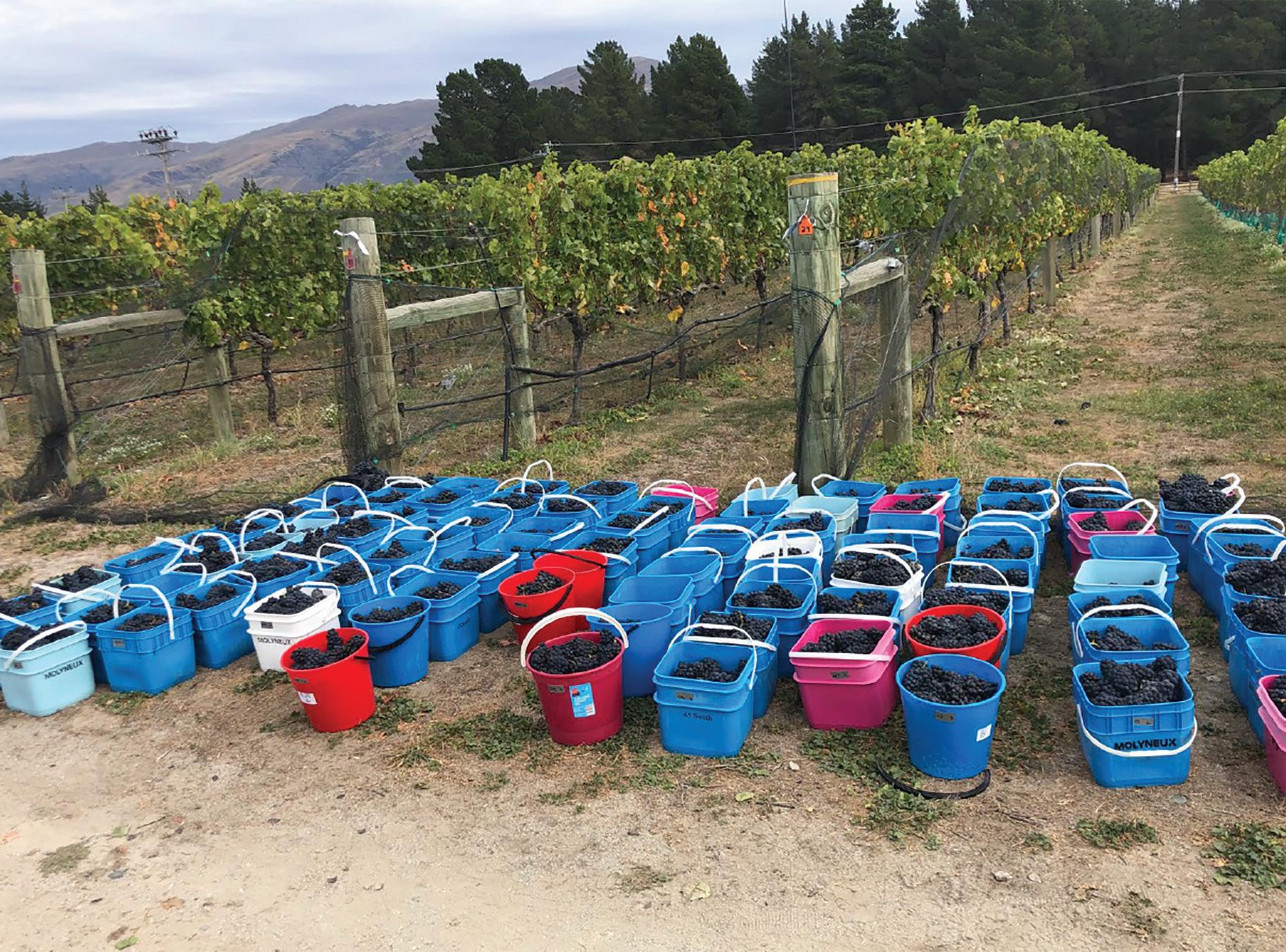
winery’s custom 17-litre tanks. Each wine was processed under the same conditions right through to bottling, and a variety of fermentation data, finished wine analysis and sensory scores were collected.
Twenty-four vines from each clone were planted in a randomised plot design. Data was collected
throughout the season for various measurement parameters, including canopy density, bunch size, berry weight, harvest yield, and ripening. The trial was harvested on 31 March 2024 and 25kg of each clone was delivered to BRI in Marlborough (Image 1).
Each clone had bunch and berry weight assessed, then was crushed
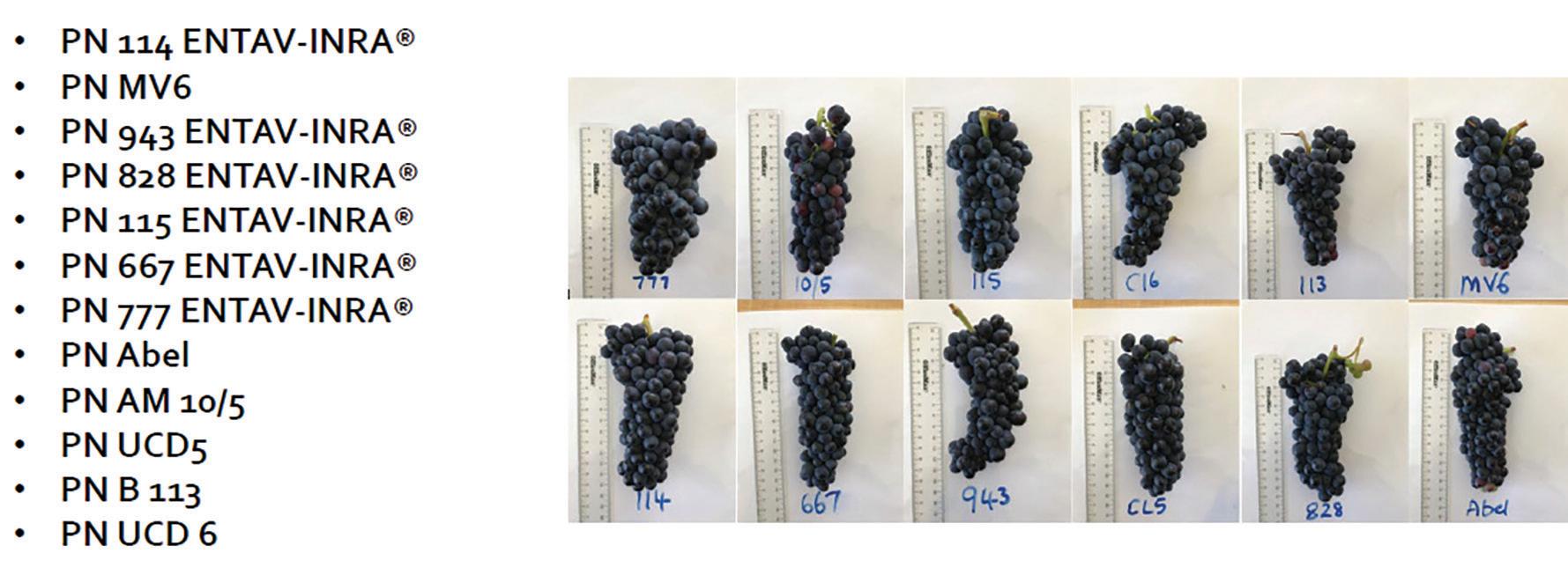

and destemmed and 16kg of fruit per clone fermented at 25C after a fiveday cold maceration period. Ferments were punched down daily and a drop in brix was measured daily. Data was collected on maturity parameters, fermentation kinetics, finished wine parameters, colour, phenolics, and volatile aroma chemistry.
Once the wines were finished, 10 winemakers with experience in making Pinot Noir wines assessed the wines blind and rated them on 22 attributes associated with Pinot Noir. This data was collated and statistically analysed.
The 12 clones varied significantly from each other regarding average bunch weight, with Clone Abel having the largest bunches and Clone 943 the smallest. This correlated to ripeness, with Abel having the lowest brix at harvest and Clone 943 the second ripest. Abel had the highest malic
acid content and Clone 943 the lowest.
Colour-wise, the results mirrored the above, with Abel one of the clones with a lower colour intensity and Clone 943 having the deepest intensity. Clone MV6, known to have thicker skins than other Pinot Noir clones, had the highest phenolic reading at 280nm (Figure 2). The clone with the lowest phenolic level was Abel, but Clone UCD 6 was perceived to have significantly lower levels of phenolics by the expert winemaker panel.
The expert wine panel found limited significant differences between the 12 clones, but Clone 943 rated significantly higher in colour intensity than other clones and it also rated significantly higher in overall complexity.
When picked on the same date, the clones showed significant variation
in bunch weight, phenological ripeness, colour and phenolic level, demonstrating the variation of different Pinot Noir clones’ performance in New Zealand. Data collection will continue over the coming seasons to build a picture of how each clone performs over different seasonal weather conditions. Although this trial is conducted in Central Otago, the data collected will be useful for decision making by growers and winemakers throughout New Zealand.
This project was funded by Bragato Research Institute, in conjunction with Riversun Nursery and Otago Polytechnic, and aimed to improve understanding of Pinot Noir planting material available within New Zealand.

REX4. NOW WITH ROBOSHIFT.
Landini REX4, powered by efficient Stage V, 75-112 HP, 2.9-litre, 4-cylinder, 16 valve turbo intercooler engines. Now available with RoboShift transmission, offering Smart APS (Auto Power Shifting).
Ergonomically designed “Smart Pilot” controls allow for adjustable shifting responsiveness. “Stop & Action” allows clutchless stopping of the vehicle. Boasting 5 different models and 4 specific versions, the new REX4
Category 4 cab range takes the Landini specialised segment to the next level.
Ask us about the Landini REX4 and let’s grow together.
